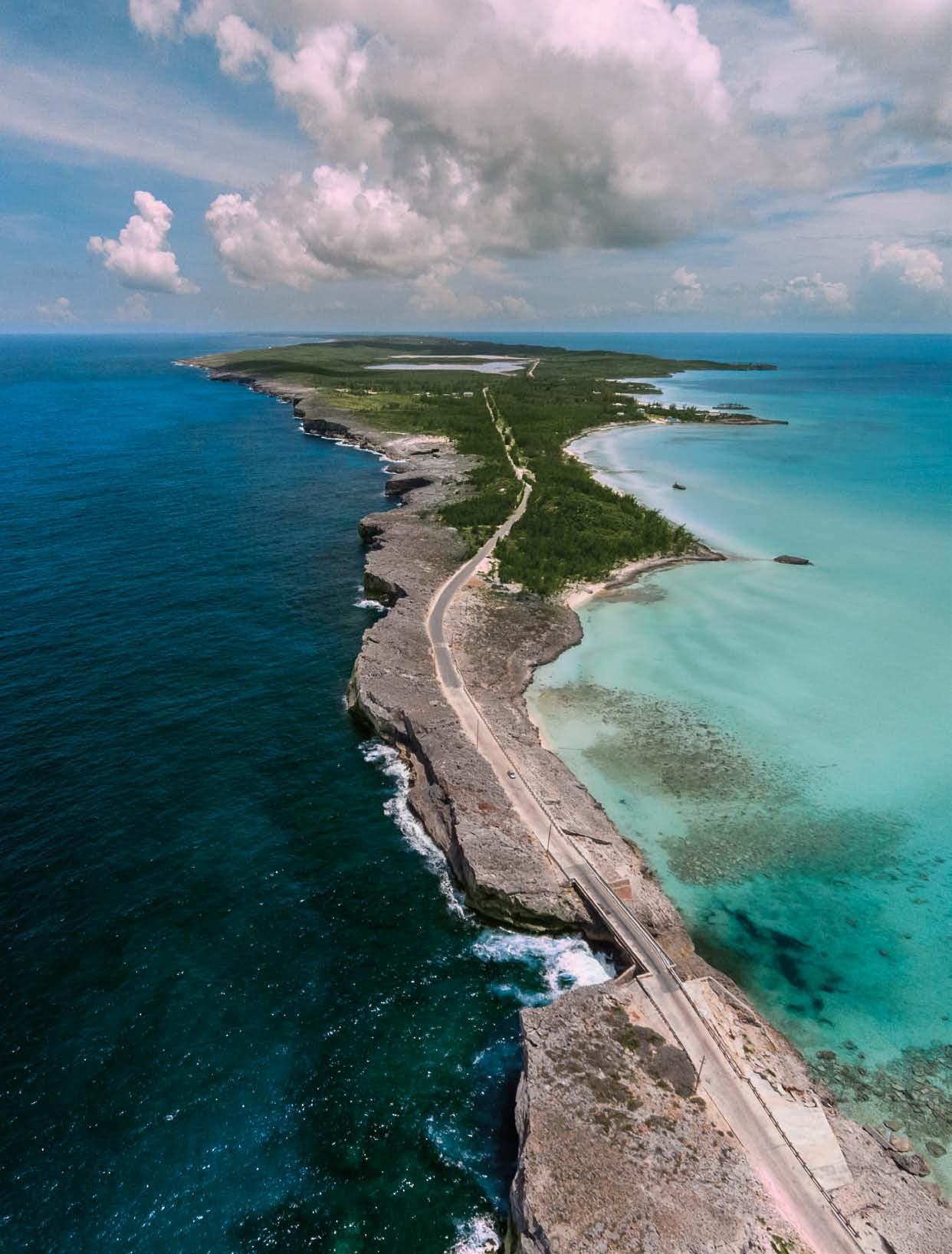




























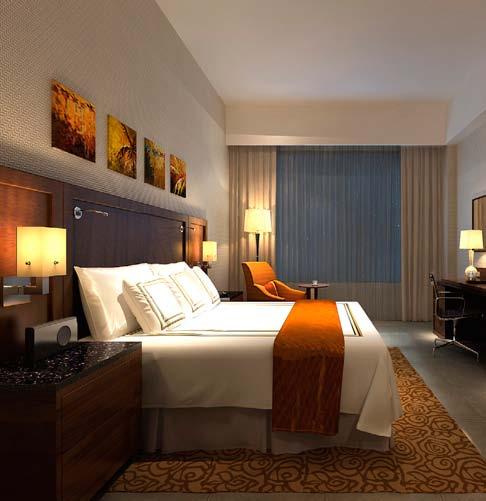
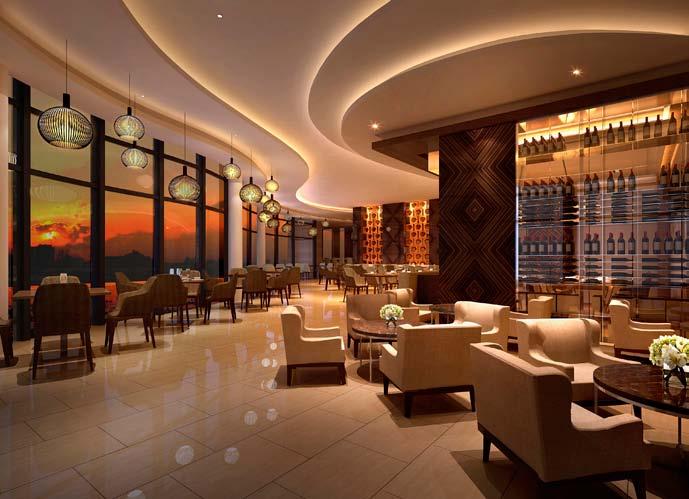
Experience the seamless combination of Georgetown’s historic architectural splendor and distinctive modern luxury at The Guyana Marriott Hotel Georgetown. Marvel at picturesque views of how the Demerara River meets the Atlantic Ocean and enjoy a charming welcome to nearby Georgetown’s central district with its various attractions and sites. Witness a breathtaking sunset by our pool bar and grill or re energize at our state-of-the-art fitness center.
Plan meetings effortlessly, with over 8,600 square feet of flexible meeting space. Whether hosting an intimate event for ten or a large-scale affair for 700, our Guyana Marriott Hotel Georgetown can easily accommodate your needs.
Book one of our 197 guest rooms or suites with views of the ocean or Georgetown’s city lights. Treat yourself to one of the best spots in Georgetown; full of light, full of life and full of energy, where you can work & play, mix, mingle, connect & relax. Travel Brilliantly.
MHRS.GEOMC.RESERVATIONS@MARRIOTTHOTELS.COM MARRIOTT.COM/GEOMC

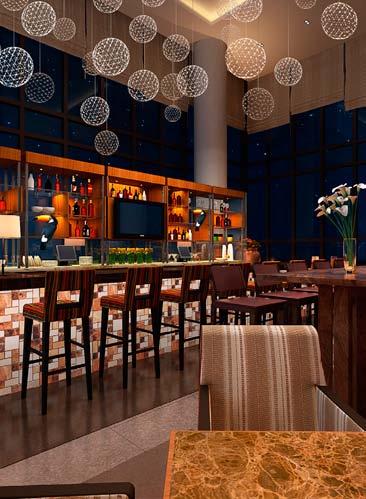

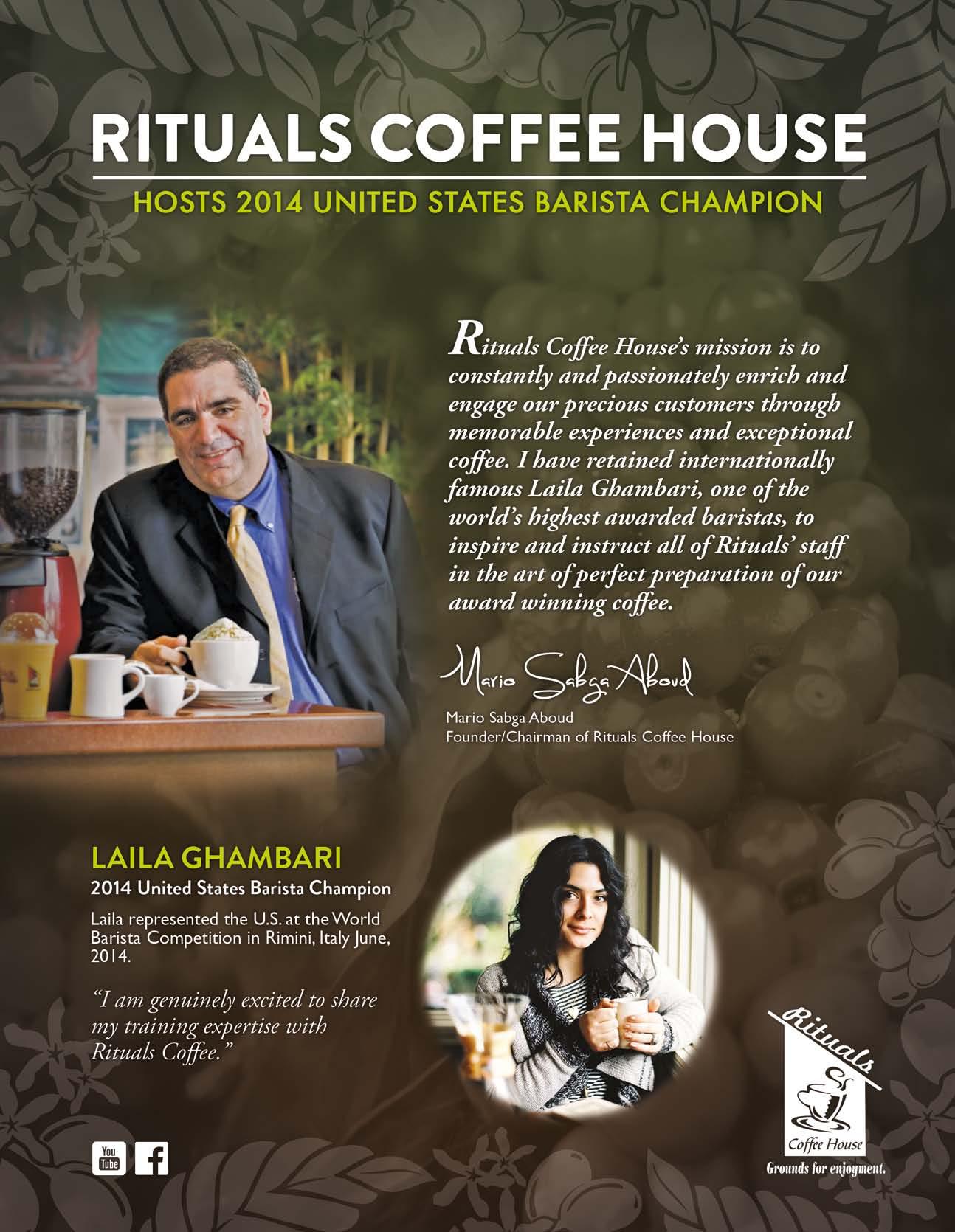
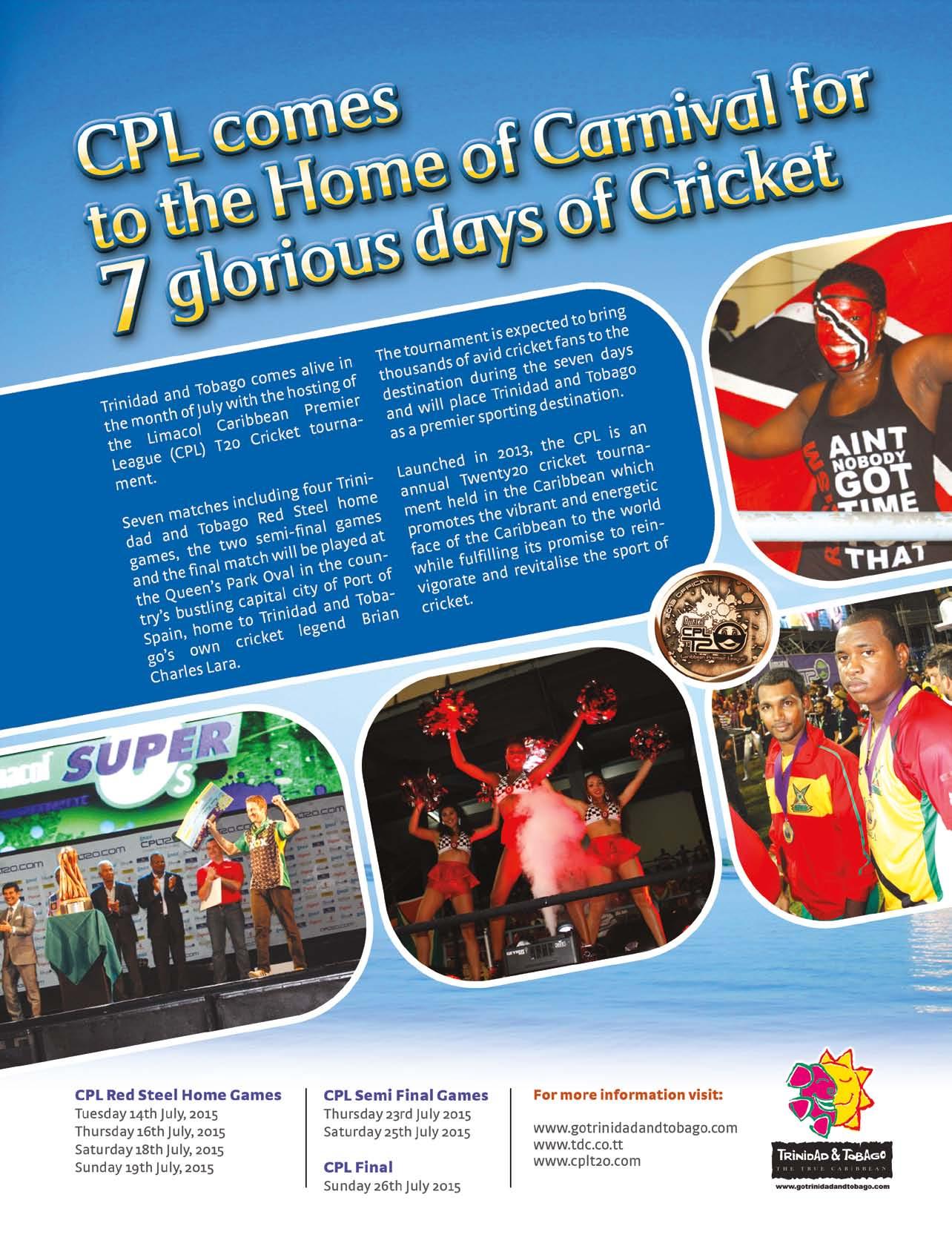










19 DAtEBooK
Events around the Caribbean in May and June — from the St Kitts Music Festival to the Tobago Legends football tournament
26 WoRD of Mouth
Tropical beauty at Dominica’s annual flower show, and going the distance at the Rainbow Cup Triathlon
30 thE looK
Barbadian designers Shayla Cox and Kimberley Angoy are ready for beach season
32 thE DEAl
What the new Extractive Industries Transparency Initiative means for Trinidad and Tobago’s economy
34 BooKshElf
This month’s reading picks, from poetry to art to cricket
36 PlAylist
New releases to get you in the groove
39 CooKuP
bright lights, big city, hot sauce
How did Bajan hot sauce end up on one of New York City’s trendiest restaurant menus? Jonathan Ali meets chef Paul Carmichael
No. 133 May/June 2015
42 PAnoRAMA ready for their closeup
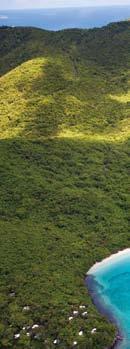
Caribbean actors have been lighting up Hollywood screens for decades — even if you don’t recognise their accents. Caroline taylor looks back at the first generation of Caribbean movie and TV stars, and profiles some of today’s headliners who can claim Caribbean roots
54 BACKstoRy dubbing is a must
In recent years, the Jamaican music scene has been gripped by a “Reggae Revival,” and the movement’s ground zero is a weekly gathering of musicians and fans high in the hills above Kingston. David Katz treks up to the Kingston Dub Club and meets founder DJ Gabre Selassie
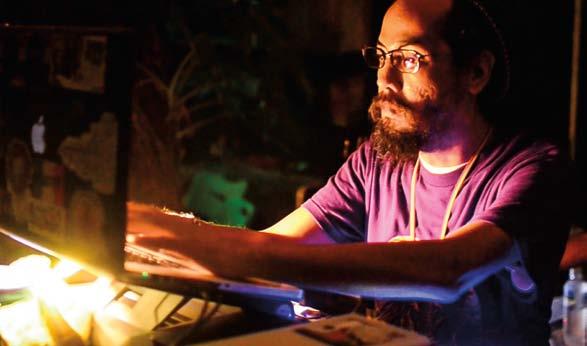
60 shoWCAsE
Two selections from the exciting new poetry anthology Coming Up Hot
62 snAPshot
the anti-expected
Selected for the prestigious 2015 Venice Biennale — the art world’s major international event — Bahamian Lavar Munroe creates mixed-media works that explore tricky ideas of “difference.” nicole smythe-Johnson finds out more
68 offtRACK
among the dragon’s mouths
The tiny islands scattered off Trinidad’s north-west peninsula, separated by the sea channels called the Bocas del Dragon, are beautiful and sometimes eerie outposts of history. Gasparee, Monos, Chacachacare, and the others have long been known as holiday retreats, writes sharon Millar, but their bays and hills also conceal a wealth of stories

76 nEighBouRhooD holetown, barbados
The oldest settlement in Barbados, founded in 1627, Holetown has history, a prime beachside location, and some of the island’s best dining and shopping
78 hoME gRounD the magic mountain
St John, smallest of the three main US Virgin Islands, is best known today as a vacation stomping ground for the rich and famous — “the Beverly Hills of the Caribbean.” But for David Knight, Jr, who grew up on its forested slopes, St John is a place of childhood mystery and family history, whose fragrant bay trees supported a once-famous industry long before the first tourists arrived
84 DisCoVER
another giant leap
When a three-year-old Camille Wardrop Alleyne watched the 1969 Moon landing on TV, she couldn’t have imagined she’d one day be part of the exploration of outer space. As a NASA scientist, she now helps run the International Space Station. And her second passion, as Erline Andrews discovers, is the campaign to get more young people — especially girls — into the fields of science, technology, engineering, and math
86 on this DAy out of many
Martin Luther King, Jr, visited Jamaica in 1965, at the height of his fame. He roused audiences there with his soaring speeches, James ferguson explains, but the newly independent nation inspired the Civil Rights hero just as indelibly
94 onBoARD EntERtAinMEnt
Movie and audio listings, to entertain you in the air
96 PARting shot
On the Bahamas’ Eleuthera Island, the Atlantic Ocean and the Caribbean Sea are separated by whisper-thin Glass Window Bridge
Media & Editorial Projects l td, 6 Prospect Avenue, Maraval, Port of s pain, trinidad and tobago
Tel: (868) 622 3821/5813/6138
Fax: (868) 628 0639
E-mail: info@meppublishers.com
Website: www.meppublishers.com
Business Development Manager
trinidad & tobago
Yuri Chin Choy
T: (868) 460 0068, 622 3821
F: (868) 628 0639
E: yuri@meppublishers.com Printed
An MEP publication
ISSN 1680–6158
Editor Nicholas Laughlin
g eneral manager Halcyon Salazar
o nline marketing Caroline Taylor
Design artists Kevon Webster & Bridget van Dongen
Business Development Manager
Caribbean & i nternational
Denise Chin
T: (868) 683 0832
F: (868) 628 0639
E: dchin@meppublishers.com
folloW us:
www.facebook/caribbeanbeat wwww.meppublishers.com
www.twitter.com/meppublishers
this is your personal, take-home copy of Caribbean Beat, free to all passengers on Caribbean Airlines
Caribbean Beat is published six times a year for Caribbean Airlines by Media & Editorial Projects Ltd. It is also available on subscription. Copyright © Caribbean Airlines 2015. All rights reserved. No part of this magazine may be reproduced in any form whatsoever without the written permission of the publisher. MEP accepts no responsibility for content supplied by our advertisers. The views of the advertisers are theirs and do not represent MEP in any way.
Website: www.caribbean-airlines.com

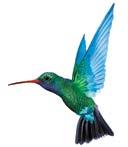

This issue’s contributors include:
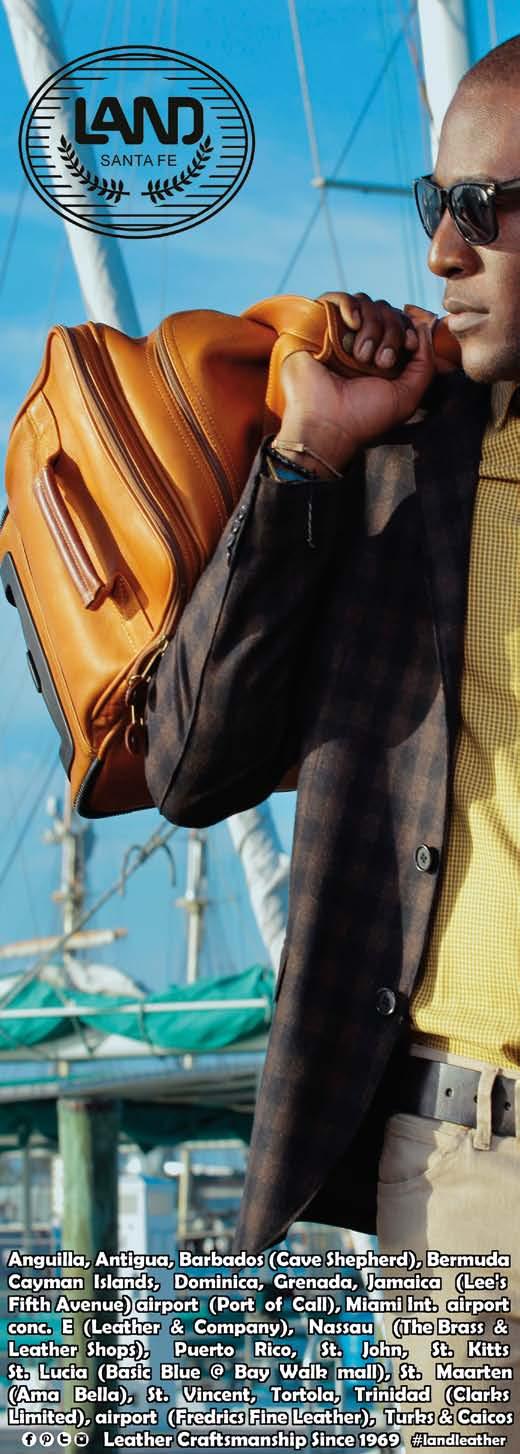
Erline Andrews (“Another giant leap”, page 84) is an award-winning Trinidadian journalist. Her work has appeared in publications in Trinidad and Tobago and the US, including the Chicago Tribune and the Christian Science Monitor magazine.
Paul Crask (“The flower ladies”, page 26) is a freelance writer and author of two Bradt Travel Guides: Dominica and Grenada, Carriacou & Petite Martinique

David Knight, Jr (“The magic mountain” page 78,) is a writer from the US Virgin Islands, and the co-founder and co-editor of the journal Moko. He is currently collaborating on an overview of art history in the Virgin Islands.
sharon Miller (“Among the Dragon’s Mouths”, page 68) is a Trinidadian writer. Her short fiction collection The Whale House was published in 2015. She is the winner of the 2013 Commonwealth Short Story Prize and the 2012 Small Axe Literary Competition for Fiction.
nazma Muller (“The transparency challenge”, page 32) is a Trinidad-born, Jamaica-obsessed writer who has worked in newsrooms in T&T, Jamaica, and the UK. She is also the editor of Discover Trinidad and Tobago 2015.
nicole smythe-Johnson (“The anti-expected” page 62) is a writer and independent curator, living in Kingston, Jamaica. She has written for ARC magazine, Jamaica Journal, and several other regional publications. She curated three exhibitions in 2014 (Transforming Spaces, Float, and Trajectories).
Trinidadian Caroline taylor (“Ready for their closeup” page 44) makes a living doing what she loves most: telling stories. That includes acting (and directing) in theatre, film, and TV productions, and writing and editing for both print and online publications.
Welcome aboard! In our last issue, I declared 2015 as the Year of the Caribbean, and we are excited to be the Official Airline Sponsor for the 2015 Caribbean Premier League T20. The CPL is the newest addition to the yearly cricket calendar, and it will be a spectacular event, drawing some of the most talented cricket players and fans to the beautiful islands of the Caribbean. And who better to get the teams and supporters around the Caribbean?
Moving teams and fans throughout the region for the sport of cricket allows us to continue to serve our customers. This partnership represents the best that the Caribbean has to offer, and it’s a natural fit for both our brands. The CPL logo has been branded on our aircraft, so look out for the vibrant image when you head to the games.
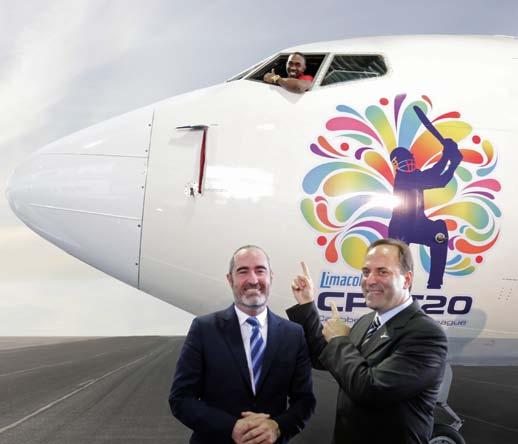
Caribbean Airlines will also participate in Caribbean Week, which will be held in New York from 1 to 7 June, 2015. This is another event which highlights the diversity and vibrancy of the authentic Caribbean, organised by the Caribbean Tourism Organisation. We have partnered with the CTO to promote the sights, sounds, colour, culture, and unique experiences of the Caribbean.
I take this opportunity to wish the Legacy sailing team success with the “Operation Southman” expedition. The locally built yacht branded with the Caribbean Airlines logo, led by Reginald Williams and his crew, will attempt to establish a new national elapsed time across the Atlantic. Team Legacy will compete in Cowes Sail Week on the south coast of England in August, which provides Caribbean Airlines with a captive UK and European travelling audience of 10,000 sailors and 200,000 visitors daily over eight days of racing.

Our connections are expanding. I am pleased to announce that we have signed a new interline agreement with Emirates Airline, the world’s largest international airline. In addition to easy transfers at key airports such as London’s Gatwick and New York’s John F. Kennedy, this agreement creates an opportunity to offer through fares from the extensive Emirates network over London and New
York to Port of Spain, Georgetown, Kingston, and Montego Bay. As the co-operative agreement unfolds this year, we look forward to exploring even more opportunities and reach to the huge Emirates Airline network beyond Dubai, covering over 100 cities.
Our multinational Caribbean workforce has been enhanced with the orientation of nineteen trainees from Metal Industries Company and the University of Trinidad and Tobago into our Maintenance and Engineering department, a complement to our employee base of nationals from Jamaica, Guyana, and Barbados.
Additionally, we have developed a new marketing plan to create a centre of aircraft maintenance and engineering excellence for airline customers worldwide who are seeking quality aircraft maintenance facility services for their respective heavy maintenance needs. Caribbean Airlines has been completing heavy maintenance C-checks in-house on its Boeing and ATR fleets.
Caribbean Airlines team members are readily available to attend to your needs, even before you arrive at the check-in counter. Our teams are busy behind the scenes, preparing for the upcoming summer period. Our commitment to your safety is unrelenting.
We remain truly committed to treating you to a great flight today, and every time you choose to fly with us. We understand that you have a choice, so we appreciate you sharing this special journey with us.
We want to hear from you — give us your feedback on your experience at feedback@caribbean-airlines.com
Have an enjoyable flight and we look forward to serving you again.
Michael de Lollo Chief Executive Officer
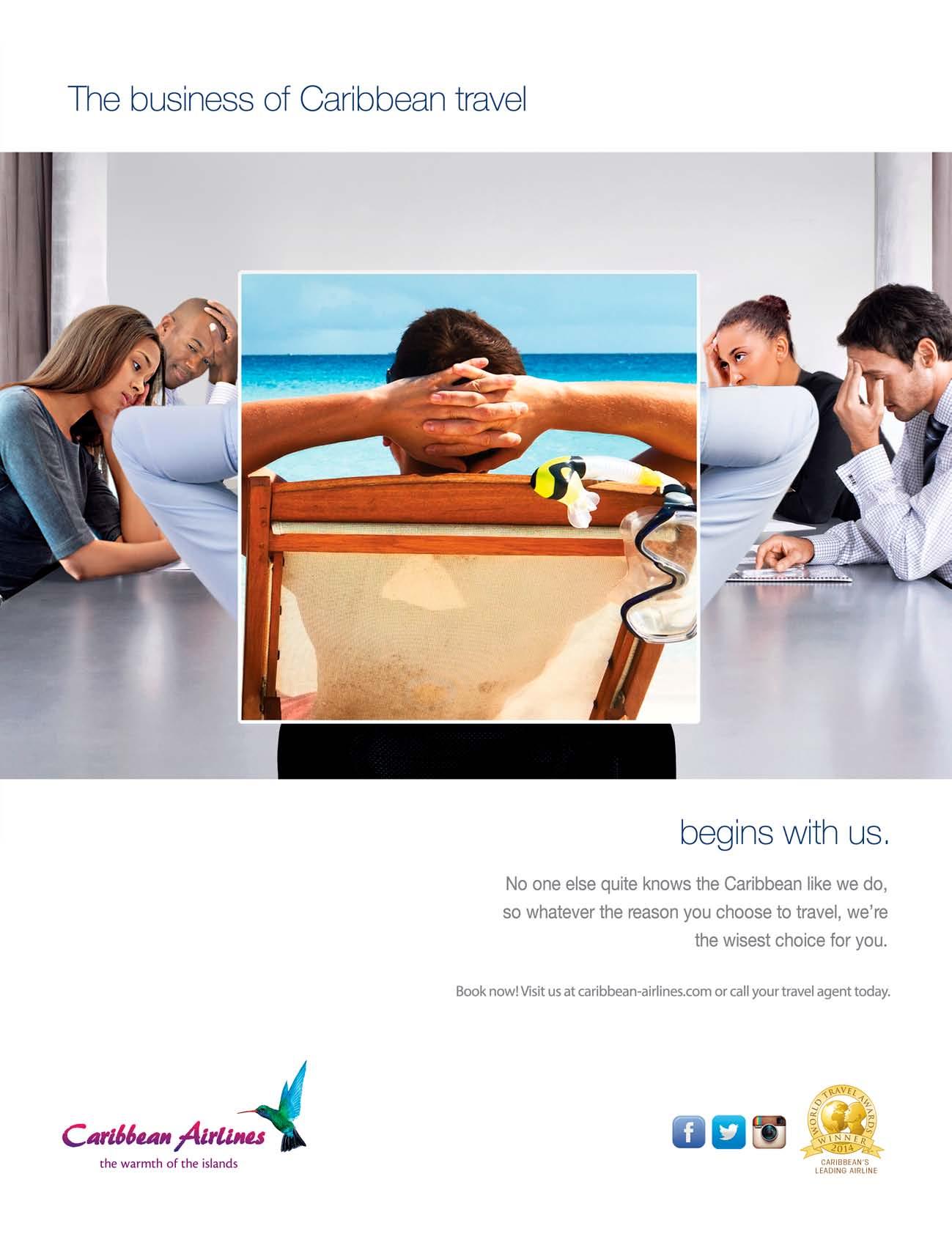

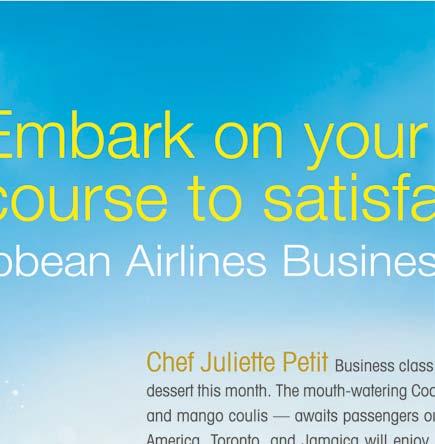


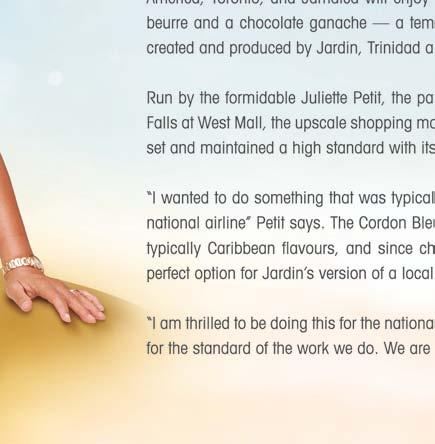




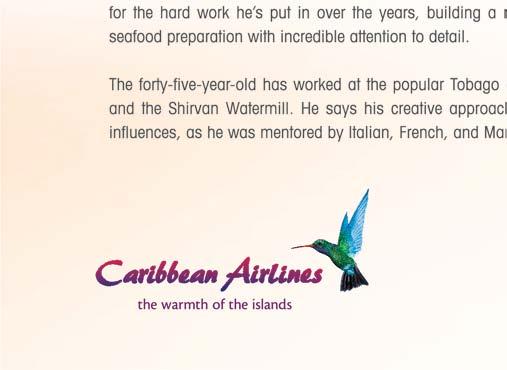
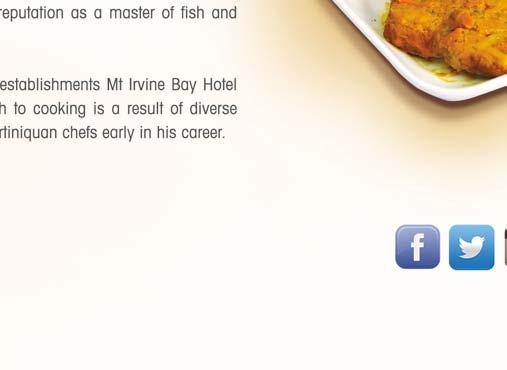

For Trinidadian businessman Joe Pires, home is definitely where his heart is. A “serial entrepreneur” by his own admission, he started his first business at age twenty-one, when he got the idea into his head that flavoured popcorn would be a bestseller, he would be the first to market. He launched his brand, Munchies Ltd, before realising he didn’t have enough capital. His father (Joe Pires, Sr., a successful self-made businessman himself) said no, “you want to start a business,” he told his son, “find the means to do it.” Every bank turned him down and Munchies Ltd never got off the ground, but the lesson was learned. Pires’s second business, Gardenland, which he opened when he was twenty-four, remained a successful venture until the day he closed it to take over the reins of Caribbean Chemicals, the company his father built from the ground up. He was then thirty years old.
He is still Managing Director of Caribbean Chemicals, which has expanded to Guyana, Suriname and Jamaica, and now also holds ownership or controlling interest in at least twenty-five other companies. “When I see a niche market that needs filling,” Pires says, “my first thought is ‘I can do that.’” And he usually does. Most of his businesses were born out of a need he himself experienced and couldn’t fill (at least not easily). His, was the first company to introduce the now-flourishing “skybox” business to facilitate online shopping, because he wanted to subscribe to a magazine that he couldn’t get in Trinidad. His business interests now range everywhere from boat building and communications, to nightclubs and
restaurants, and a host of others in-between. His personal mantra is “everything always works out for the best, even if it fails, so why not try.”
You might assume it would be difficult trying to reach such a person, and expect a fleet of staff to wade through on the way, but you’d be wrong. Pires is a literal “regular Joe’ — an open-necked shirt and sneakers are his office wear. All his staff call him by his first name and he’s accessible to them, his family, and his friends around the clock, no matter where in the world he is. His office door (when he happens to be in office) is always “open.”
Pires’s rigorous business schedule takes him from Trinidad and Tobago to the rest of the Caribbean, Miami, Latin America and South America, week in and week out. A CAL Boeing 737 is as familiar a mode of transport to him as his Land Rover — but he never wanted to live anywhere else but Trinidad. This is and will always be “home,” which he has invested a lot in. He plays as hard as he works and he plans his business trips to fall between Mondays and Thursdays, so that his weekends find him right here, in Trinidad with his people.
His favourite airport in the world is Piarco, because it’s “home.” Pires has many choices for air travel, but he chooses Caribbean Airlines, he says, “I genuinely find our people to be the friendliest of all when it comes to airline staff, as soon as I step in that lounge or on that plane, no matter where in the world I am, I feel like I’m already in my favourite place — home.”
We congratulate Joe for outstanding loyalty that truly goes the distance with us.
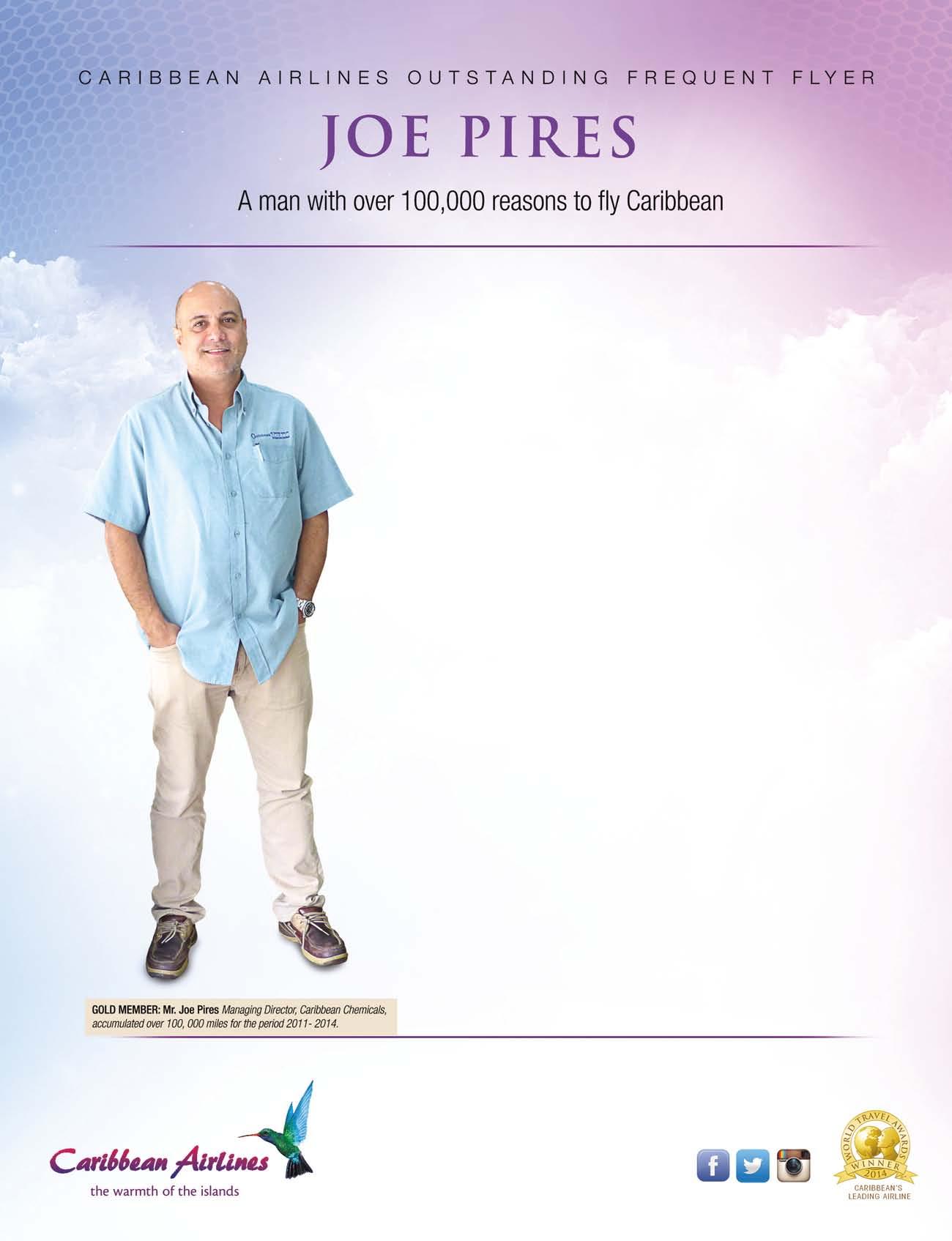
“I genuinely find our people to be the friendliest of all when it comes to airline staff, as soon as I step in that lounge or on that plane, no matter where in the world I am, I feel like I’m already in my favourite place — home.”
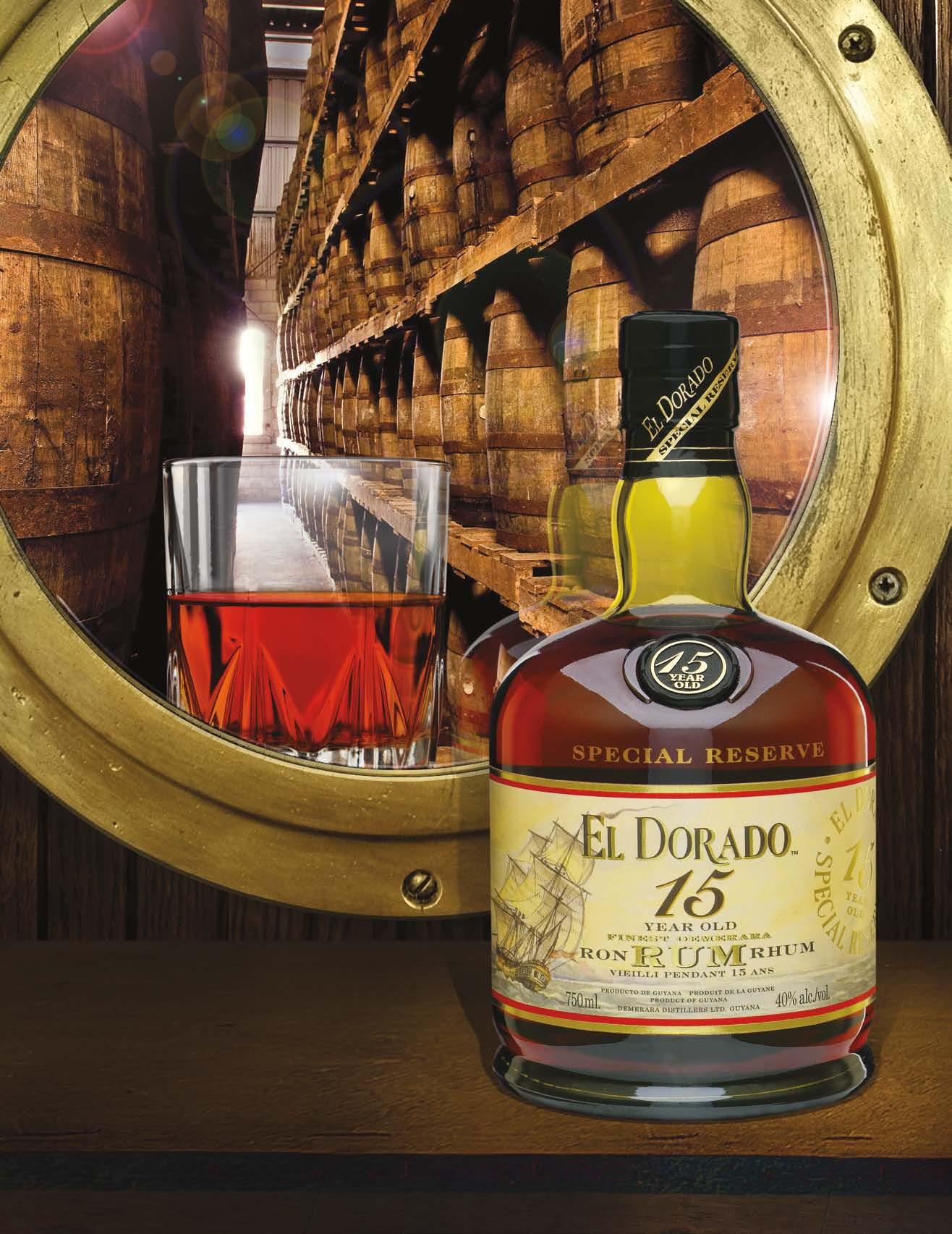
Your guide to Caribbean events in May and June, from Carnival in St Vincent to freediving in Bonaire

25 to 27 June • Warner Park Stadium
stkittsmusicfestival.net
The Caribbean’s cultural calendar is overflowing with music festivals, covering almost every musical style imaginable, from jazz and blues to reggae and dancehall, calypso to classical, salsa to zouk. But few have as eclectic a lineup as the St Kitts Music Festival, which turns nineteen this year. Since 1996, the festival has welcomed a galaxy of star regional and international artists — as diverse as Hugh
Masekela and David Rudder, Jimmy Cliff and Roberta Flack, Kenny Rogers and Busta Rhymes — and during the three days of the festival, the population of tiny St Kitts swells with visiting music fans.
How to get there? Caribbean Airlines operates regular flights to V.C. Bird International Airport in Antigua and Princess Juliana International Airport in Sint Maarten, with frequent connections to Robert L. Bradshaw International Airport in St Kitts
26 June to 7 July • venues around St Vincent carnivalsvg.com
The self-proclaimed “hottest Carnival in the Caribbean” runs for almost two weeks, from Fantastic Friday on 26 June — featuring the semi-finals of the national calypso competition — to Mardi Gras on Tuesday 7 July.

havana biennial
22 May to 22 June • venues around Havana bienalhabana.cult.cu
“Between the idea and the experience” — that’s the theme for the Twelfth Havana Biennial, the biggest and most prestigious art event in the Caribbean, and reliably the most controversial. With a focus on the Caribbean, Latin America, Africa, and Asia, the Biennial is arguably the most important international gathering of artists from the “global south,” and the recent relaxing of travel restrictions by the US government means an even larger contingent of star curators and gallerists from the “north” will descend on the Cuban capital this year, competing to spot the next round of major talent.
Along the way you’ll find all the events you’d expect from a Caribbean Carnival: soca, steel pan, J’Ouvert on Monday 6 July, and fetes galore.
“When we touch the road, we touch the road to party hard”: so said Vincentian soca star Gamal “Skinny Fabulous” Doyle in a Caribbean Beat interview last year. The former Vincy Mas soca monarch knows what he’s talking about. He’ll be a leading contender to reclaim the soca crown from 2014’s winner, Delroy “Fireman” Hooper, at the competition on Saturday 4 July, and whoever comes out on top, their songs are guaranteed to dominate the road on Carnival Monday and Tuesday.
Other key events in the Vincy Mas season:
Junior Carnival Parade
27 June
Junior Pan fest 28 June
steel and glitter (steelband competition finals)
Dimanche gras
2 July
5 July
Cuban artists will dominate the programme as usual. For the first time, there will be no central
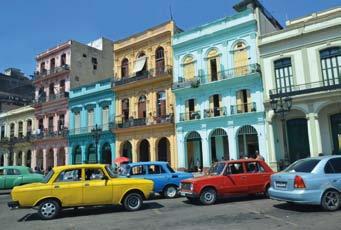

15 to 22 June • Dwight Yorke Stadium
Son-of-the-soil Dwight Yorke heads the squad of international football legends — including former stars from UK clubs like Manchester United, Chelsea, Arsenal, Tottenham, Liverpool, and Aston Villa — preparing to face off with
exhibition area, and artworks will be spread out across the city. Keep an eye out for other Caribbean talent, including Jamaican Ebony G. Patterson, Barbadian Ewan Atkinson, Puerto Rican Chemi Rosado, and Tirzo Martha and David Bade of Curaçao, among others. The gossip behind the scenes will almost certainly be about the fate of Tania Bruguera, the star Cuban artist detained and released by the Cuban government in January this year, after staging an unauthorised performance.
select teams from the Professional Footballers’ Association (PFA) and a Caribbean All Stars side, at the first-ever instalment of this new tournament. Sixty-four players have signed up, including Liverpool legend Stan Collymore, and former Chelsea teammates (and top club managers) Roberto Di Matteo and Gus Poyet. Eight top teams will compete in the Legends six-a-side tournament, which is expected to reignite old team rivalries among the legendary names competing in Tobago’s laid-back and scenic landscape. “It’s been a while since I had a chance to strut my stuff back in Tobago,” says Yorke, the Legends ambassador,” and we will try to bring the trophy home for all my fans around our beautiful island and the world.” Young Tobago talent will also have a chance to shine, as Legends players visit schools and sports clubs around the island. Is the next Dwight Yorke waiting to be discovered in Pembroke or Parlatuvier, Carnbee or Charlotteville?











Magdalena Grand, Tobago’s premier oceanfront resort, strives to provide our guests with the ultimate in service during their stay with us. We are now offering guests VIP concierge service from Trinidad’s airport to the short Tobago commuter flight. Guests will enjoy personal service and be able to relax knowing they have made their connection.


When you arrive at the resort you will enjoy a welcome beverage and another personal welcome from our resort staff. range
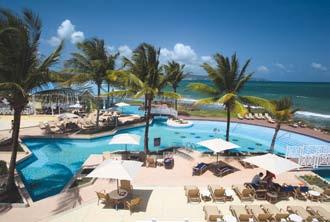

The Magdalena Grand Beach & Golf Resort has 178 deluxe oceanfront guest rooms and 22 suites, all featuring breathtaking ocean views from large private balconies and terraces. There are 3 oceanfront swimming pools, a PGA designed 18-hole golf course, tennis, a PADI 5-star dive center, spa services, guest activities, a kids club and a variety of excursions, as well as a wide range of dining options.

make the most of may
[30 April to 10 May]

St Lucia Jazz and Arts Festival Venues around st lucia stluciajazz.org
Jamaicans Jimmy Cliff and Chronnix join Guadeloupean jazz pianist Alain Jean-Marie and Barbadian band Krosfyah at St Lucia’s major annual music event
[2 to 3 May]
IAAF World Relays thomas A. Robinson national stadium, nassau bahamasworldrelays.org
The world’s best sprint athletes, from over fifty countries, gather for the biggest international tournament devoted solely to relays
COURTESY GRENADA CHOCOLATE FESTIVAL

[8 to 17 May]
Grenada Chocolate Fest true Blue Bay Resort and other venues chocolate.truebluebay.com
[22 to 25 May]
Terre de Blues
grand-Bourg, Mariegalante terredeblues.com
The sixteenth annual blues festival on Marie-Galante, south of Guadeloupe, features Guy Vadeleux, Vasti Jackson, Mayra Andrade, and disco/ R&B legends Sister Sledge

Anguilla Lit Fest Paradise Cove Resort
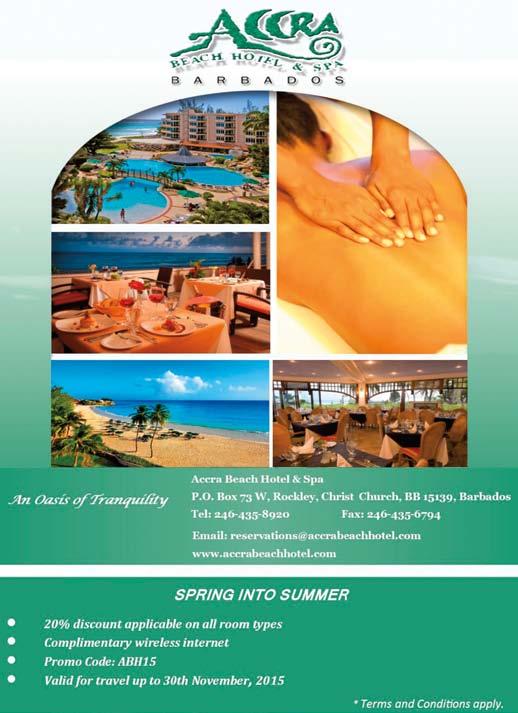
This “literary jollification” brings Caribbean and international writers together to read and debate against a background of tropical sea blue


[9 to 13 June]
Jamaica International Reggae Film Festival
island Village, ocho Rios
A whole festival of films devoted to Jamaican music? Look out for features, documentaries, animated shorts, and awards for the best in show
[5 to 9 June, 13 to 17 June]
West Indies vs Australia
Windsor Park, Dominica, and sabina Park, Jamaica windiescricket.com
The Australia cricket team’s tour of the West Indies includes just two Test matches — a prelude to the upcoming Caribbean Premiere League tournament

[11 to 14 June]
Charleston Carifest
Charleston, south Carolina charlestoncarifest.com
June — Caribbean-American Heritage Month in the US — brings celebrations of all kinds, including this Caribbean-style Carnival in one of the country’s oldest cities
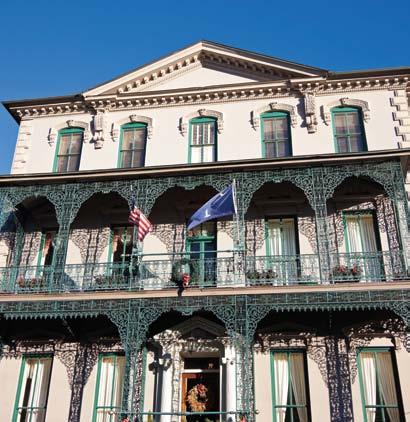
Blanchisseuse, trinidad
This Hindu observance, paying tribute to the Ganges and all the world’s rivers, reminds participants of their vital connection to nature
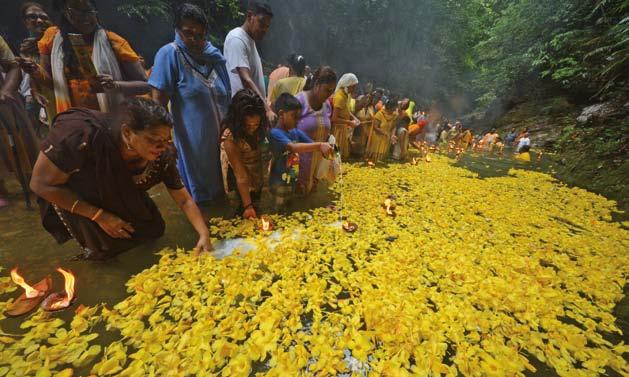
[17
Deepsea Challenge Bonaire
Plaza Beach Resort
Venezuelan freediving champ Carlos

Coste is the star attraction at this international competition for stronglunged divers. Will he break the world record again?
Experience international quality and service with a local flair at Guyana’s premier boutique hotel. Conveniently located minutes away from our capital city, Georgetown, Grand Coastal Hotel is the place to stay when travelling for business or pleasure.
Tel: 592-220-1091
Fax: 592-220-1498
www.grandcoastal.com reservations@grandcoastal.com
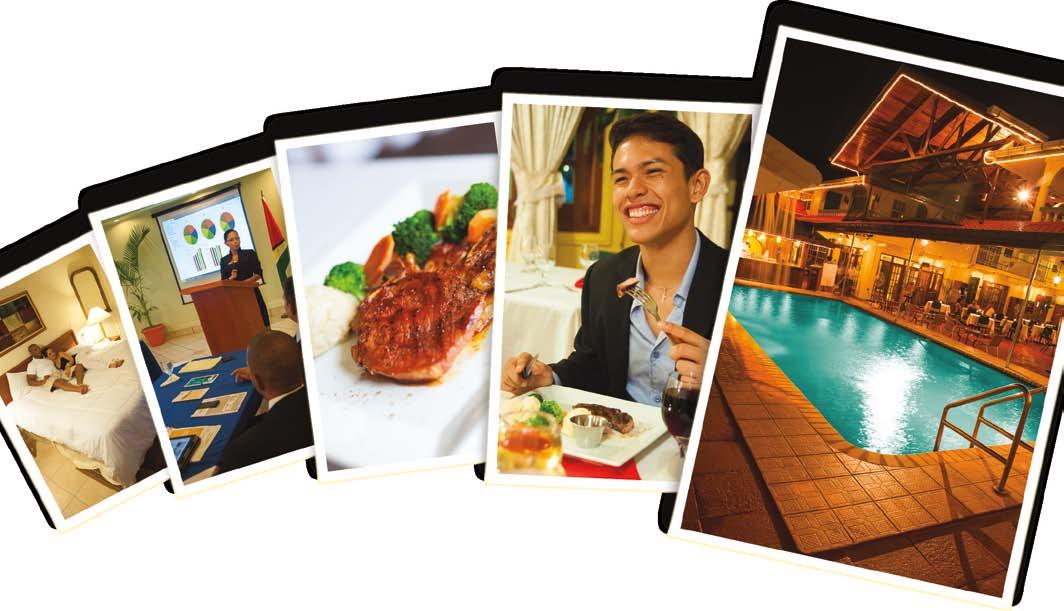
this year — are such time-consuming activities that she’s about ready to hang up her secateurs.

stephanie Royer tells me she can’t make it right to the top of her golden apple tree anymore, because she tends to come over a bit woozy. I feel rather light-headed just thinking about it. She’s seventy, though you’d never believe it as she strides effortlessly, machete in hand, up the steep muddy tracks of her terraced flower and vegetable plots, leaving me breathless in her wake. President of Dominica’s Giraudel and Eggleston Flower Growers Group for ten years, Stephanie cultivates flowers and sells arrangements for a living. Ambling around her elongated hillside garden of anthuriums, heliconias, ginger lilies, and rambling passionflowers, she says it’s high time someone else took charge. Organising fundraising events, overseeing enhancements to the Giraudel Flower House and Gardens, and putting on the annual Flower Show — which runs from 2 to 6 May
One contender for the role may be committee member Victoria Giraudel, whose one-acre cottage garden is bursting at the seams with sprays of colourful horticulture. Every inch, it seems, is inhabited by wildflowers, trees, and shrubs. A huddle of bottle plants catches my eye, and, as we stand chatting, they discharge their seed pods like corks popping from miniature Champagne bottles. Strolling between beds of pentas, azalea, agapanthus, and amaryllis, she pulls up occasional weeds from around celosia, fragrant tuberose, and star of Bethlehem. Begonias and caladium stretch long necks to the light, and salmon pink mussaenda blossoms, gloriosa lilies, and pandanus contribute to what is already a breathtaking backdrop of forestcovered mountain peaks and the Caribbean Sea.
This year’s flower show theme is “Love in Bloom,” Elizabeth Alfred informs me, as we meander the narrow pathways of her mature hillside garden. Like Stephanie and Victoria, Elizabeth and her sister Cybil are also members of the Flower Growers Group, and earn a living from the sale of cut flowers and arrangements. Operating on a much larger scale, their garden has also become a tourist attraction, and in the high season they host bus-loads of green-fingered cruise ship visitors. I tag along with a group who gawp wide-eyed at this visual feast and hang on Elizabeth’s every word, as she enchants them with snippets of homespun life in a Caribbean garden.
Giraudel and Eggleston are known by Nature Islanders as the “flower villages,” because they have supplied cut flower arrangements to both businesses and residents of Dominica’s capital, Roseau, for generations. Planted on the side of the Morne Anglais volcano, the villages look down on the town from a vertiginous height. The Flower Growers Group, born from a women-inagriculture movement, has few male members, though neighbours and nephews are all dragged into the fray in the frenetic weeks of preparations before the show opens. Stephanie, Victoria, Elizabeth, and Cybil coordinate activities, and despite the good intentions of early meetings, everything always happens at the last minute. It is customary this way, it seems, but miraculously it all gets finished in time for the pomp and protocol of the opening ceremony. Were it not for the love affair between the ladies and their delicate blooms, I wonder if any of this would ever endure. Indeed, the tremendous array of plants and flowers used for the show’s creative displays all come from the their own backyards. It’s a personal sacrifice that usually goes unnoticed and unmentioned.
“There should be more plants for sale this year,” Stephanie muses, as we share an old sofa on her porch, drinking sorrel and enjoying the sea view. “So we might be able to make a little money back this time.”
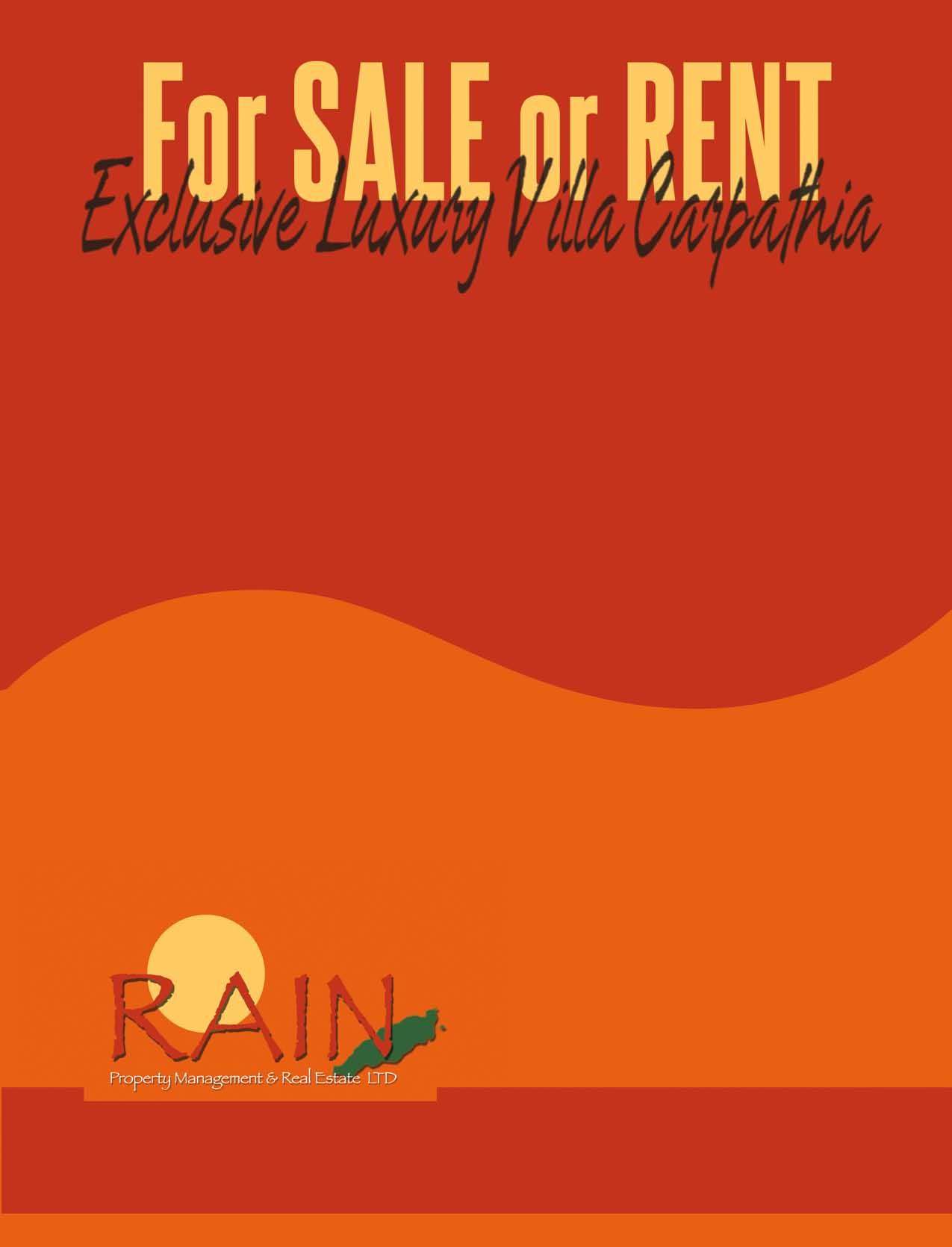


hhughh, hhughh . . . I gasp for air as I make my way through the run leg of the triathlon. I ask myself, why am I doing this again? No answer comes to mind as I contemplate the finish on this last leg of the race, broiling from within under the blazing Tobago sun. The only thing clear to me is that I must keep moving, must not give up, must cross the finish line.
In 2011, I joined the sport of triathlon, jumping in head-first with the Rainbow Warriors club. I was slow but determined, acquiring skill, “bad mind,” and flair. It was a welcome respite from the constant mental and emotional stress that came with completing a PhD thesis. I now had the opportunity to work my body in ways I had never done before. I knew I wouldn’t be competitive, being overweight and struggling to control cough-variant and exercise-induced asthma, but I didn’t care — I could now get out of my head, and enjoy the relaxed, fun, family atmosphere with just enough competitiveness mixed in to build motivation and excitement.
I was open to every event, and I didn’t mind coming in dead last — I was joyful at the finish. My first experience at the Rainbow Cup Olympic Distance Triathlon in Tobago was a moment of selfactualisation. Was I nervous? Oh, yes! But
the distance the sport of triathlon, with its run-swim-ride combination, is not the for faint-hearted. But Sue Ann Barratt discovers that even an asthmatic competitor can experience the thrill of victory — and the cheers of onlookers — at tobago’s Rainbow Cup race
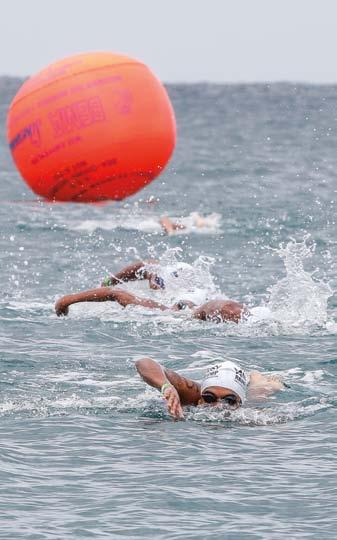
from the reception at the start to the afterparty, I knew I could do “me” in a space that facilitated any athlete, from the most competitive to determined participants like myself.
Then, the following year, I decided to up the ante. I knew that my lungs would not allow me to pick up the pace, but I also knew I had the strength to go longer. My past experience at Rainbow Cup had given me confidence and a zeal for battle. It was a battle indeed. Coming out of the sea for the second lap of the 1,500-metre swim, a little voice said, “just stop.” But then I heard my friends, family, teammates, even strangers, calling out. “Go Sue, go Sue!” they screamed. How could I stop with such encouragement, even when the beach was near-empty, as most of the other racers had gone ahead of me? I had to go on, if not for me then for those who supported me with such dedication.
I had to go on when I jumped on the bike for eight laps, legs trembling and already exhausted, and I heard leading athletes urging me on: “Just keep going,
you looking strong.” I just couldn’t quit when a male spectator told me on every lap that he was waiting for me, he wasn’t leaving until I was finished.
I gasped my way through the run leg — truly a walk for me, really — and I crossed that finish line, praising the Almighty for taking me through. With tears in my eyes, I didn’t care about cameras or a photo finish — I just felt my heart bursting, not so much from exertion, but with gratitude for the support I got along the way.
A lady came up to me at the end and told me she was impressed — a big woman like me in an unforgiving tri-suit facing the demons of body image, athletic challenge, and hot, hot sun. I thanked her, sitting cautiously to rest my aching body, and humbled by each person who passed and congratulated me. Then I found the energy to party the night away with a group of people who were living life on their own terms, and loving doing it. Once again Rainbow Cup was a true mind-body experience: the place, the people, the vibe, calling my name, forever urging me to “Go Sue, go!”
The 2015 Rainbow Cup Olympic Distance Triathlon takes place on 13 June at the Turtle Beach Heritage Park in Tobago. For more information, visit www.rainbowcuptobago.com
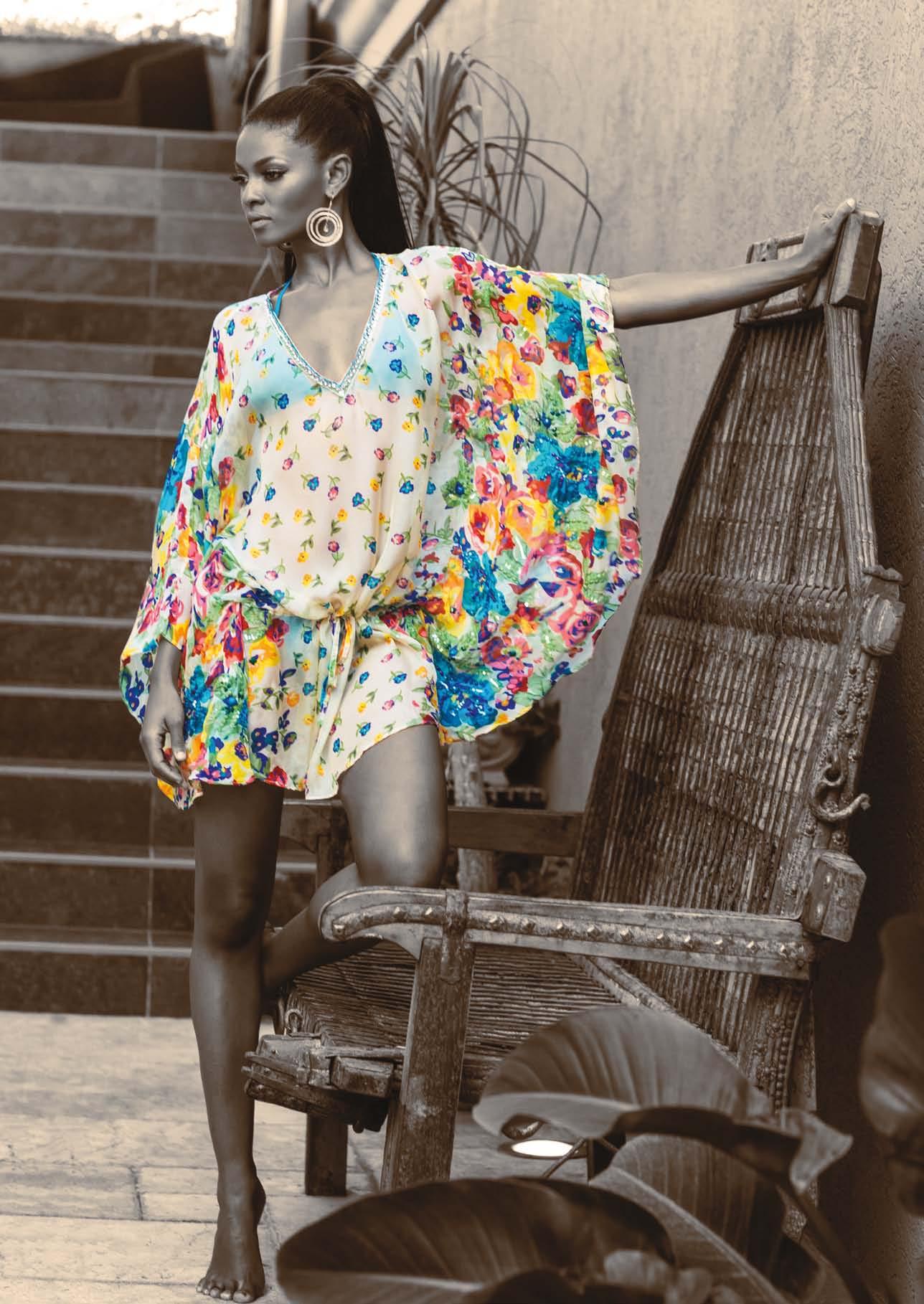
With “summer” right around the corner, now is the perfect time to hone your style for vacation days ahead. And designers Shayla Cox and Kimberley Angoy both provide collections — of jewellery and swimwear, respectively — that will stand out on any beach.

“I was experiencing a rebirth, mentally and spiritually,” says Cox of her transition from fashion merchandising to jewellery design. Originally from Ohio, this New Yorker’s journey began while working at a ceramic studio, where she learned the craft that would later become the basis of her architecturally beautiful jewellery line. She describes her work as a “quiet rebellion,” and explains that part of her self-discovery as a designer
stems from her family’s history, which includes her grandmother’s origins in Barbados. No piece is the same, which makes everything she designs absolutely worth having.


Savannah College of Art and Design alumna Kimberley Angoy also recently made a shift in career, from interior design to creating the swimwear line Suga Apple Swim. Her collection is the first among Caribbean designers to successfully master the Brazilian cut suit, and her love for bright colours, prints, and textures is infused throughout. Each suit has a unique detail that makes it fun and flirty. And up next? A line of fitness wear.
Alia Michèle Orane style.aliamichele.com
For more information on Shayla Cox’s pieces, visit shaylacox.com or email info@shaylacox.com


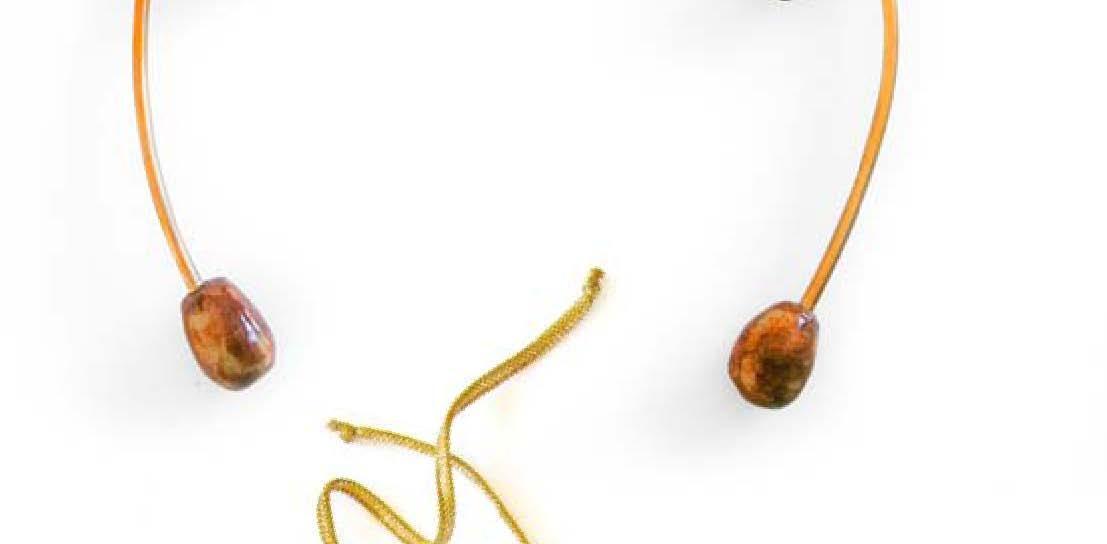
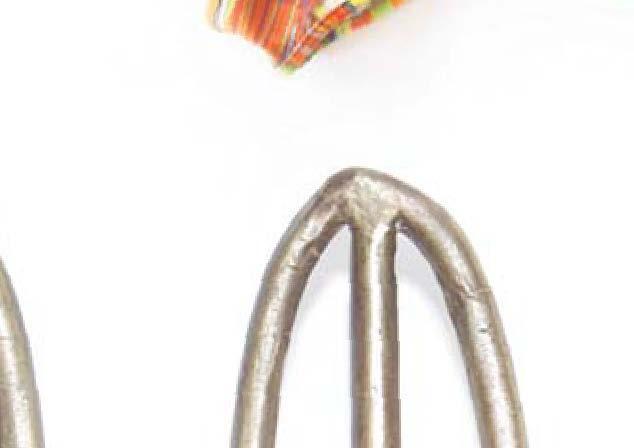




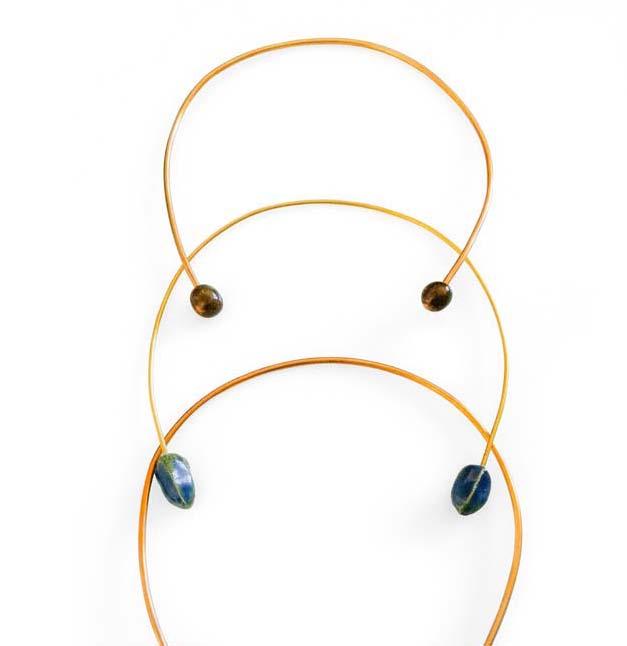
Suga Apple swimsuits can be purchased directly from the designer — contact her at sugaappleswim@gmail.com
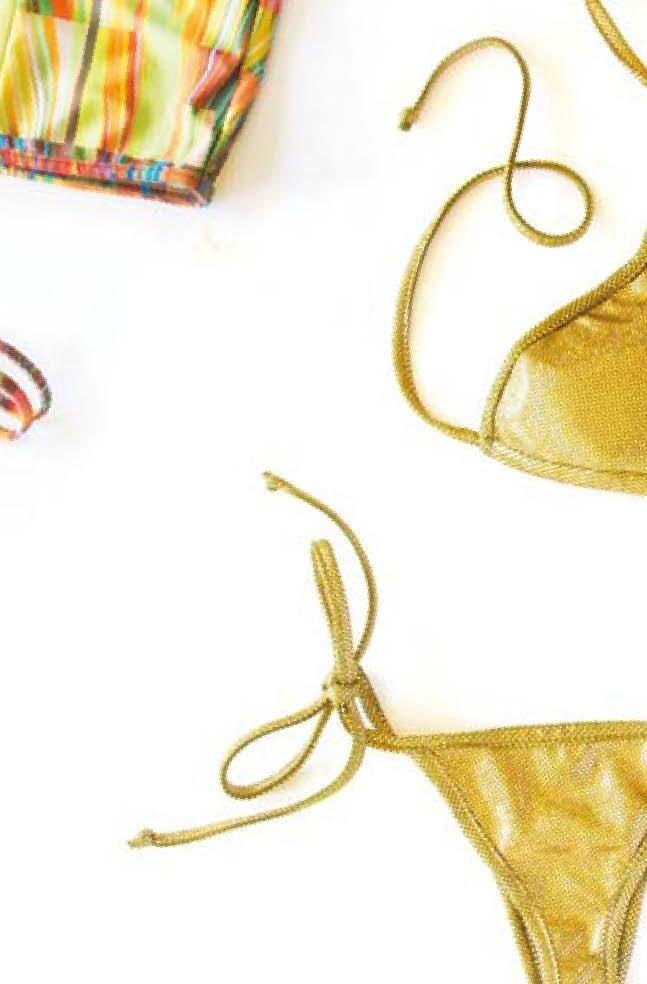



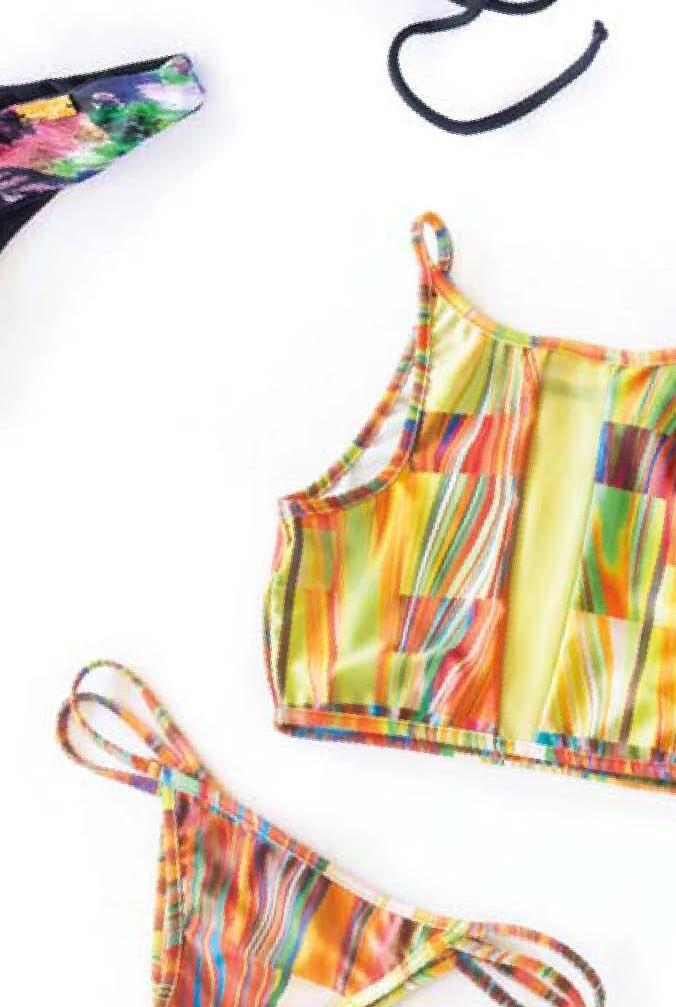


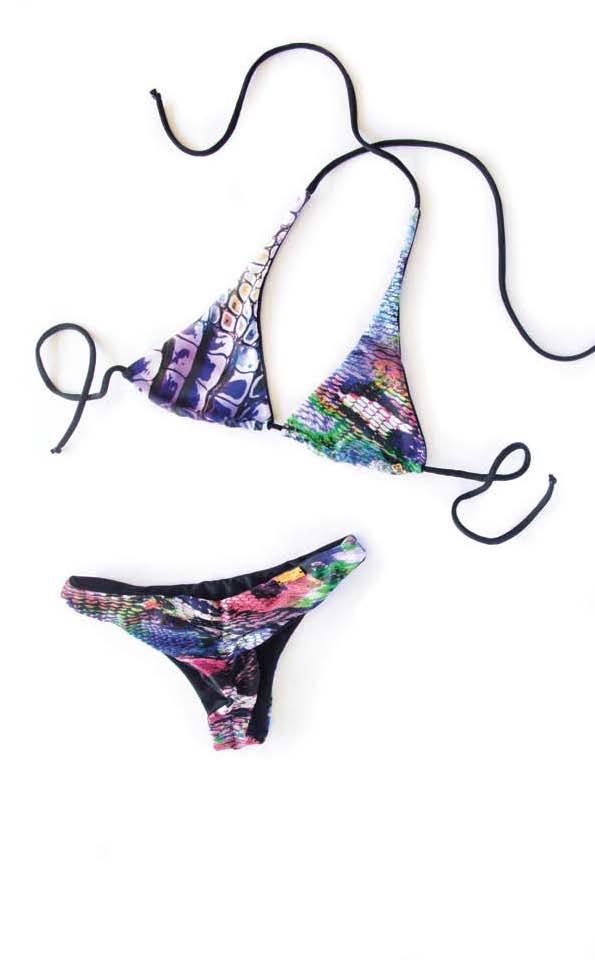

oil and natural gas are the backbone of the trinidad and tobago economy — but how can citizens be sure the national petro-income is being accounted for and spent ethically?
THEthe new Extractive industries transparency initiative is a step in the right direction, reports Nazma
mullerIn a country where allegations of corruption are made almost every week, the Trinidad and Tobago Extractive Industries Transparency Initiative (TTEITI) stands as a beacon of hope in the fight-back against white-collar criminals. T&T, the largest oil and natural gas producer in the Caribbean, has been involved in the petroleum sector for over a hundred years, and total receipts from these sectors accounted for TT$21 billion (uS$3 billion) — about forty per cent of GDP and eighty per cent of exports — in 2012, according to the TTEITI.
Oil and gas power T&T’s economy in more ways than one — the country’s natural gas is used to fuel eleven ammonia plants and seven methanol plants — and their annual output makes the twin-island republic the world’s largest exporter of ammonia and the second largest exporter of methanol. The Point Lisas Industrial Complex in Couva, central Trinidad, houses one of the largest natural gas–processing facilities in the Western Hemisphere, Phoenix Park Gas Processors Limited (PPGPL), as well as a subsidiary of PCS Nitrogen, the world’s largest fertiliser company.
The EITI is a global venture that
asks companies involved in extracting a country’s natural resources to voluntarily disclose the payments they have made to the government — which, in turn, declares how much it has received from the companies. An independent auditor then reconciles these receipts and the verified data is published in an annual report.
Forty-eight countries now belong to the EITI, and T&T, which has been a candidate since 2011, finally met the set standards and was given countrycompliant status last January — the first country in the Caribbean. The importance of the TTEITI was thrown into sharp focus within a month of T&T attaining country-compliant status, when
allegations of financial impropriety and mismanagement hit the oil company Petrotrin and the National Gas Company simultaneously.


The first the world heard of the EITI was from Tony Blair, former prime minister of the united Kingdom, when he announced its intended formation at a 2002 conference on sustainable development in South Africa. A formal launch was planned at the first EITI Plenary Conference in London, the following year, where T&T publicly announced its commitment to the initiative. However, when the first fifteen countries were admitted to EITI membership in November 2007, T&T was not among them. It was not until September 2010 that the country set up a tripartite steering committee, comprising eighteen representatives of the state, the private sector, and civil society (six each).
In March 2011, T&T became a member of EITI, but it took the country four years of intensive work to gain compliant country status. The TTEITI secretariat, which is housed at the headquarters of the Ministry of Energy and Energy Affairs, came in for high praise from Clare Short, chair of EITI, when she made the announcement at the Energy Chamber’s Trinidad and Tobago Energy Conference in January 2015. “The EITI puts information about the energy sector in the public domain so that analysts, academics, the media, and the public are more informed,” she said. “Trinidad and Tobago is now a regional leader and is expected to carry the mantle. However, you must maintain the standards you have now set.”
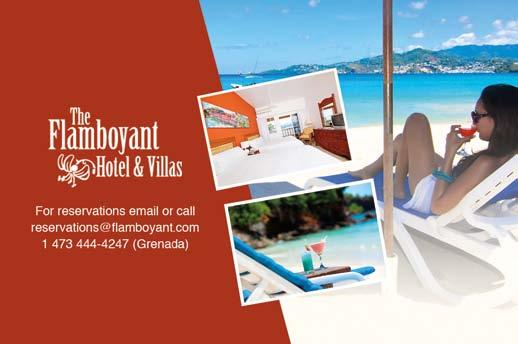
Solomon Ioannou, the European union’s programme officer in the Sector Policy Support Programme to the environment sector in T&T (the Eu is a donor to the TTEITI), is impressed by how quickly the country achieved compliant status, and praised the steering committee for their hard work and commitment. “Future possible enlargement of this initiative,” he said, “could include the mining sector, among others.”
The E u aims at “greening” the EITI in T&T by incorporating environmental aspects into its scope. As it is, illegal quarrying of soil aggregates in the Northern Range of Trinidad has had a devastating effect on the landscape and ecology of the sites. Dr Mark Thomas, CEO of the Cropper Foundation, one of the civil society representatives on the steering committee of the TTEITI, warns that “Trinidad and Tobago is second in the world in terms of per capita greenhouse gas emissions, meaning that the country and its energy sector make an unusually high contribution to global climate change. This will come back to bite us, because, as small islands, we are really vulnerable to the effects of climate change, like sea level rise and more intense dry seasons.
“The poorly regulated mining sector also creates huge environmental problems by removing forests, silting rivers, and so on. So, while financial transparency in our extractive industries is good, it cannot be the only thing. We can only solve the environmental problems caused by our extractive industries if we know the sizes of those problems, and this will be achieved only when there is environmental transparency as well.” n
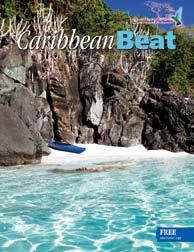
The narrator in one of St Lucian Vladimir Lucien’s poems stoically avows, “I can close my mouth over opinions screeching like chalk. I can cut the dread talk and learn how to peck past the breadline.” We can be grateful that the poet himself swears no allegiance to these commandments — instead, the whole of Sounding Ground , Lucien’s debut collection, affirms a steady eye, and a poetic register intent on cataloguing the whole: whether it be life within an island, or the worlds within both beloved and distant figures.
It is not indebtedness that whispers in between the lines of Lucien’s symbolic mapmaking, but a sense of ancestry, a certain fealty to cultural bloodlines that have bloomed and taken root within our region. Some of these are overt and outstanding: “Black Light”, a praise and remembrance poem for Walter Rodney’s industry of resistance, is immediately followed by a meditation at the grave of
The Sea Grape Tree, by Gillian Royes (Atria Books, 368 pp, ISBN 9781476762388)
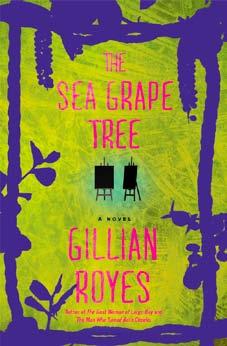
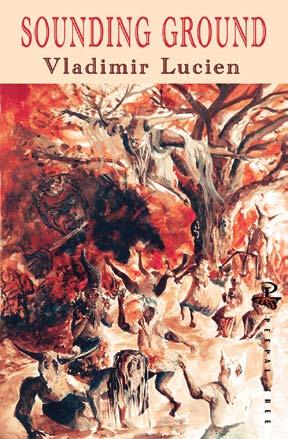
“You’d never think Jamaica was once British,” writes a reclusive painter, in the early chapters of Gillian Royes’s third Shadrack Meyers novel. Her email back home continues, “It has a character all its own. It’s loud, crude, beautiful, and utterly unpredictable.” In the artist’s bewildered musings lie the distilled ambitions of Royes’s entire Shad series: to portray Jamaica and its people as real, non-commercial entities, and to render the island in all its outrageous splendour. This she achieves through her central character of multiplying narrative delights, Shad himself. An unsuspecting Jamaican proletariat Sherlock, Shad’s personal woes are by turns gently humorous (witness his prolonged dread over tying the knot with Beth, already his beloved wife in all but legal decree) and reflective of society’s larger malaises. Through this plucky, resourceful everyman of a hero, the novel glows optimistically, while refusing to peer at Jamaica from the glossy pages of a travelogue.
C.L.R. James. Other poems declare the subjects of their twinned worship and critical focus more subtly, identifying them as intimate luminaries whose valours can be sung from the dinner table as well as on a podium. Among these are the father in “A Picture”, who “use to wear an afro in the 70s — black champagne on his head . . . his eyes averted from the dark-dark Ages, from the bad breath of History yellow pages.” Lucien breathes life into the fears and strengths of mothers who suffer lamentations for the loss of their children’s faith, who wait into the long nights for their wayward sons to strike a path back home.
What moves most about this collection is its lack of apologies over linguistic authenticity. Lucien’s poems straddle English and French Patois, delivering in well-studied turns the rhythms and realities of a St Lucia that is both proud island and a whole world unto those who know it best.
See me here: A Survey of Contemporary Self-Portraits from the Caribbean, edited by Melanie Archer and Mariel Brown (Robert & Christopher Publishers, 224 pp, ISBN 9789769534476)
Whether an assembly of lies, or a chorus of truths transmuted onto canvas, the art of the self-portrait is revelatory, even (or perhaps especially) when it conceals. In See Me Here, twenty-five Caribbean visual artists present themselves — in stasis, in blurred kinetic motion, in full regalia and perhaps, above all, inconsistently — for their own selfperception as much as the audience’s. The vision of co-editors Archer and Brown suggests that in this inconsistency, a ledger of the body in Caribbean space is allowed to emerge. From the fabric and paint of Annalee Davis’s Creole Madonnas , to the wire, paper, and fabric of Susan Dayal’s Costumed Series, these personal embodiments evoke the provocative tussle with the polemical, and show whole worlds within an archipelago of possibility.

Indian-Caribbean Test Cricketers and the Quest for Identity, by Frank Birbalsingh (Hansib Publications, 250 pp, ISBN 9781906190743)

Literary scholar Frank Birbalsingh reminds us in this investigative and illuminating report that the West Indies’ best-beloved game does not exist without complication. Amid our inheritance of post-colonial divisions and exacerbated contemporary tensions, the writer seeks to shine light on the accomplishments of both extraordinary and factotum-level IndoCaribbean cricketers. Cogent chapters are devoted to the industry’s big six, beginning with Sonny Ramadhin and closing on Ramnaresh Sarwan. The latter’s sanguine declaration that “cricket has taught me a lot about how a simple sport can unite so many West Indian people” is the study’s emotive cornerstone. At every turn, Birbalsingh strives to show cricket’s inclusiveness, its power to silence racially prompted hue and cry with a series of stunning innings, served up by our region’s multicultural sons.
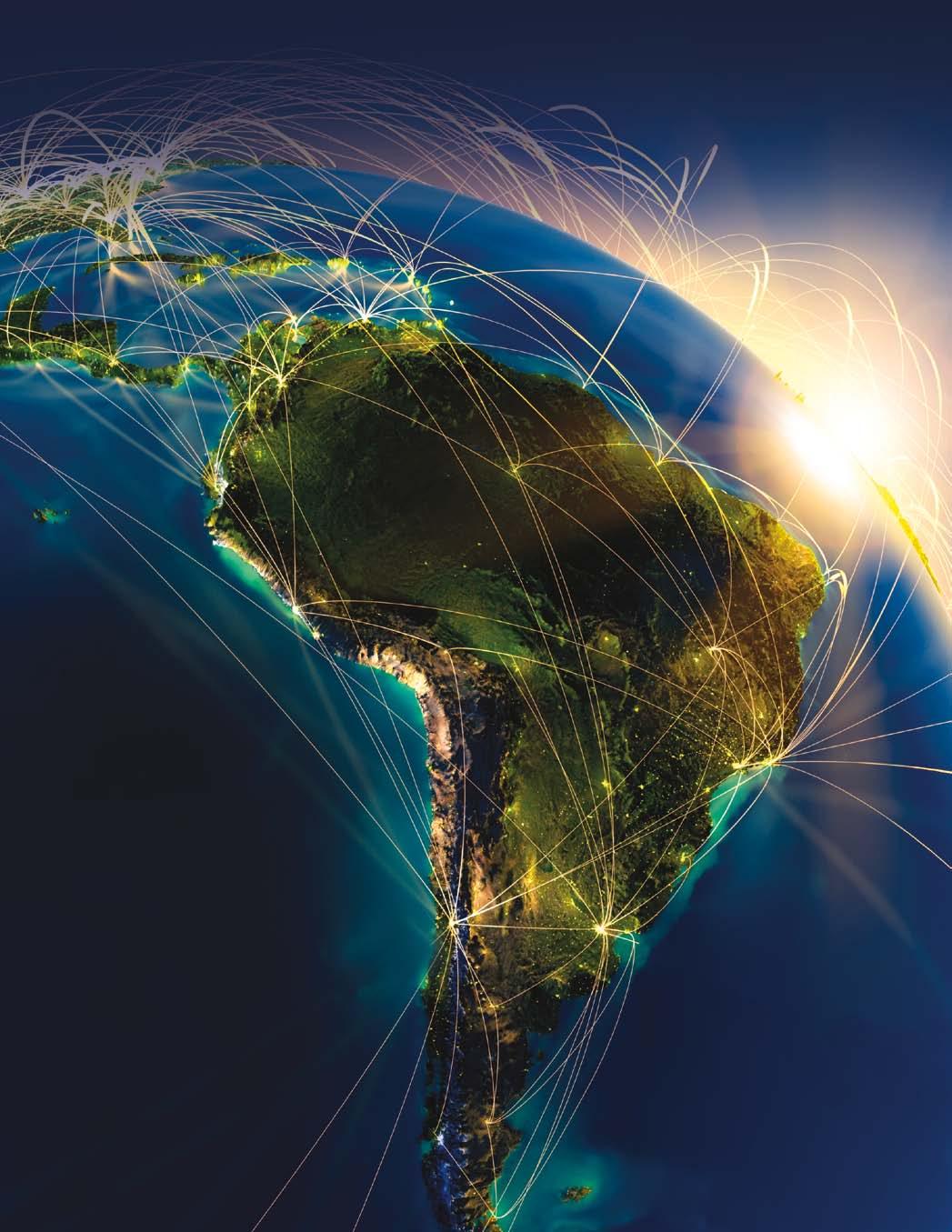
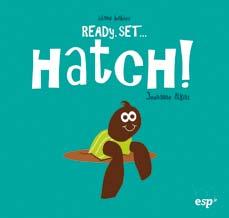
(Everything Slight Pepper, 44 pp, ISBN 9789769535008)
Boasting a colour palette as bold and bright as Grande Riviere beach at midday, the story of young leatherback turtle Hatch leaps with exuberance into young seafarers’ hearts. Alkins’s tale of this precocious tiny adventurer begins with the maritime journey made by his mother across thousands of North Atlantic miles towards the welcoming harbours of Caribbean waters. Her dangerous travels in search of safe spawning grounds, and the subsequent trials of Hatch and his siblings, are interwoven into this childhood primer on teamwork and resilience. “Just put one flipper in front the other. We’re almost there,” Hatch reassures a few of his slower-footed siblings, as they race towards the sea. Gaiety and crusading mirth mark the pages of this successful juvenile introduction to the life-cycle of one of our most endangered circumglobal species.
Reviews by Shivanee Ramlochan, Bookshelf editor

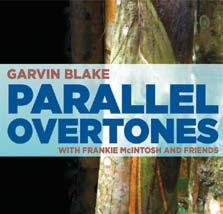
Brooklyn-based steel pannist Garvin Blake at long last follows up his 1999 debut album Belle Eau Road Blues with his new paean to pan jazz music, Parallel Overtones . The album is described as exploring “the synergy between pan, calypso, and jazz,” which it does with sure-handed skill. Balancing a repertoire between jazz standards and calypsos, Blake stealthily makes the case for renewed efforts of Caribbean pannists to record new music for the instrument. Vincentian keyboard stalwart Frankie McIntosh shares co-production along with songwriting and arrangement credits, making this album a showcase for the art of the Caribbean piano, with a sense of swing found only in hot latitudes. Kaiso-jazz classic “Fancy Sailor” sashays along at the steady chip of a slow lavway, while “Body and Soul” waltzes effortlessly to ably feature Blake’s quintet of players as soloists. The steelpan jazz oeuvre, while notably small, is emboldened by the addition of this well-produced album.




David Rudder represents a key link between old-style calypso and modern soca in the twenty-first century. A contemporary master of both genres, Rudder showcases that bridge on his new album Catharsis with music that is modern and lyrics that “turn a woman’s body into jelly.” Calypso is a lyricist’s and singer’s art, and here Rudder proves that he is unparalleled in the art of the metaphor to bring relevance to any topic, whether local or international. In “Long Walk Home” he sings of “race and America” using Nelson Mandela’s autobiography title to effect a broader perspective. On “Brooklyn Retro” Rudder recounts the essential sights and sounds of Caribbean-American existence of yore in the New York City borough. The word “catharsis” is defined as a relieving of emotional tensions — through music, for example — and on this album one can sense joy and celebration, anger and displeasure, reflection and awe. Rudder’s emotional release is food for the listener’s pleasure.
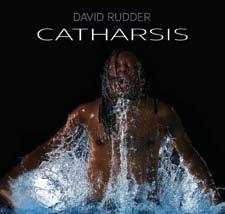
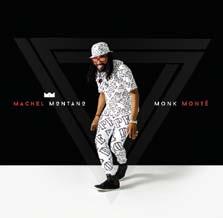
At the end of the 2015 Trinidad Carnival season, Machel Montano — now in his thirty-third year as a professional soca artist — effectively “owned” the festival by winning both the Soca Monarch and Road March titles. “Like a Boss” was an apt name for his hit single, included here, as he channelled his energies beyond simply making songs for Carnival. It’s not just business as usual. Montano’s new mission is to win a Grammy award, and he’s also declared a new persona — the still young performer has re-invented himself and his brand as Monk Monté, thus supplying the title of this new album of a dozen songs that dominated Carnival 2015. Here he teams up with Grammy-winning songwriter Angela Hunte on “Party Done” to deliver the message that once you have this Montano/Monté album, all other considerations are, in effect, over. Modern soca music is transforming, and Monk Monté may be its new pacesetter.

Northern Caribbean islanders, our Leeward Island “cousins,” have their own perspective on the regional music scene. Anguillan Natalie (Richardson), born in the US Virgin Islands and now resident in Florida, epitomises the young “upisland” scene with the release of her debut single “Perfect”. She is part of the new cadre of island artists who live in the metropolitan diaspora seeking success there, yet have their identities planted firmly on island terra firma. Musically, this smooth R&B groover signals that the island vibe of native Caribbean music has given way to a more international influence. Lyrically, youthful admonitions dominate — “If this love can’t keep us together / Then tell me what I want to hear / Tell me that I’m perfect” — suggesting that the headspace young people occupy here in the islands is in need of emotional fulfilment.
 Reviews by Nigel A. Campbell
Reviews by Nigel A. Campbell












The answer to the first question is easy. That person is Paul Carmichael, and he’s the thirty-five-year-old Barbadian executive chef at Má Pêche, one of the jewels in the crown that is Momofuku, the famed group of restaurants founded by chef and restaurateur David Chang.
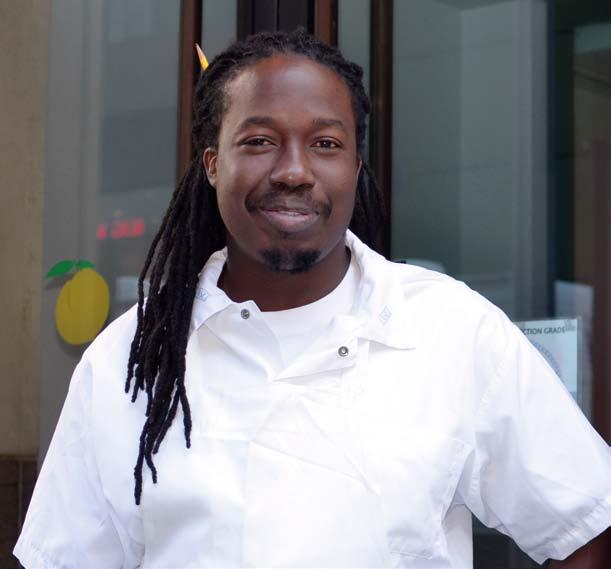
Momofuku began as the Momofuku Noodle Bar in New York’s East Village in 2004. That restaurant — and in particular its signature dish, to-die-for pork buns — put Chang on the Big Apple’s culinary map, and its success led him to unfurl several other establishments in the city under the Momofuku name, with Má Pêche opening its doors in 2010. Momofuku is Japanese for Lucky Peach; it’s also a tribute to Momofuku Ando, inventor of the ramen noodle — and, perhaps, it’s also meant to echo an English word you wouldn’t say in polite company. Several Michelin-guide and New York Times stars later, the brand has gone international, and counts among its outposts several in Toronto and one Down under, in Sydney.
The food at all of Momofuku’s restaurants can be said to have its roots in “Asian cuisine,” that well-worn, catch-all term lacking in nuance (and political correctness). “Eclectic” is another handy (and hackneyed) word of some use in describing the Momofuku style, but it’s the dim sum–inspired communal dining experience found at all its establishments, with passed plates and à la carte dishes meant for sharing, that best typifies the Momofuku experience.
It’s early evening in New York City, and you’re in a buzzing restaurant with friends for an informal dinner. As you sip your ginga ninja — a sublime, warming cocktail of Japanese whisky, ginger, and lime — you scan the menu for the choices on offer. In between dishes like creamy calamari chowder and duck sausage, your eyes alight on this: “Pan-fried whole boneless porgy — my dad’s hot sauce, fennel, lime.”
Questions, of course, are immediately forthcoming. Chief among them concerns the identity of the creator of the menu, and in particular this pronoun-personalised sea-bream dish. Who has taken their father’s fiery capsicum concoction and placed it on the menu of a chic midtown Manhattan eatery? And is it really their dad’s?
u ltimately, of course, each place is its own gastronomical beast, including Má Pêche. When it opened, the official nod was to French-influenced Vietnamese cooking — Má Pêche translates from Vietnamese-French creole as Mother Peach. Yet, since taking over from original executive chef Tien Ho in 2011, Carmichael has steered the restaurant in an altogether different direction — which, naturally, includes some Caribbean detours. Such dishes have included classic Barbadian fare like barbecued pigtails (paired with scrambled eggs) and souse (pickled pig’s parts) — the latter given an ingredient makeover, with lobster, green bananas, and cucumbers getting the pickling treatment, and scotch bonnet peppers tossed in to liven things up.
Pigtails and souse were among the dishes of Carmichael’s childhood, which he spent in a food-oriented family split between
how did a Bajan with a love for home cooking end up as executive chef at one of new york City’s most celebrated restaurants? Jonathan Ali meets Paul Carmichael, and hears his storyPhotography by gabriele Stabile, courtesy Má Pêche
the Barbados parishes of St Peter and St James. “I spent a ton of time growing up with my great-grandmother and my grandmother, and they were both very, very good cooks,” the amiable and forthcoming chef says from his busy restaurant. “They would sell food — [blood] pudding and souse. Sweetbread on Saturdays. People would come from all over to buy.”
The cooking bug bit him early. “My mom recently sent me a picture — I was on a stool making bacon and eggs at age three. I always wanted to cook. It’s the only thing I’ve ever really, really enjoyed doing. I was always cooking for my parents, for my siblings, friends. I even got some jobs as a kid in school making pizza.”
School wasn’t where he wanted to be, though, and at fifteen he tried to convince his parents to let him go to Puerto Rico to cook at a restaurant there. unsurprisingly, they said no (“Parents gotta do what parents gotta do”), but Carmichael’s father, a bartender at the renowned Sandy Lane Hotel, offered to get his son an after-school job in the resort, thinking the rigours of a top-flight restaurant environment would see Carmichael pack it in after a week.
Carmichael père misjudged his son. “I stayed there a year and a half,” Carmichael says smiling. In addition to learning invaluable cooking techniques from some of Barbados’s best professional cooks, Paul learned in Sandy Lane’s hallowed kitchens — and at The Cliff, the restaurant he worked at subsequently — the core values that have guided him through his career thus far: “Give one hundred per cent. Don’t complain. Stay humble.”
After graduation, Carmichael further acceded to his parents’ wishes by taking a degree in computer programming from Barbados Community College. Once that was dispensed with, however, he headed promptly to the united States, and the prestigious Culinary Institute of America in upstate New York. In between classes, he would dip into the city, to check out the restaurant scene and possible places of employment.
This led him to an apprenticeship at Aquavit, the Swedish restaurant then helmed by twenty-six-year-old Ethiopia-born wunderkind Marcus Samuelsson, who was committing delicious culinary crimes by using Asian ingredients in his traditional Scandinavian dishes. Did Samuelsson’s ethnicity play any part in Paul’s decision?
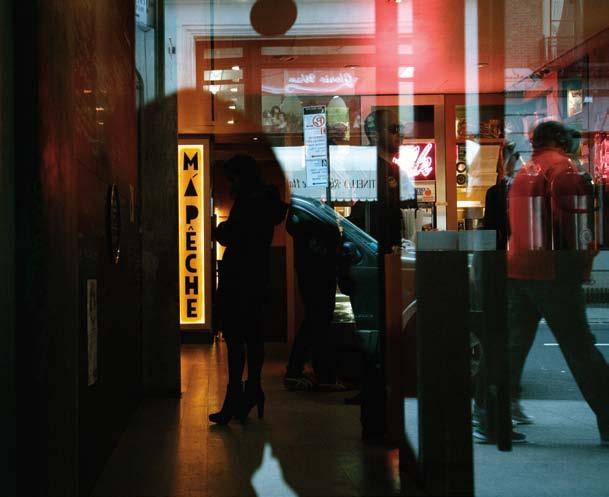
“I didn’t even know Marcus was black until I walked into the kitchen,” Carmichael says. “It was never about colour for me, it was always about skill. I never held myself back because I was the only black person in a place. It was always, ‘Hey, am I good enough to be here, or am I not, skill-wise?’”
After graduation, Carmichael returned to Aquavit. It was the turn of the millennium, a time when the New York restaurant scene was starting to capture the public’s imagination, and chefs began to be fêted like rock stars — a period bottled by one-time celebrity chef Anthony Bourdain in his vivid best-selling memoir Kitchen Confidential. Over the coming decade, Carmichael paid his dues at a number of restaurants in the city, ending up under executive chef Wylie Dufresne at WD-50, “the first restaurant I cooked in where I felt I had a voice.”
Ten years in the New York cauldron led Carmichael to seek a change. He headed back to the Caribbean and to Puerto Rico, where he’d originally intended to go as a teenager. He eventually became executive chef there at the Pearl restaurant — but then New York, in the personage of David Chang, came calling again.
Carmichael had first met Chang back in his Aquavit days, and from time to time the Momofuku man would ring him up in Puerto Rico to see if he was ready to return to the centre of the culinary universe. Finally, with Má Pêche set to open, Chang called one more time. This time Carmichael took the plunge.
On its opening, Má Pêche was anointed with two out of a possible four stars from The New York Times. Not long afterwards, the day came when Carmichael was offered the position of executive chef. “It was scary. It took a long time to make the decision,” he says. “But I’m glad I made it, glad I didn’t back out.” He remembers Chang telling him, “Pauly, it’s yours, do what you will.”
Carmichael took those words to heart. Finally, New Yorkers would get to taste his true hand. In addition to the Barbadosinspired dishes that have been served at Má Pêche, the cuisines of other islands have also graced the restaurant’s vaunted tables. These include Paul’s take on Jamaican jerk chicken wings (arguably the gateway food to Caribbean cooking), and, in a nod to his Puerto Rico days, a DIY mofongo, with a mortar and pestle for patrons to gleefully pound their plantains, garlic, and pork together.
Yet, as diverse as Carmichael’s dishes can be, it’s his finely honed culinary “voice” — which he speaks of much in the way a writer might speak of theirs — that ties together everything he does. “You’ve got to find a voice, and you’ve got to use that voice in a way that people can understand, otherwise you’re just yapping.”
That voice, of course, is grounded in the solid, unpretentious food of his childhood, the food he first loved and to which he always comes back. “I can never forget the first time I had a barbecued pigtail. Or black pudding and souse. Or the first time my mom made me fish cakes and bakes,” Carmichael says, with a Proustian air. “The beauty about being a cook is that you get to give that feeling to somebody else, a version of that thing that they perhaps never thought could be that good.”
And that hot sauce that comes with the porgy? “It’s my version of my dad’s hot sauce,” he confesses. “I like to call it New York hot. It’s not as spicy as my dad’s hot sauce. I have a bottle of that in my fridge at home.”
42 Panorama ready for their closeup
54 Backstory dubbing is a must
60 showcase two poems from Coming Up Hot
62 snapshot the anti-expected
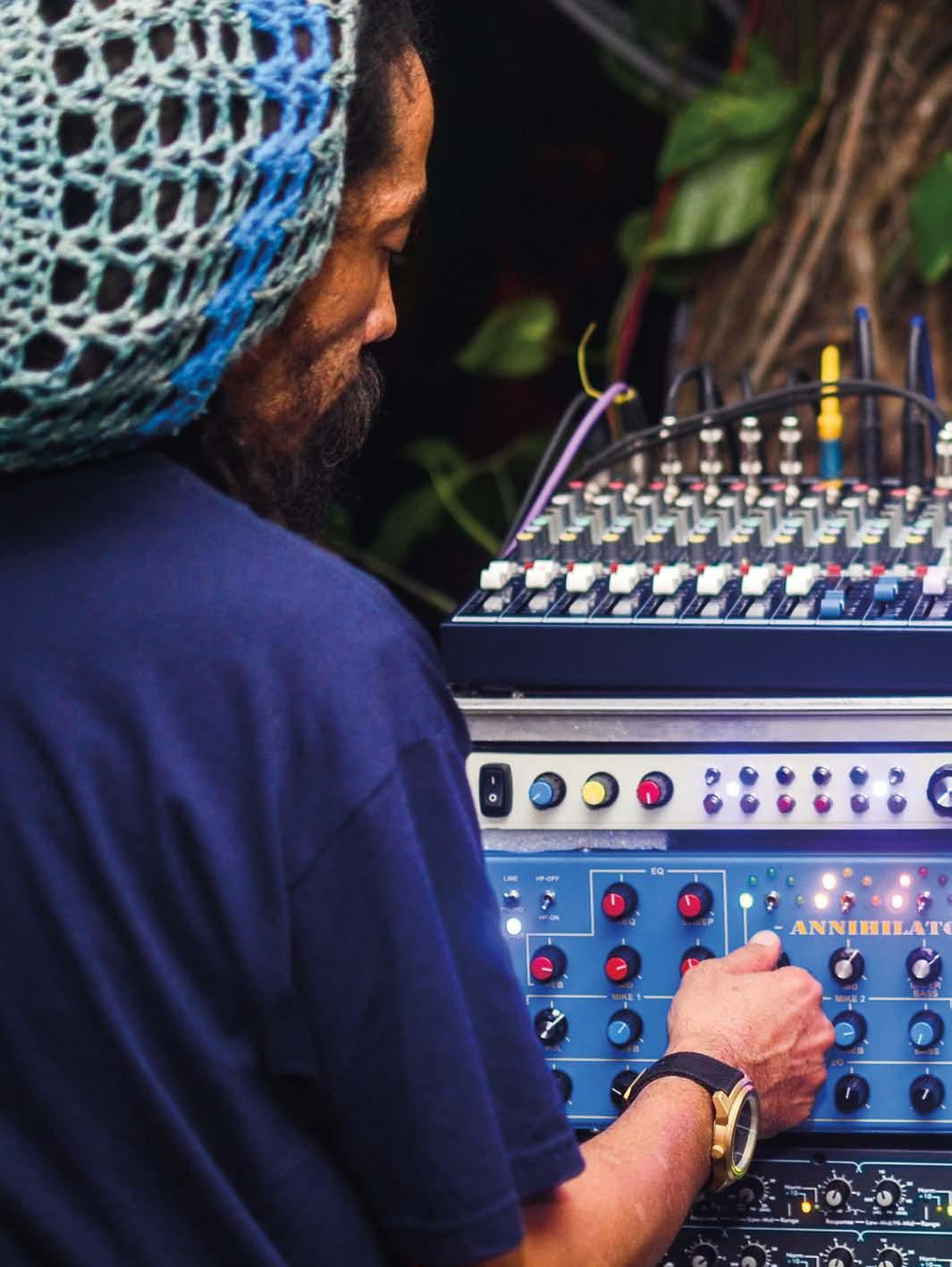 DJ Gabre Selassie, founder of Kingston Dub Club
DJ Gabre Selassie, founder of Kingston Dub Club
It was sixty-five years ago that Cyrano de Bergerac was released, a film that would make Puerto Rican actor José Ferrer the first Caribbean person to win an Oscar (for best actor in a leading role, 1951). He also won a Golden Globe, and a Tony award for the Broadway production, and ultimately donated his Oscar trophy to the university of Puerto Rico. Born in 1912, he would earn more Oscar and Emmy recognition in his career, and effectively clear the way for a generation of Caribbean actors born after him who would command American and British stages and screens — breaking new ground, and some records, along the way.

Ferrer’s homeland of Puerto Rico is the birthplace of some of the most dynamic performers in film and television history. Exactly ten years after Ferrer’s win, legendary actress Rita Moreno became the second Puerto Rican to win an Oscar (and a Golden Globe), as best supporting actress, for her role in West Side Story She is among just twelve individuals worldwide, and the first Hispanic, to have won all of the Oscar, Grammy, Emmy, and Tony awards. Notably, when that list is
extended to include winners of honorary awards, another Caribbean-American star — Harry Belafonte — is among the prestigious number.
Four years older than Moreno, Belafonte was born in 1927 in Harlem to a Jamaican mother and a Martiniquan father. An actor, singer, songwriter, and activist, he first appeared on the silver screen in films like Carmen Jones and the controversial Island in the Sun, filmed on location in Grenada and Barbados. His album of calypso and mento recordings, Calypso , was released in 1956. Now eighty-eight, and considered a living legend, Belafonte counts three Grammys, an Emmy, a Tony, Kennedy Centre Honours, a u nited States National Medal of Arts, and the Jean Hersholt Humanitarian Award among his many accolades.
There was another very notable birth in 1927, when Sidney Poitier — though raised in the Bahamas to Bahamian parents — was born in Miami. Poitier would become the first African-American, and third Caribbean man or woman (after Rita Moreno) to win an Oscar. In 1964, he took both the Golden Globe and the
you see their familiar faces on the screen, but perhaps you don’t always catch their accents. Caribbean acting talent has been infiltrating h ollywood for decades, from blockbuster movies to hit t V shows to
indie productions.
Caroline Taylor takes a look back at an earlier generation of actors who made it big on stage and screen — and profiles some of the heaviest hitters among the current generation
Academy Award for best actor in a leading role for his performance in Lilies of the Field. An actor, director, author, and diplomat, Poitier is one of the most celebrated artists of his generation, with recognition that includes a knighthood, Kennedy Centre Honours, the u S Presidential Medal of Freedom, and numerous lifetime achievement awards.
Esther Rolle was also born in Florida to Bahamian parents, just a few years earlier than Poitier, in 1920. A theatre, film, and TV actress, dancer, and singer, she aptly became best known for her role as Florida Evans on 1970s uS TV series Maude and its spin-off Good Times ,
Dozens more Caribbean-born and –descended performers have made their mark in hollywood, continuing the tradition of winning top industry prizes and starring in popular films and tV series
The Orchid House, directed by Trinidadian Horace Ové. After she died of leukaemia at just fifty-seven, Sinclair’s ashes were scattered in her hometown in Jamaica.
a role for which she was nominated for a Golden Globe. She made history in 1979 by winning the very first Emmy for outstanding supporting actress in a limited series or special, for the TV movie Summer of My German Soldier
Twelve years later, Jamaican actress Madge Sinclair (born in Kingston in 1938) made more Caribbean Emmy history, winning for best supporting actress in a drama series (Gabriel’s Fire), and receiving another Emmy nod for her role in the TV miniseries Roots . The voice of Simba’s mother in The Lion King film, she notably performed in the uK miniseries adaptation of Dominican Phyllis Shand Allfrey’s novel
Further south in the island chain, the multi-talented Geoffrey Holder — who passed away in 2014 — was born in Trinidad in 1930. Holder conquered stage and screen, featuring in films like All Night Long, Annie, and Boomerang; narrating Charlie and the Chocolate Factory ; playing James Bond henchman Baron Samedi in Live and Let Die ; and becoming 7 up’s “uncola” spokesman in the 1970s and 80s (later reprising the role for an appearance on uS TV show The Celebrity Apprentice) An actor, choreographer, director, dancer, painter, costume designer, and singer, his accolades included two Tony awards and a Guggenheim Fellowship in fine arts.
Since those defining moments in the 1940s onwards, when these trailblazing artists from the region first appeared on global screens, dozens more — both Caribbean-born and children of Caribbean immigrants, a majority of them women — have made their mark, continuing the tradition of winning top industry prizes and starring in popular films and TV series. We profile just a few of them in the following pages, with extended coverage — including candid interviews — on our website, caribbean-beat.com
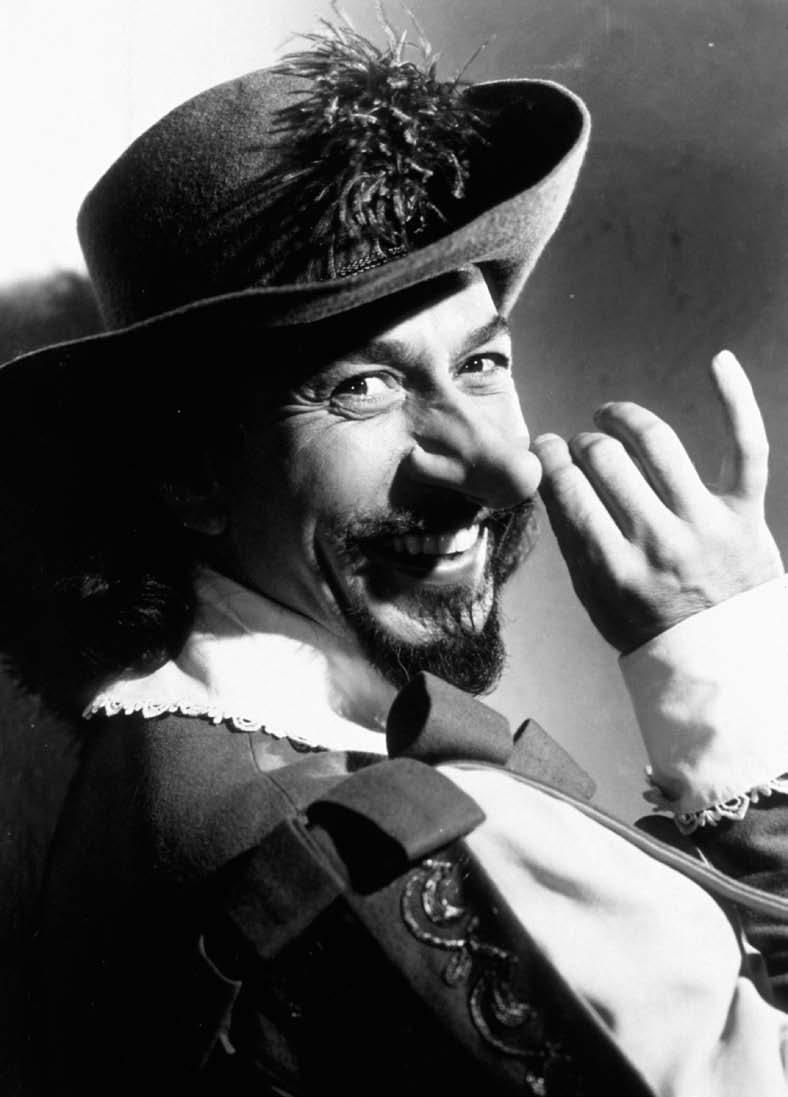
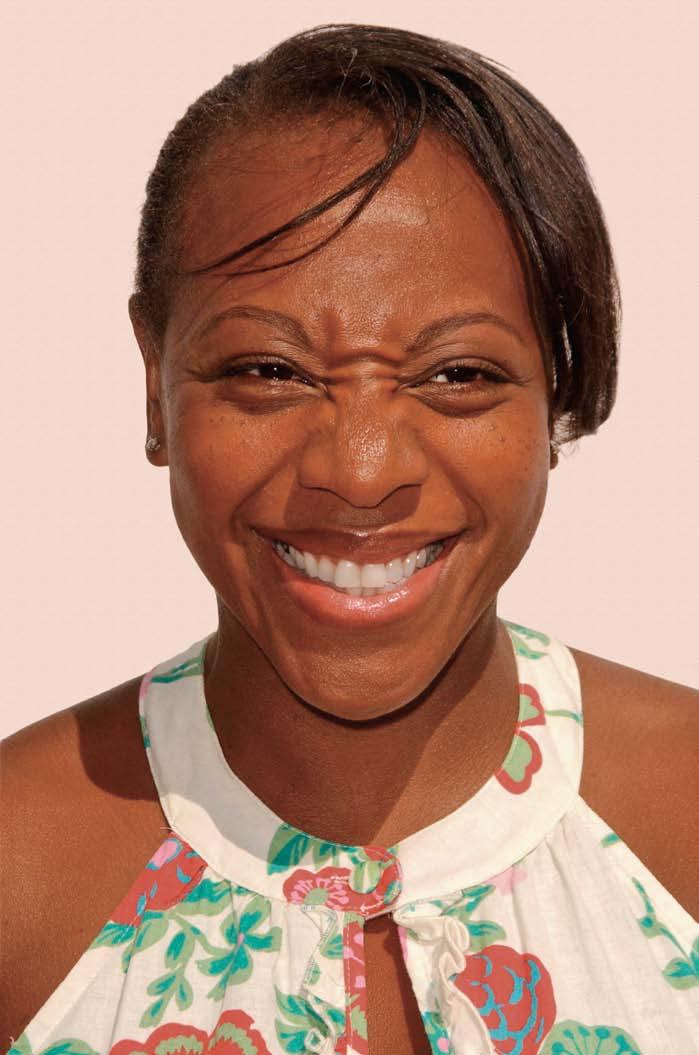
Born in Britain in 1967, to an Antiguan mother and St Lucian father
Jean-Baptiste made her mark early in her career by snagging an Oscar nomination for supporting actress in Secrets & Lies in 1996, becoming the first black British (or black Caribbean) actress do to so. An actress, singer-songwriter, writer, director, and composer (she wrote the score for Mike Leigh’s film Career Girls), she’s perhaps best known for her roles on the uS TV series Without a Trace, the u K series Broadchurch, and films like last year’s RoboCop
On her Caribbean roots: JeanBaptiste was appointed a tourism ambassador for Antigua and Barbuda in 2007, and believes the islands are perfect potential film and music video locations. Proud of her Caribbean heritage, she says: “It has informed who I am and how I see the world. A deep love for my culture, firmly grounded in family and tradition, keeps things in perspective for me. Family first, always. I still have family back in Antigua who I visit whenever I’m there,” she continues. “I think there is a sense of community among Caribbean actors in film and TV. And though it might not be that we all hang out, there is definitely a sense that we are from the same tribe, a sort of shorthand.”
Joseph Marcell: Born in St Lucia, he is best known for US TV series The Fresh Prince of Bel Air (co-starring with three actors of Trinidadian heritage) and films like Cry Freedom. He plays influential Trinidadian writer C.L.R. James in Trinidadian director Frances-Anne Solomon’s upcoming film Hero

Born in the uS in 1977, to a Jamaican mother and American father
Her iconic Emmy- and Golden Globe–nominated role as Olivia Pope in uS TV series Scandal has made Washington a household name. This actress and activist is the first black female lead in an American network TV drama since 1974. Other notable screen appearances include Save the Last Dance (starring GuyaneseAmerican actor Sean Patrick Thomas), The Human Stain, Ray, The Last King of Scotland, the Fantastic Four films, For Coloured Girls, and Django Unchained. She was listed as one of the hundred “most influential people in the world” by TIME magazine in 2014.

more stars of Jamaican heritage:

Dulé hill (Jamaican parents): best known for roles on US TV series The West Wing (for which he received an Emmy nomination) and Psych.
Delroy lindo: Born in England to Jamaican parents, he’s best known for film roles in movies like Malcolm X, Get Shorty, Ransom, The Cider House Rules, and Gone in 60 Seconds. He was also nominated for a Tony Award for Joe Turner’s Come and Gone.

Born in Guyana on Christmas Day 1962, as Carol Christine Hilaria Pounder, and grew up in the uS and the u K
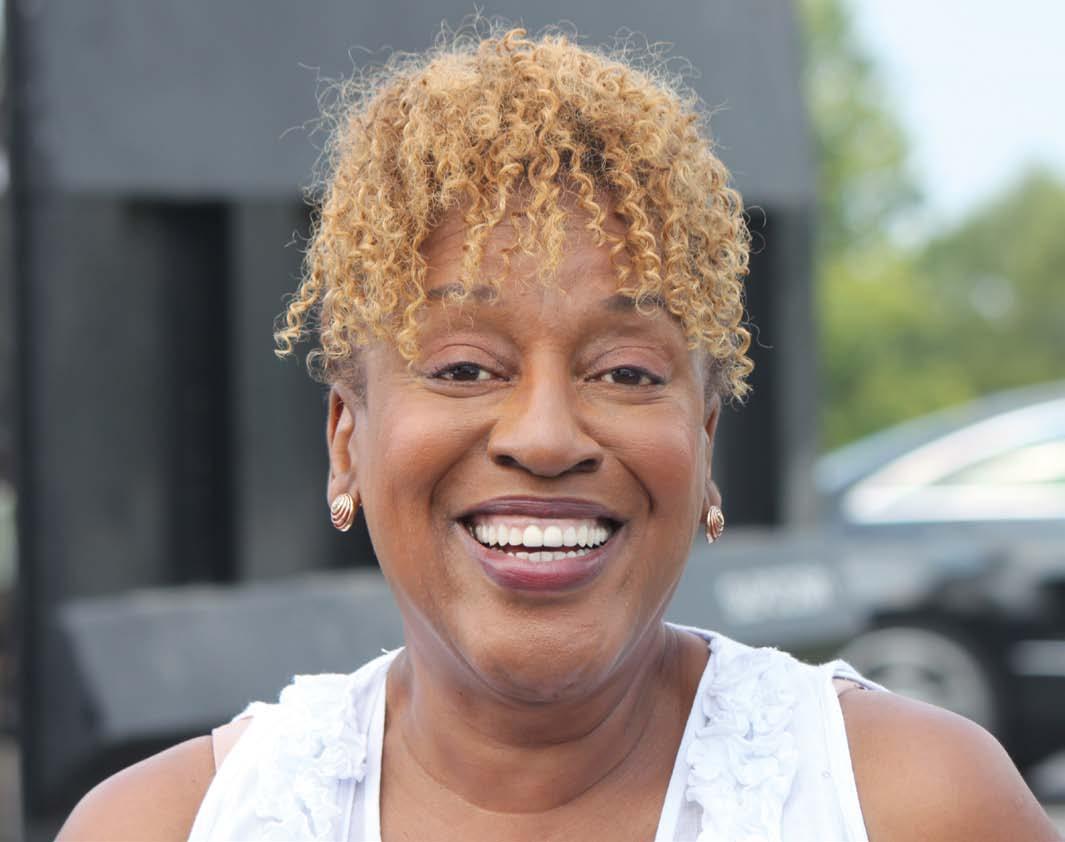
Currently appearing in the uS TV drama NCIS: New Orleans , Pounder is also known for her past roles on ER (for which she received one of four Emmy nominations), The X Files, Law & Order SVU, The Shield, and Sons of Anarchy, and in films like Face/Off, RoboCop 3, Prizzi’s Honour, Avatar, and Bagdad Café. She also starred in Home Again, a movie filmed in Trinidad in 2012 (an island she has visited with friend Lorraine Toussaint). Pounder nurtures emerging African and Caribbean diaspora visual artists through the Pounder Kone Art Space in Los Angeles and the Musée Boribana in Senegal, co-founded with her husband. She received an honorary Doctorate of Fine Arts from her alma mater, Ithaca College.
On her Caribbean roots: “Having left Guyana so young, one would think it was long left behind in my lifestyle,” she says, “But my parents never lost what they brought with them, and I was always the most curious in my family to go back and reconnect with what I remembered of Versailles Estate. I made my mother join me on one of my trips to Guyana . . . I sat and listened to Ole Haig stories, ate black cake, sugar cake, curry and roti, drank mauby and ginger beer. I revisited all I remembered from childhood.
“The impact of these journeys has been indelible, and holds me closer to a country I now rarely see but never forget and always claim . . . Having lost my mother, I’ve also lost many connections to Guyana, but not the Guyanese people, who seem to be scattered to the four winds . . . We cross paths enough for our presence to be known.”
in Puerto Rico in 1967,
Beginning his career with bit parts on TV playing the stereotypical Latino drug dealer, del Toro graduated to playing a James Bond villain in License to Kill (still the youngest actor ever to do so), and popular and critically acclaimed films like China Moon, The Usual Suspects (considered his breakout performance), Basquiat (about the Haitian- and Puerto Rican–American painter of the same name), Snatch, 21 Grams, Sin City, Guardians of the Galaxy, and the title role in Che. He joined the ranks of a handful of Caribbean actors (and became the third Puerto Rican) to win an Oscar, Golden Globe, and other awards for his supporting role in Traffic, in which his character predominantly spoke a language other than English (most of his lines were delivered in Spanish). Coming up? A film with maverick director Terrence Malick.
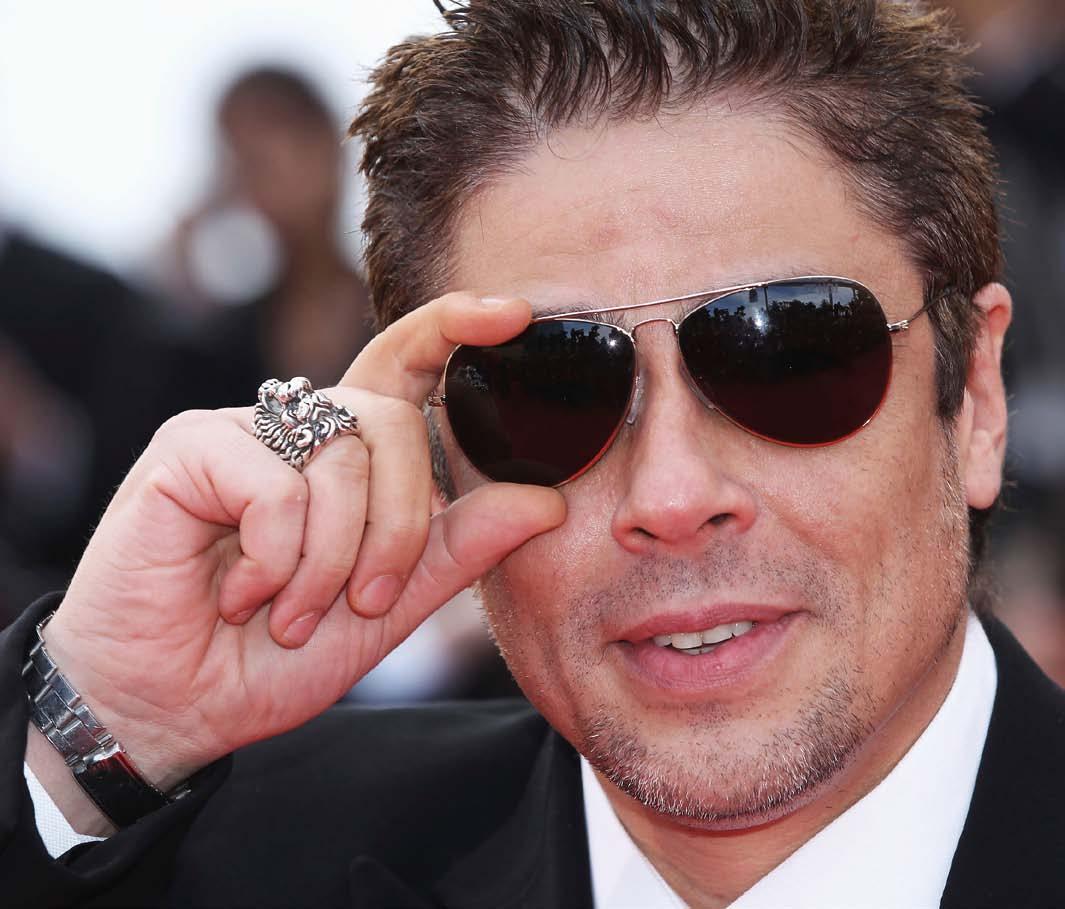
On his Caribbean roots: On receiving a lifetime achievement award last year, del Toro said: “I want to dedicate this award to the piece of land where I come from, where I was born, where I learned to throw rocks and had them first thrown at me, where I learned to take risks, and where I learned not to do things just to do them.”

Rosario Dawson (Puerto Rican mother): known for Men in Black II, the Sin City and Clerks films, Rent, Alexander, Seven Pounds, Unstoppable, and the new Daredevil series.
Acclaimed for her performance in the hit series Orange Is the New Black , the Juilliard-trained actress — whom Caribbean Beat interviewed back in 2008 — is also known for roles on uS TV series Forever, Saving Grace, Any Day Now, The Fosters, Friday Night Lights, Crossing Jordan, Ugly Betty, and Law & Order, as well as films like Hudson Hawk, Dangerous Minds, The Soloist, Middle of Nowhere, and the recently released Selma, in which she grippingly played iconic civil rights activist Amelia Boynton Robinson. These days, Toussaint is focusing more on producing, with an eye for projects that are Caribbeanbased, and a desire to invest in Trinidad and Tobago’s film industry and develop young acting talent.
On her Caribbean roots: Toussaint returns to Trinidad regularly, and has hosted workshops for developing filmmakers and actors back at home through the national film company. She sees no reason her homeland can’t be the mecca of the film and theatre industry in the Caribbean. Toussaint has said that her Trini roots, and identifying as a Caribbean woman, have served her well. Being from the Caribbean is “an empowering perspective on the world,” she says, “coming from a place where being a person of colour doesn’t render you a minority. To be part of the majority as a person of colour is very important, so I keep bringing [my daughter] home. So that she’s got roots there . . . My daughter considers herself a Trinidadian. I am glad we’re a part of this.”


Another star of Trinidadian heritage:
Jackée harry (Trinidadian mother): best known for US TV series like Sister, Sister (with Tia and Tamera Mowry, who are of Bahamian heritage) and 227, for which she has the distinction of becoming the first and only black actress to win the Emmy for outstanding actress in a comedy.
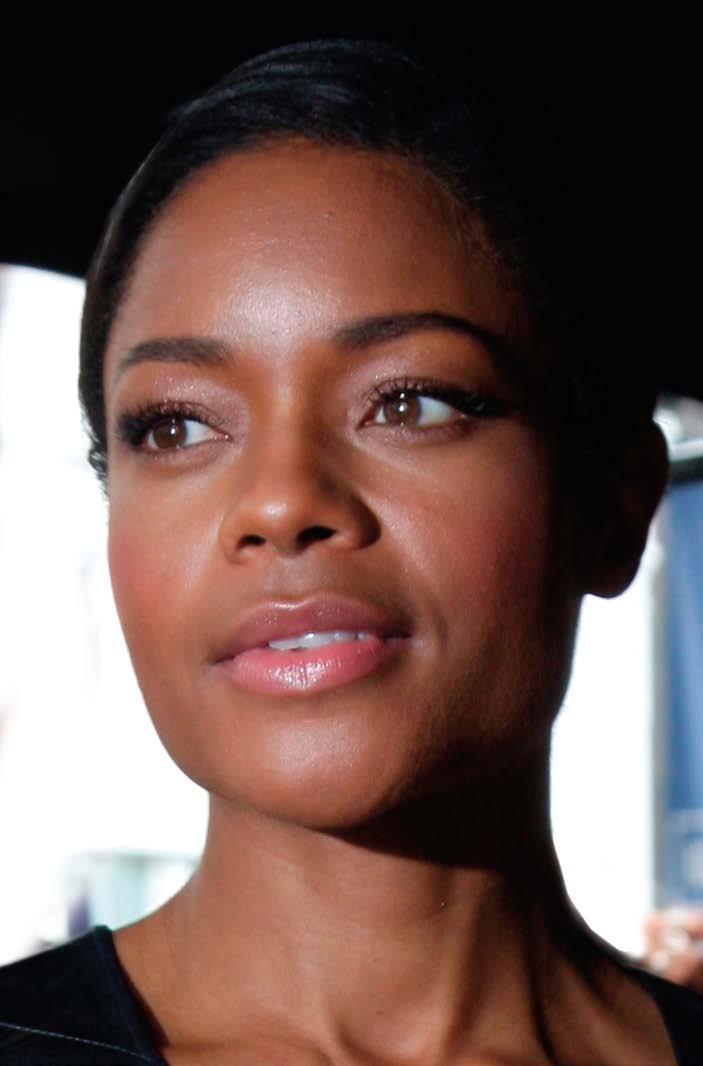
Born in Britain in 1976, to a Jamaican mother and Trinidadian father
Millions saw her performances as Tia/Calypso in two of the wildly popular Pirates of the Caribbean movies, but Harris’s film, television, and theatre roles on both sides of the pond include more literary fare, such as the BBC TV adaptation of Jamaican-British author Andrea Levy’s Small Island (filmed in part in Jamaica) and the mini-series adaptation of Jamaican-British writer Zadie Smith’s White Teeth. She’s also played Winnie Mandela in Mandela: Long Walk to Freedom and Eve Moneypenny in the James Bond films Skyfall (2012) and Spectre (due for release later this year) — both of which are directed by Sam Mendes, himself of Trinidadian descent. Harris is the first black actress to play the role of Moneypenny.

On her Caribbean roots: Asked about her heritage, the graduate of Cambridge university has said: “I was raised within the Jamaican culture in Britain. I was surrounded by these incredibly powerful women growing up — independent, opinionated, strong-willed women, like my mum and my aunt.”
grace Jones: Born in Jamaica, this iconic model, songwriter, model, record producer, and Grammy-nominated singer is best known as an actress for roles in Conan the Destroyer alongside Arnold Schwarzenegger, the 1985 James Bond movie A View to a Kill, and Boomerang with Eddie Murphy.
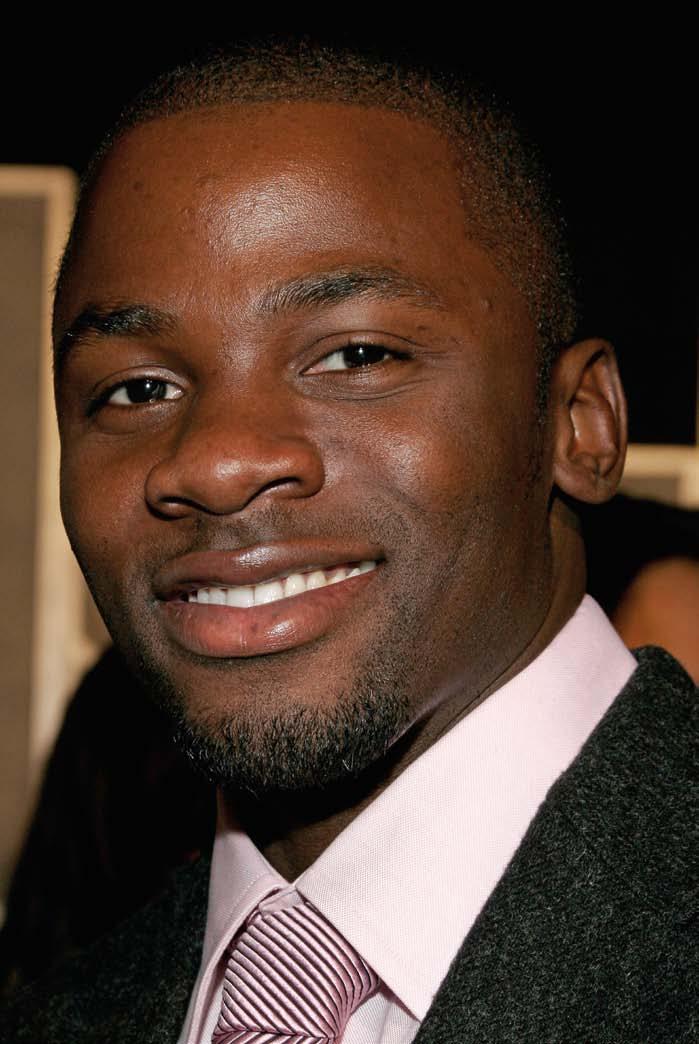

Born in the uS in 1974, to a Guyanese father and American mother
Luke’s breakout performance was his film debut in Antwone Fisher, in the title role and alongside Denzel Washington. These days, he’s best known for heating up the screen in the new hit uS TV series Empire. Other notable screen appearances include Spike Lee’s Miracle at St Anna, Captain America: The First Avenger, Madea Goes to Jail, Sparkle, Biker Boyz, Friday Night Lights, and playing Sean “Puffy” Combs in Notorious. He’s also been featured in music videos by Alicia Keys (“Teenage Love Affair”) and Monica (“So Gone”).
Also of Guyanese heritage:
sean Patrick thomas: Born in the US to Guyanese parents, he’s known for roles in Conspiracy Theory, Courage Under Fire, Cruel Intentions, Save the Last Dance, Barbershop 2, Halloween: Resurrection, and TV series The District. Read a full interview with Sean on our website.
Born in the uS in 1978, as Mayte Michelle Rodriguez, to a Puerto Rican father and a mother from the Dominican Republic, spending some of her early years living in both those Caribbean countries

Her breakout role (as a boxer) in the film Girlfight won her an Independent Spirit Award. She went on to star in S.W.A.T., the surfing movie Blue Crush, the Resident Evil and Fast and Furious film series (including this year’s seventh instalment of the latter), and Avatar, as well as popular TV series Lost. She’s been described as “the most iconic actress in the action genre” in Hollywood, becoming known for “tomboy” roles — and she moonlights as a DJ.

On her Caribbean roots: In 2012, Rodriguez travelled to the DR for the PBS series Finding Your Roots , and was also part of National Geographic’s Genographic Project. Of the impact of her heritage, she says: “The Spanish language has come in handy throughout the years, helping me connect with people all over the world in ways they’d never expect to connect with an English-speaking American. The culture has made me a laid-back warm-hearted seeker of joy in life — I blame that on salsa, Spanish love songs old and new, as well as the warm weather in Puerto Rico . . .
I’ll eventually come back and buy some land in either Puerto Rico or the DR, so I can enjoy some of the nature I love so much in my retirement,” she adds. “The Caribbean has a warm welcoming spirit and a zest for life I can’t compare to any other place I’ve been to. I’ll always have a place for the Caribbean in my life.”
Zoe saldana: Born in the US to a Puerto Rican mother and father from the Dominican Republic, she spent some of her childhood in the DR before returning to New York City as a teen. Known for Drumline, Pirates of the Caribbean, Guardians of the Galaxy, Avatar, and the rebooted Star Trek films (playing Uhura), and the forthcoming Nina Simone biopic, Nina.

Born in the uS to a Jamaican mother, she spent some of her childhood in Jamaica, and is best known for uS TV series Moesha, It’s a Living, and films like Sister Act II, White Man’s Burden, The Distinguished Gentleman, and The Flintstones
Born in the uS to a Trinidadian father and Panamanian mother, she’s best known for uS TV series The Fresh Prince of Bel Air, The Young and the Restless, and films like Kiss the Girls and Home Again, which was filmed in Trinidad in 2012 and co-starred C.C.H. Pounder.
Born in Haiti, migrating to the u S as a child, she’s featured in roles on uS TV series The Jaime Foxx Show and NYPD Blue, and films like Coming to America, Wild Wild West, and White House Down. She also starred in the u S TV movie Girlfriends Getaway, shot on location in Trinidad and Tobago in 2014.
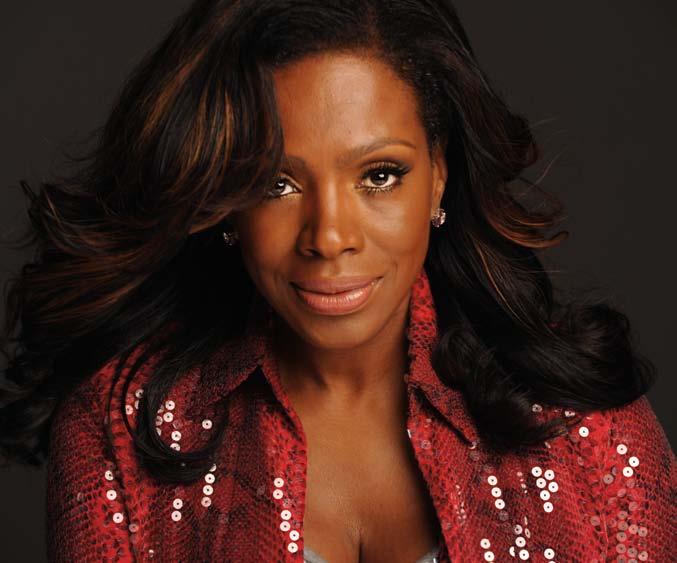

Born in the uS to Trinidadian parents, he’s best known for roles in uS TV series like Weeds, and movies like The Forty Year Old Virgin, the Think Like a Man films, Baby Mama, and Blades of Glory.
Born in the uS to Trinidadian parents (and the grandson of Trinidadian calypso legend Rafael “Roaring Lion” Leon), he won uS TV series Dancing with the Stars last year, but is probably best known for his role in The Fresh Prince of Bel Air with Will Smith (and co-starring with Tatyana Ali, Karyn Parsons, and Joseph Marcell).
Born in the uS to Cuban parents, she’s appeared in uS TV series Suits and the Matrix films. She is married to fellow Matrix co-star Laurence Fishburne.
Born in the uS to parents from St Kitts and Nevis, this decorated veteran actress of stage and screen has starred in films like Sounder (Oscar and Golden Globe nominations for best actress), Hoodlum, Diary of a Mad Black Woman, Idlewild, The Help, and countless uS TV movies and miniseries, including Emmy-nominated performances in Roots , King, The Marva Collins Story, Oldest Living Confederate Widow Tells All, The Trip to Bountiful, as well as The Autobiography of Miss Jane Pittman (Emmy for outstanding lead actress, and actress of the year). Recently she played Viola Davis’s mother in the hit series How to Get Away With Murder.
And did you know these Caribbean connections?
Beyoncé (Bahamian father)
tyson Beckford (Jamaican mother)
naomi Campbell (Jamaican mother)
stacey Dash (Barbadian father)
Cameron Diaz (Cuban ancestry on father’s side)
Cuba gooding, Jr. (Barbadian grandfather)
ll Cool J (Barbadian grandparents)
tia and tamera Mowry (Bahamian mother)
gwyneth Paltrow (Barbadian great-grandmother)
Jada Pinkett smith (maternal Barbadian/Jamaican ancestry)
Karyn Parsons (Trinidadian mother)
For an extended version of this article — including interviews — visit our website at caribbean-beat.com/ issue-133/caribbean-hollywood

A major change in the Jamaican music scene of recent years is the rise of a bold “Reggae Revival,” reaching back to “conscious,” Rastafari-influenced roots. And the headquarters for the movement is an increasingly trendy weekly gathering of DJs, musicians, and music fans high in the hills above Kingston. David katz visits the Kingston Dub Club and meets its inspired founder, gabre selassie
If you don’t have your own car, getting to the weekly Kingston Dub Club requires a significant commitment, since there is no public transport to its location up in the hills above Jamaica’s capital. An hour-long walk up a very steep hill from Papine Square or a pricey cab fare are the only options, if you can’t catch a ride with a friend. Once you get to the end of Skyline Drive — where it might be cool and foggy, depending on which way the wind is blowing — cellphones switch to torch mode, as you walk along a dirt track, heading over a small rise in the direction of the music.
Steep concrete steps that wind down the hillside soon bringing you to the Dub Club itself, in the yard around founder Gabre Selassie’s home. Turn left to find your place on the heaving dance floor, where massive columns of speakers blast roots reggae at top volume. On the rear


deck, at the other side of the DJ’s sound station, there is a large wooden bar with homemade moringa tonics and ganja wine on offer, along with more standard beverages.
The deck is a real chill-out zone, where you can hear the music clearly, but still carry on a conversation, and in its far corner you may find Rastafari veterans sharing a communal water-pipe. Hot ital food is served, courtesy of Veggie Meals on Wheels, and books on black history are often sold near the entrance.
A mere two years ago, the Kingston Dub Club was an insiders’ affair, an underground destination populated by a few local regulars and the occasional overseas visitor. But these days the place is the talk of the town: a hip spot packed to the rafters, despite its remote location. usain Bolt has been spotted there, and many reggae luminaries form a regular presence — such as dub poet Oku Onuora and singer Kiddus-I, who both worked
with Bob Marley during the 1970s. Most significantly, the space is currently home to the vanguard of the “Reggae Revival,” a coterie of close-knit musicians, filmmakers, and visual artists active in different sectors of the city, who have collectively risen to prominence in tandem with the club, bringing the focus of Jamaican popular music back to its roots.
In addition to providing a space in which artists like Protoje and Chronixx have been able to air new material, the Dub Club has also acted as a general catalyst to the movement, with Selassie’s Rasta-oriented playlist of forgotten reggae classics, hard-hitting dub music, and contemporary roots recordings leading this new avant garde to take leaps of sonic faith — driving Jamaican music into new areas in the process.
“I really got introduced to dub through Gabre Selassie,” says Jah9, the young female vocalist, social activist, and yoga teacher whose inspired hybrid of jazz and dub has led some to


name her as the future of reggae. “I went to a session at Gabre’s house where he played strictly dub through some huge speaker boxes in his front yard, and I was just freestyling and flowing — because of the spaces, words were just pouring out. It provided me with exactly what I needed.”
Face to face, the enigmatic Selassie is an intense character, obviously strongly committed to his goals — which include a longstanding commitment to revitalising Kingston’s roots reggae scene. In heavily accentuated speech that references his Rastafari worldview, Selassie notes that the Dub Club has always gone against the grain, ignoring the ubiquitous hardcore dancehall that has long captured the imagination of the Jamaican public, instead featuring styles venerated by overseas roots reggae fans, which were rarely heard on the island itself.
“The Kingston Dub Club been going for about twelve years now,” Selassie says, “but with very little success at first. It was inspired by the original Dub Club in London, which I first visited in 2000, and my intention first and foremost was to provide a different option where music was concerned. It was for the people to get a fair chance to enjoy them own heritage and culture,” he explains, “and to receive the blessing of reggae music that makes one know themselves and know history, look inna themselves and know Jah.”
He started off at various venues around Kingston, like Harry’s Bar, “where some likkle roots youth were promoting poetry and live music nights,” and Shaggy’s Backyard Club. “But because it was new and ground-breaking, a lot of the club owners weren’t with that kind of vision,” Selassie says. “Every time that I planted a seed at those venues, the seed bust, and the sucker
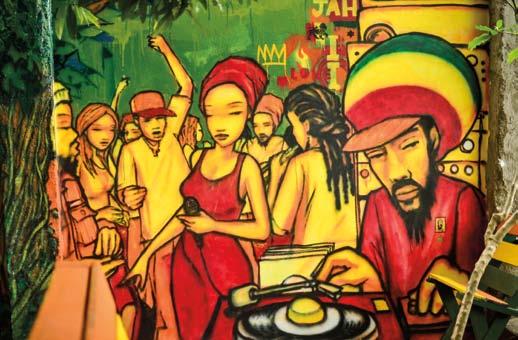
During recent years, a new artistic movement has taken hold in Jamaica, with graphic artists, filmmakers, and musicians using their art to enact social change, all working from a Rastafari perspective. Practitioners associated with the movement include the youth arts group Manifesto Jamaica, the transformative mural project Paint Jamaica, filmmakers such as Storm Saulter and Kush-I, the travelling bookseller I-Nation, and more recently Occupy Pinnacle, whose members seeks to reclaim the land of Jamaica’s most prominent Rastafari commune. Early musical fuel for the movement came through sessions happening at venues like the Kingston Dub Club and Jamnesia, the fortnightly event held by surf champion and noted singer-songwriter Billy Mystic in Bull Bay. The contro-
look healthy, but people don’t really have the time to water it, so I knew that it just needed somewhere to be undisturbed and grow.” Hence the move to the Dub Club’s present location, in the sprawling yard of Selassie’s home in Jack’s Hill, one of uptown Kingston’s most exclusive and inaccessible locales.
Although the club’s location means that its patrons will inevitably have an uptown majority, it has never been exclusively so. For instance, when King Jammy recently did a live mixing session at the space with his son, Jam 2, there was a large contingent of followers from Waterhouse, the west Kingston ghetto Jammy hails from, and other club regulars often make the journey from less privileged areas. And if large swathes of the capital are still demarcated by political allegiance, the Dub Club feels distinctly non-partisan. It is a generally inclusive space, though with a clear Rastafari orientation.
versial term “Reggae Revival” was coined by social commentator Dutty Bookman in late 2011 to reflect the “spirit of the times”; Bookman later said he feels the Revival has parallels with the Harlem Renaissance, and many artists associated with it have emphasised a spirit of unity, a very uncommon element in the Jamaican music scene, which is often cutthroat by its very nature.
Chronixx is probably the most prominent vocalist associated with the Reggae Revival. His appearance on the Major Lazer mixtape Start a Fire brought initial recognition, but his 2013 single “Here Comes Trouble” provided his major breakthrough, especially after he gave a dynamic performance of the song with his Zincfence Redemption band on US TV’s Tonight Show with Jimmy Fallon.
Protoje is another sing-jay who has been a significant force for the
Revival. His debut album Seven Year Itch was released to widespread acclaim in 2011, and in late 2012 his commentary on the saga of gang leader Christopher “Dudus” Coke, “Kingston Be Wise,” made clear he’s a major talent. Protoje’s latest album, Ancient Future, has been one of 2015’s most greatly anticipated.
Female vocalist Jah9 created a new genre, “Jazz on Dub,” by melding Jamaican dub with the spirits of Billie Holiday and Nina Simone. Her 2013 debut album, New Name, produced by Rory Stone Love, and her ecstatic and individual stage shows, have made her one of contemporary reggae’s most popular performers.
Kabaka Pyramid, Micah Shemiaih and Infinite, Sons of Dub, Dre Island, and Exile Di Brave are other invigorating, upcoming talents also associated with the movement.
Selassie’s own biography is a tale of boundary-crossing. Born Carlisle Lee in 1969, the son of a prominent contractor, he took the name Gabre Selassie, denoting him a servant of the Almighty, upon his baptism into the Ethiopian Orthodox Church some twenty years ago. “Originally, my people are shop-owners downtown,” he says, referring to his Chinese-Jamaican heritage, “and I grew up all over Jamaica, because my father was in construction, working in different areas.”
Bitten by the music bug early, he became a sound system DJ during his teens, but concentrated on dancehall party tunes in an uptown setting, prior to his Rastafari conversion. Coming into the orbit of visionary musician Augustus Pablo, Selassie subsequently revitalised the Rockers International sound system, and worked closely with Pablo on some of his last-ever recordings, including the Valley of Jehoshaphat album. Then, after the melodica master’s tragic death in 1999, Selassie kept playing out under the Rockers Sound Station banner, before launching the Dub Club to fill a perceived gap at home.
“Travelling the world, I realised that reggae music and roots music was non-existent in Jamaica,” he says, with obvious displeasure. “With radio or sound systems, nobody was playing it in Jamaica, yet the whole world was playing it, seen?” Thus was born the Kingston Dub Club, in an effort to redress the balance.
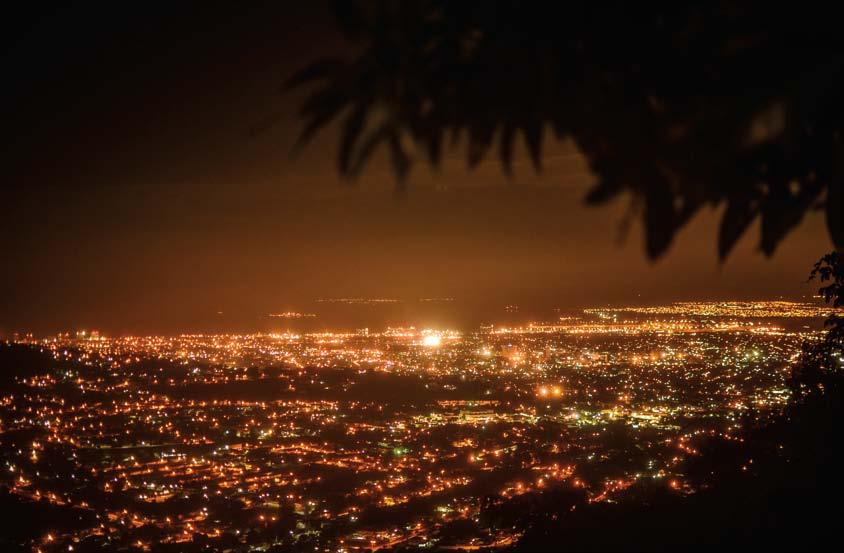
On any given Sunday night, when the Dub Club is in session, you are likely to find rising stars such as Exile Di Brave, Micah Shemaiah, and Infinite, reasoning with each other, hanging out with fans on the terrace, or taking turns on the microphone. Augustus Pablo’s son Addis is another regular fixture, along with his Trinidadian sparring partner, Ras Jammy, with whom he works collectively under the moniker Sons of Dub. Yaadcore, a Protoje acolyte and one of Kingston’s most stylistically superior DJs, might be a guest selector, or it could be someone from as far afield as Europe, Japan, or the united States. At another session staged last February at a friend’s waterside club in
Negril, Selassie supported reggae legend Lee “Scratch” Perry for another night of improvised dub wizardry.
For Selassie, the various strands explored at the Dub Club are all part of spreading roots reggae’s liberating messages, and keeping the Kingston Dub Club true to its principles. “Consistency is the key to growth,” he says. “I’m hoping and praying that we’ll have a long-lasting vibration, like the weekly dance held in Rae Town, which has been going for thirty years now. And actually I would love to see an equal and opposite situation to what’s happening now: you have ten thousand dancehall DJs, but I want to have ten thousand roots DJs too, with sound man, people that play it on the radio, and people who are producing — the whole spectrum.
“The movement is definitely growing right now,” he continues. “On Monday nights you have Inner City Dub in Tivoli Gardens, started by I-Nation. Wednesday night is Yaadcore’s night at Tiki Huts on Hope Road. There is also Vinyl Thursdays, and my brethren Supernova start a thing called Dub School Fridays in Vineyard Town. So we love what ah gwaan with the youths and the resurgence with the energy. Inna this recent couple of years, it has just been a togetherness.” n
founder gabre selassie notes that the Kingston Dub Club has always gone against the grain, ignoring the ubiquitous hardcore dancehall that has long captured the imagination of the Jamaican publicLooking down at the sprawling lights of Kingston from the Dub Club hilltop headquarters

A tree in drag!
Perennial monarch masquerading in red regalia. Royal Poinciana playing mas , shaking black shac-shac pods behind Papa Djab, teasing his fig-leaved followers.
Woy woy, mi djab-là!
Woy woy, mi pié-bwa!
Oh oh, look the devil!
Oh oh, look the tree!
Poinciana and Satan singing, showing their staffs in the streets. Two sceptres waving, two festive insignias vying for the carnival crown. Bet my cat’s eye, oxblood, and corkscrew marbles, Flamboyant pull off an upset this J’Ouvert.
Coming Up Hot, a new anthology from Peekash Press, features work by eight emerging Caribbean poets, an intriguing cross-section of voices and styles. The contributors include Trinidadian Danielle Boodoo-fortuné and St Lucian sassy Ross — both sampled here — alongside Jamaicans Danielle Jennings and Monica Minott, Vincentian

Debra Providence, Guyanese Ruel Johnson, and Shivanee Ramlochan and Colin Robinson of Trinidad and Tobago
They say you can teach yourself to breathe underwater here.
I’ve heard of women who could do it, hold their breaths till their veins burst their banks, flowed on until their hearts emptied in the sea.
I go down to the river each morning, unlace my skin, spread the twin nets of my lungs out against these rocks.
This is the same river I was born in, the one my grandmother gave birth in.
This is the same river that bursts, each decade, into a million lights and if you learn to breathe here, your body stays forever lit with the secret.
Guyana, land of many waters, the majestic Kaieteur Falls, and the vast plains of the Rupununi Savannah — these are just a few features of this beautiful country located in South America. Guyana is the only English-speaking country in South America, and is filled with many exciting adventures for visitors and tourists. There are also many secrets to discover in Guyana — among the best secrets to explore is Elaine Ville.
Elaine Ville, located at Providence, East Bank Demerara, is a unique housing development. With 150 acres of virgin land, it will be the Caribbean’s largest gated community. With a family atmosphere and great environment, it is the ideal place to retire, relax, or own a vacation home.
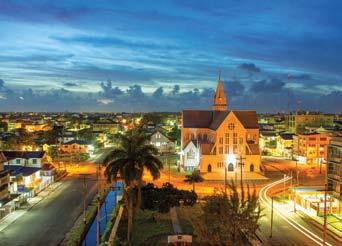

Come explore the magnificence of our rich biodiversity and cultural heritage. Elaine Ville is a paradise in the making, located just outside Georgetown but yet close to the Garden City. This all-inclusive community will be equipped with concrete roads and drains, permanent solar street lights, a modern secured entrance with a televised monitoring system, and cable-ready facilities. This high-end community provides twenty-four-hour security for you and your family.
Strategically located thirty minutes away from both international airports, Elaine Ville is also one minute away from the Providence Police Station, a gas sta-
tion, the Guyana National Stadium, a four-star hotel, and less than ten minutes away from the Diamond Regional Hospital.
Elaine Ville amenities will include a swimming pool, a clubhouse, and a tennis court, with seven luxurious model houses to choose from. Combining classic and contemporary architecture, each model boasts a unique artistic flair and exquisite décor to satisfy your needs. If there’s a style that doesn’t suit you, no problem — you can buy a house lot and build your dream home. It’s your chance to live in paradise!
Visit our website, www.elaineville. com, or look for the Elaine Ville Housing Development on Facebook

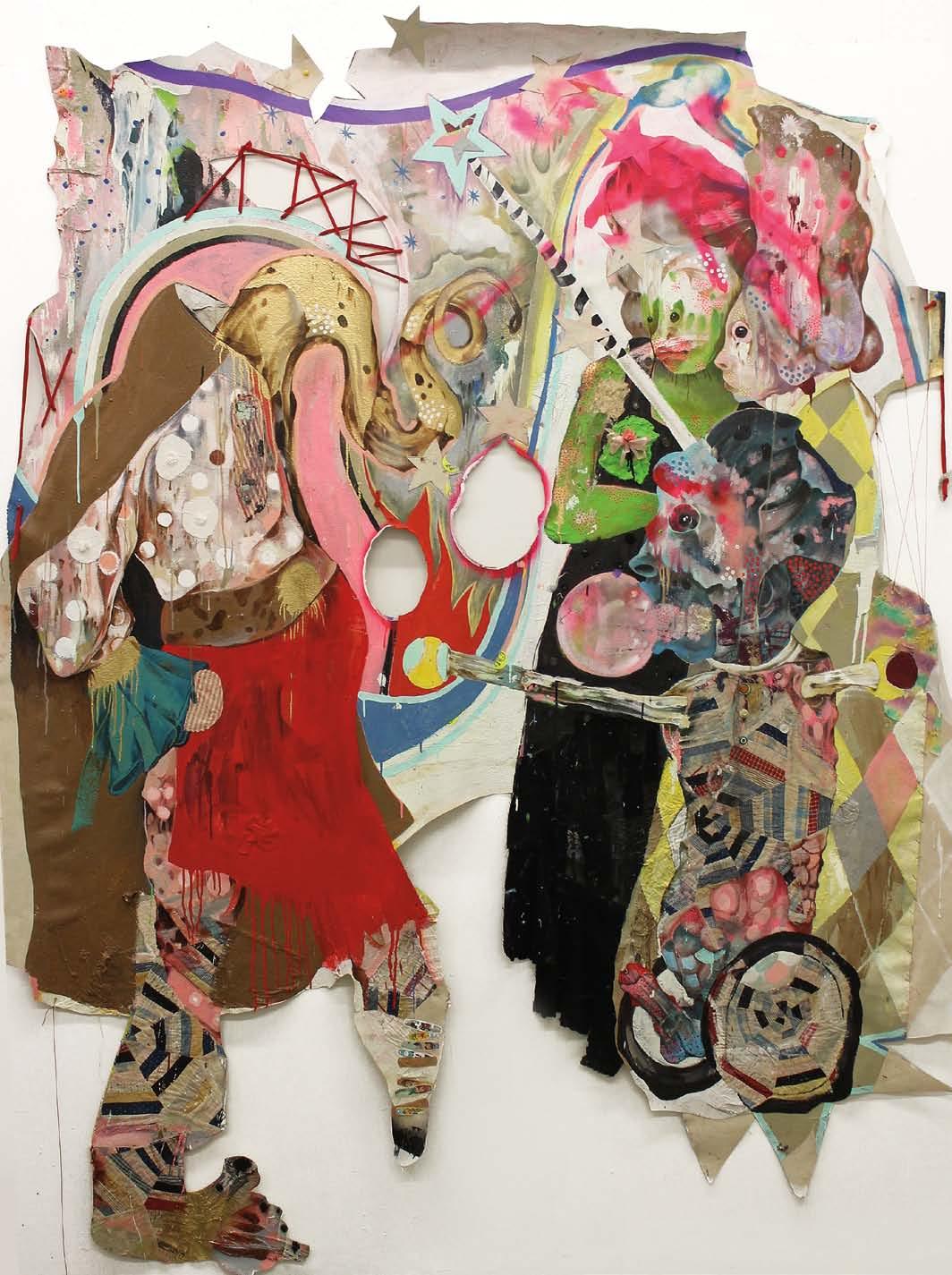
In the weeks leading up to the opening of the Venice Biennale on 9 May, the inboxes and newsfeeds of the international art world have been inundated with information. The world’s largest and oldest contemporary art exhibition is making unprecedented moves in its fifty-sixth edition, towards a more genuinely global contemporary art scene. In Nigerian-born curator Okwui Enwezor of Munich’s Haus der Kunst, “la Biennale” has found its first African artistic director. And the main exhibition, All the World’s Futures, is in keeping with Enwezor’s longstanding curatorial project, expanding contemporary art beyond its Euro-American comfort zone to include more African and diaspora art.
Eighty-eight of the 136 artists selected by Enwezor will be first-time Venice exhibitors, and according to the black arts and culture magazine Culture Type more than a quarter of the artists are African or of African descent. There’s also a record number of national pavilions this year, increasing from 2013’s seventy-seven to eighty-nine.
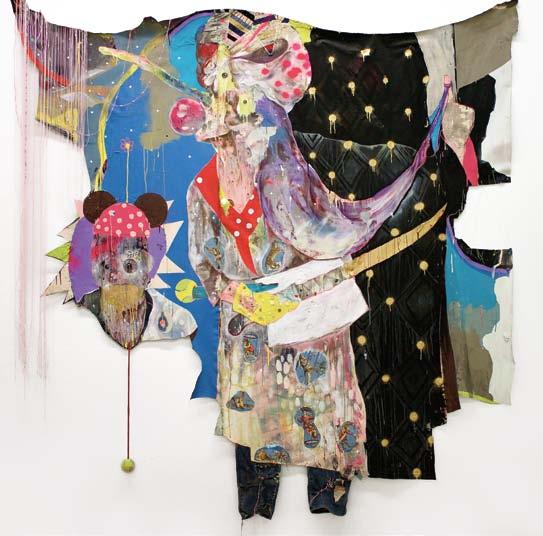
The Caribbean is taking a piece of the pie, with Grenada presenting its first unofficial national pavilion, and the inclusion of Bahamian artist Lavar Munroe in All the World’s Futures . It is not the first time a Caribbean artist will be included in the main exhibition (and several Caribbean nations have presented national pavilions over the decades), but the list is a very short one. Personally, I know only of Cuban Wifredo Lam in 1976.
Asked how he feels about participating in the Biennale, Munroe — currently based in North Carolina — is casual. “I don’t get excited too easily,” he says. “I’m happy to be
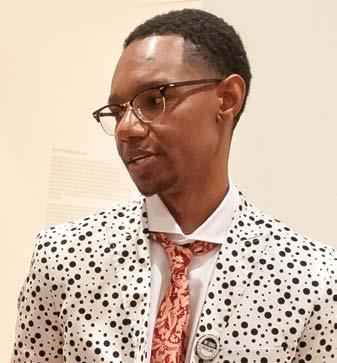
When the 2015 Venice Biennale opens in May, Bahamian artist lavar Munroe will find himself and his paintings in the company of the international art world’s biggest movers and shakers. And although his mixed-media works are not “about the Caribbean,” as he tells Nicole SmytheJohnson, they explore slippery ideas of cultural and personal difference utterly characteristic of Munroe’s home regionopposite page Something Strange This Way Comes (2014), mixed media on cut canvas, 74 x 96 inches Above right Fairy Godmother (2014), mixed media on cut canvas, 98 x 102 inches Photography courtesy Lavar Munroe
a part of it, but I’m not head over heels. I think I’m more excited about being in Venice than being in the Venice Biennale.”
Three paintings from Munroe’s Mono-Myth and Human Zoo series will appear in the exhibition. These mixed media works offer few clues to their maker’s identity. Munroe himself thinks his work looks like a woman could have made it; and his almost decorative, meticulously layered images, sewn and cut surfaces, and bubble-gum palette could well read as feminine. His primary preoccupations — mythology, and more recently nineteenth- and early-twentieth-century freak shows — could link to the Caribbean and the racial politics that shaped the region, but Munroe’s focus is more deliberately universal.
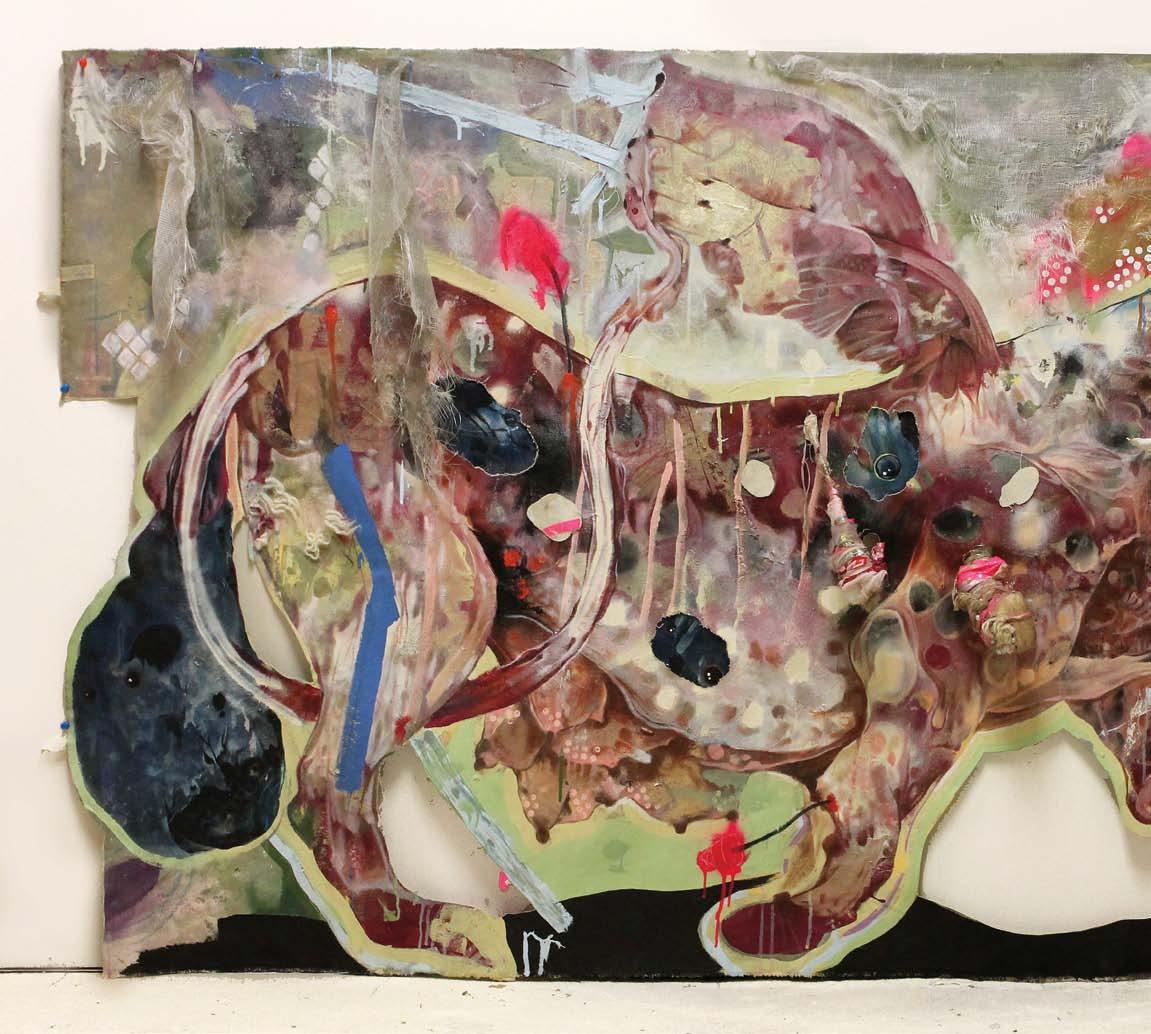
In fact, he insists on it. “My conversation is not about the Caribbean,” he says. It’s not that the Nassau-born and -raised artist denies his roots, or their impact on his artistic development.
He freely admits: “I’m a Bahamian first, definitely” — but always with the caveat that “the conversation isn’t from the Bahamas.”
Thinking of Munroe’s Human Zoo series, I ask him if he is thinking of the much-discussed case of Saartjie Baartman, also known as the Hottentot Venus — an African woman who was exhibited across Europe as a symbol of racial difference in the early nineteenth century. “That name brings with it the notion of the Human Zoo,” he responds, “but there were Native Americans and Asians and Africans and Alaskans — you could go on and on. It was not only Saartjie Baartman. It was pretty much the Europeans, the colonial empires of the time, collecting people from all over the world and showing the other. They were not just only black African people.”
Munroe’s references are equally diverse. “I’m looking at old stuff, ethnographic illustrations, freak show posters and
banners. I’m also looking at Attic Greek vases, and most recently silent films. With the silent films, I take screenshots, and I get these compositions that are really nice. So I use that as a starting point, but it’s not like I’m looking at a photograph and painting it. I’m more interested in the compositional strategies.”
He explains that his work seeks to evade expectations. “A lot of Caribbean and African-American artists, you expect them to do certain things,” he says. “I expect to see many flowers in work coming from the Caribbean, I expect to see AfricanAmerican artists painting something about slavery, or painting something with a black figure in it. Those things are very expected, and that’s something that I’ve always been anti: anti-expected.”
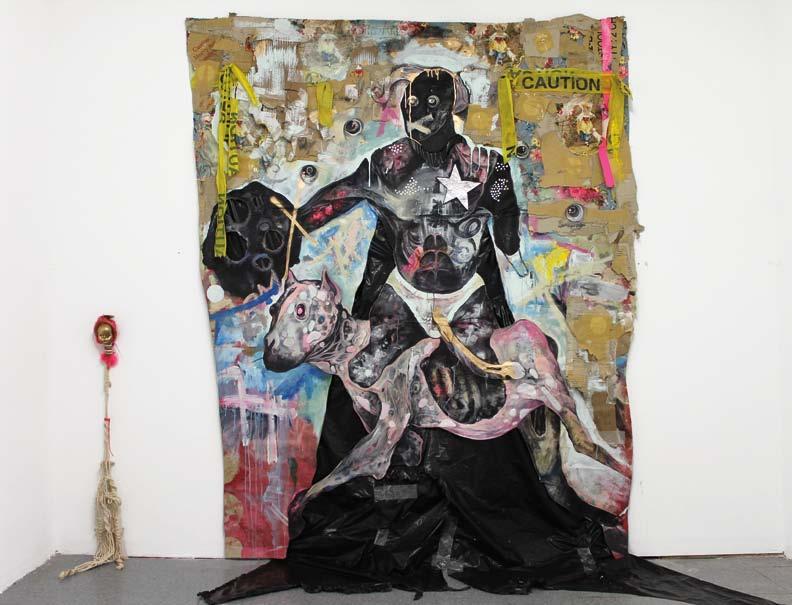
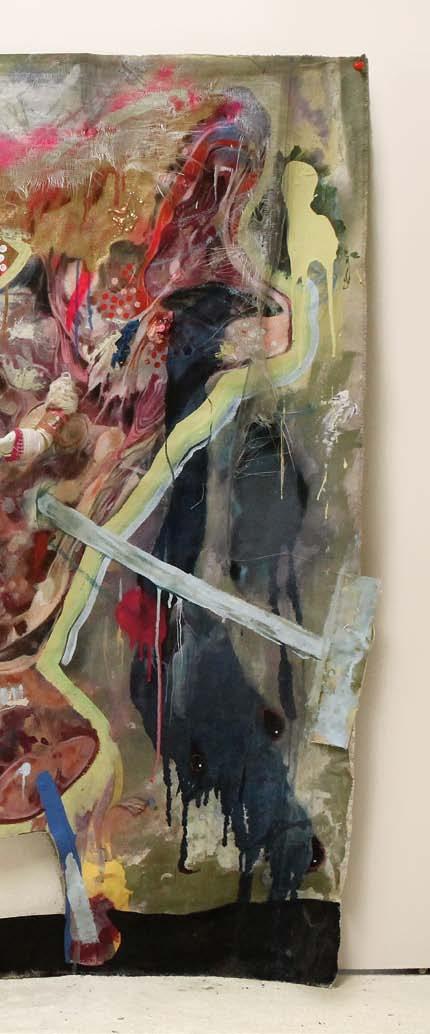
This evasiveness is connected to another key theme in Munroe’s practice, that of the artist as trickster. From Anansi in the Caribbean and West Africa to Coyote in the American Southwest and the Monkey King in China, the trickster is a cross-cultural mythological archetype. Munroe likes to maintain what he calls “the veil” between himself and his audience: “it’s not really hiding my identity, but I would like — and it happens — a situation where my work is on display and if you don’t know me, you don’t know where I’m from, you don’t know my gender, my race. That kind of thing really excites me.”
Trickster aside, the genesis of Munroe’s practice remains in his uncle’s Junkanoo shack in Nassau. “My uncle is an artist,” he explains. “Not the type of artist I am — he does sign-making and before that he was a designer, he had a Junkanoo shack. So growing up I was always in that space. I looked up to him, and I would watch him design and colour and cut paper and stuff. So it started that way, but from there I kind of grew on my own.”
“We dislike being a spectacle, but we like being voyeurs,” lavar Munroe says. “We like to see difference. We are curious about difference”Above On Deaf Ears (2013), mixed media on cut canvas, 46 x 72 inches Above right To Protect and Serve (2012), mixed media on cut canvas, 67 x 105 inches
His research-guided artistic practice also reflects those beginnings. “With [my uncle] and this Junkanoo thing, research was always a part of what they did. There were always books lying around. There were reading books, but they were mostly pictorial. And I would take those books and browse through them continuously, just to see the images. A lot of the things that they dealt with in [Junkanoo] were themes like Ancient Egypt, so the house would be full of books with Egyptian cave drawings, or about China . . . Either that or about the Bible, another kind of mythology. So that’s the type of thing I was exposed to,” he adds, “and when you’re exposed to something at a young age, it’s always there.”
Founded in 1895, and marking its 120th anniversary this year, the Venice Biennale is recognised internationally as the contemporary art world’s most prestigious event. Its formula — major curated exhibitions staged every other year, featuring both established stars and exciting up-andcomers — has been widely copied, but La Biennale di Venezia is both the original and the gold standard. Its headquarters, in a park near the eastern end of the insular city, includes permanent pavilions assigned to specific countries, and a central hall housing an exhibition curated by the Biennale’s artistic director. Over 300,000 visitors attend the event, which runs during the summer and autumn months (in 2015, from 9 May to 22 November). Hundreds of unofficial shows are staged across the city to coincide with the official Biennale.
In 2013, while pursuing an MFA degree at Washington university in St Louis, Missouri, Munroe returned to mythology, this time from the perspective of the American anthropologist Joseph Campbell, well known for his influential book The Hero with a Thousand Faces . Out of this reading came Munroe’s Mono-Myth , a body of work including sculpture, painting, drawing, and some performance. His latest body of work, The Human Zoo, develops the trajectory, looking at human difference, and the way difference itself is mythologised. “We dislike being a spectacle, but we like being voyeurs,” Munroe says. “We like to see difference. We are curious about difference, and a lot of difference, until you see it, it’s like a myth.”
Lavar Munroe is the second Bahamian artist featured at the Venice Biennale in recent years. In 2013, the Bahamas organised its first-ever national pavilion, with works by US-based Tavares Strachan.
Although I can’t think of a more Caribbean theme than difference, I must admit that in this increasingly globalised world, difference increasingly shapes even the most homogeneous societies. So maybe Munroe is right, and his conversation is not coming from the Caribbean — maybe it just comes through n

his evasiveness is connected to another key theme in lavar Munroe’s practice, that of the artist as tricksterExhibit (2015), mixed media on cut canvas, 91 x 110 inches
68 offtrack among the dragon’s mouths
76 neighbourhood holetown, barbados
78 home ground the magic mountain
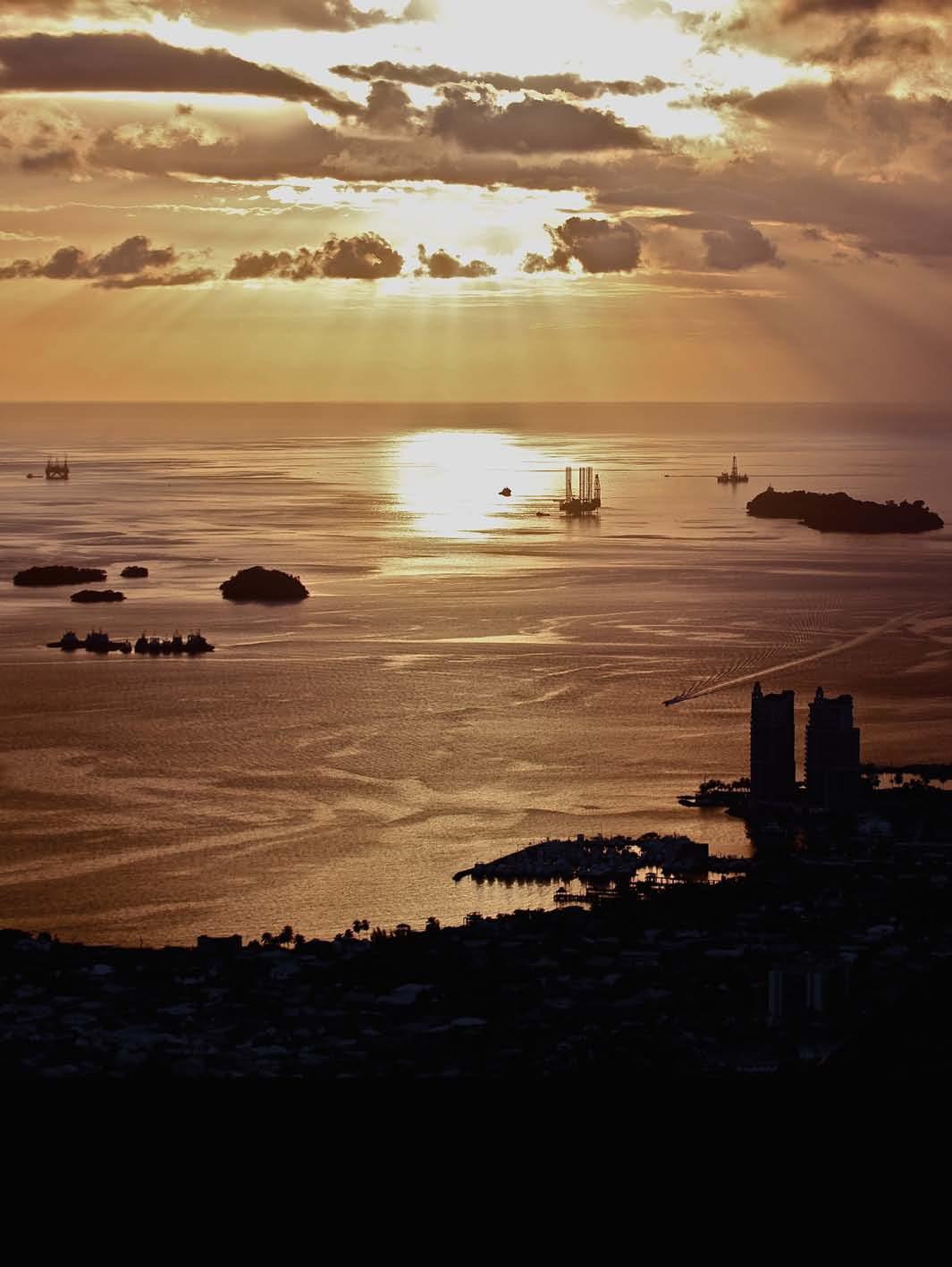 A sunset view along Trinidad’s north-west peninsula, with the Five Islands in the distance
A sunset view along Trinidad’s north-west peninsula, with the Five Islands in the distance

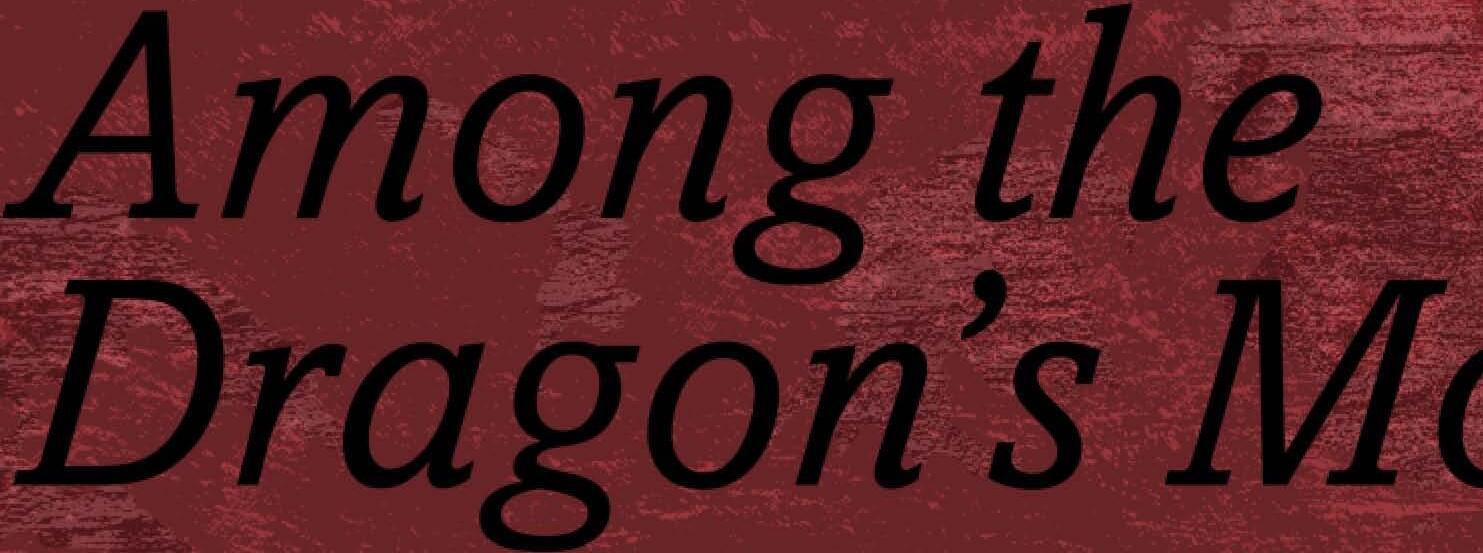

When trinidadians say “up the islands,” they mean the lesser Antilles. “Down the islands” always refers to the tiny rocky islets off trinidad’s north-western peninsula, scattered among the sea passages known for centuries as the Bocas — the Dragon’s Mouths. today, Sharon millar writes, these islands are known as holiday destinations, but their beautiful and sometimes eerie landscapes also conceal a rich and nearly forgotten history





If you drive west out of Port of Spain and head to the tip of north-west Trinidad, soon you will run parallel to the sea. This drive will take you through the fishing village of Carenage and the fish vendors doing a brisk trade in fresh catch at the side of the road. Before long, on your left, a small cluster of islands appears, close enough to be interesting, but far away enough that you cannot get a fix on what lies on these small humps of land.
The drive will continue past the Trinidad Yachting Association, with its moored yachts and lightly clanking

masts, past the Chaguaramas National Park’s newly installed boardwalk, and finally to the marinas stacked with pirogues and powerboats. At this point, you will be within the realm of the world collectively referred to by Trinidadians as “down the islands” — the string of islands that lie between Trinidad and Venezuela’s Paria Peninsula.
Many people would say that the true “down the islands” is life on Gasparee and Monos, the two islands closest to the mainland. They lie along the First Boca, that famed first exit to the Atlantic Ocean on Trinidad’s North Coast. Their proximity
to the mainland is reflected in the density of island houses, which dot the bays and bluffs of Gasparee and Monos. On public holidays, people make their way in droves to the water. Those without island houses or cottages camp in Scotland Bay, or on rocky promontories on the southern end of Gasparee, to pitch a tent, fish, and “make a cook.” But going “down the islands” means much more than a vacation destination. It also refers to a way of life with a long history of whaling, cotton farming, and fishing. Sadly, there is no longer a large resident population on these small islands. The Tardieu clan is an exception to this rule, and a growing number of them have stayed true to their “down the islands” heritage, living and working on Monos up to today.
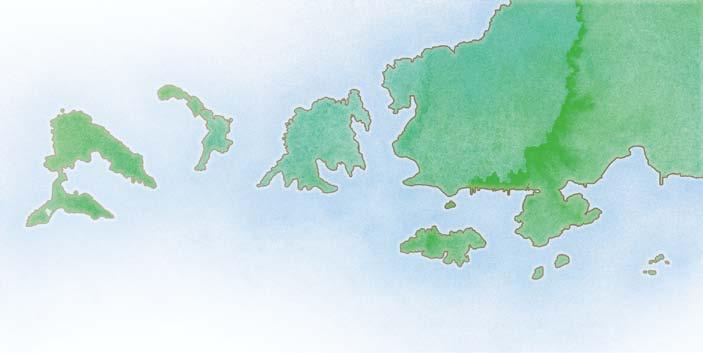
Limestone Gasparee is the easiest of the islands to access from the mainland. Dry and dramatic (with less than forty inches of annual rainfall), Gasparee is full of tales and legends of whaling and fishing that have been passed down orally over the centuries. Nowadays it may be best known for its spectacular caves, found near the island’s western end, Point Baleine, where the caves open to dramatic stalagmites and stalactites and a small pool. As children, we often visited

tuesday 27 August, 1963
Went fishing off Chacachacare. I caught a Jack. Cedric red fish, Pat a shark, and Ashton 2 fish.
saturday 31 August, 1963 (afternoon)
Went fishing in the Bocas. A very strong current was running. I caught a cavalli [sic] trolling. About 5 lbs. Returned to bay about 7.00 pm.
the caves unsupervised (it is now necessary to go with a guide), spending many an hour jumping from a high rock into the pool below, and catching the water dripping from the giant stalagmites.
Emerging at the Point Baleine exit, it’s hard to imagine that this spot was once an active whaling station. Whaling was, for a brief time in the mid nineteenth century, an active operation on the Bocas islands, started by the Joelle family who brought their Bermudian whaling experience to Trinidad, but the key players were the Tardieus. The three recognised whaling stations were at Point Baleine, Copper Hole (on Monos), and La Pecheury (on Chacachacare).
Its rocky limestone also makes Gasparee a perfect home for the infamous Bocas centipede, frequently encountered on the island. Anyone who has come upon one of the creatures (and I have!) knows they’re not for the faint of heart. They can be heard clattering their way through the undergrowth before they appear, with lengths of up to an alarming twelve inches, and a painful venomous bite. “The fangs on a real giant can be almost an inch long,” writes historian Anthony de Verteuil in his Western Islands of Trinidad, and the wound is delivered by way of “slashing scimitar pincers which are really fangs . . . conceivably the venom is capable of killing a small child.”
From the western tip of Gasparee, and along the northern sheltered side, there are excellent views of the First Boca. With its legendary large rock, Madame Teteron’s Tooth, the First Boca is a place of lore and also still a rich vein of fishing. It is still possible to catch (but not often!) its famed giant groupers. From Gasparee, Monos swims into view to the west of the First Boca. A gentle hilled island, with a history of cotton farming and fishing, Monos has sheltered coves and small beaches that make it ideal for swimming. In March and April, when the Gulf of Paria is full of red sardines, pods of dolphins will often follow your boat home, frolicking off the front bow. It is also not impossible to see the occasional pilot whale or even a false killer whale. Electricity from the mainland only goes as far as Monos, and this boundary is also marked, quite dramatically, by the wide and often-choppy Second Boca. From this juncture, the terrain becomes even more stunning, wild, and untouched. Then the Third Boca, separating Huevos from Chacachacare, suddenly pulls Venezuela into sight.
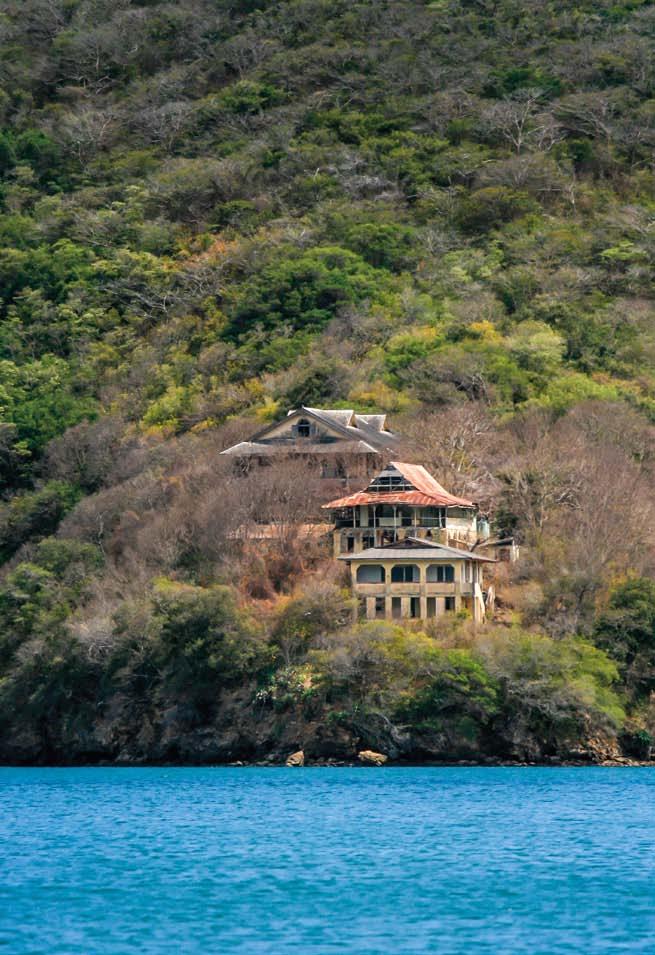
Despite the remaining ruins being aggressively overtaken by vegetation, exploring Chacachacare unearths eerie remnants. said to be haunted, the island has been the focus of at least one paranormal investigation
Chacachacare is the site of an abandoned leper colony, which closed its doors in 1984. Seen today, the island has the air of an abandoned village, and it’s hard to imagine that it was once a (mostly) self-sufficient community with roads, hospitals, a jail, sporting grounds, homes, a cinema, and at least one church (all run on electricity generators). Then the discovery of an antibiotic cure for Hansen’s disease made the colony unnecessary, after which, from what was left behind, it would seem that everyone departed the island on the first boat, in a hurry.
Despite the remaining ruins being aggressively overtaken by vegetation, exploring Chacachacare unearths eerie remnants such as patients’ records, decades-old medicine bottles, furniture, and overgrown roads. It is both a fascinating and a disturbing place. Said to be haunted, the island has been the focus of at least one paranormal investigation. Legend goes
that a young nun, often seen in the old convent building, was in love with a fisherman, and upon becoming pregnant ended her own life. Stories aside, not enough can be said about the tireless service and sacrifice that was given by the Dominican sisters who looked after the patients of the old leprosarium. A visit to the nuns’ cemetery is a sobering reminder of how many young nuns came from France, Poland, and mainland Trinidad to provide the service of their lives. They now lie, largely unremembered, at the end of a lane behind the old nunnery.
Prior to its incarnation as a leper colony, this was a thriving cotton-producing island. “From 1807, Chacachacare was home to the three families Carry, Marino, and Sanders,” writes de Verteuil. The Marino family were tireless in their support of the Venezuelan Republicans in their battle for liberty against the Spanish Royalists. A daughter of the family, Maria de la

Concepción, is still regarded as a national hero of Venezuela, and her portrait hangs in the National Capitol in Caracas. It’s not hard to grasp, when the Venezuelan hills loom into sight, that Trinidad is, in fact, an orphaned South American island.
With all this talk of revolution and battles, it would be remiss not to give some history of the Five Islands. Remember those rocky outcrops first spotted off Carenage village on the drive out of Port of Spain? They are collectively referred to as “five,” though there are six of them: Nelson, Lenagan, Rock, Pelican, Caledonia, and Craig. Both the Spanish and the French called them “The Parakeets,” and despite their isolated appearance, an abundance of history happened here.
Between 1866 and 1917, de Verteuil records, approximately 114,000 East Indian immigrants were processed on Nelson
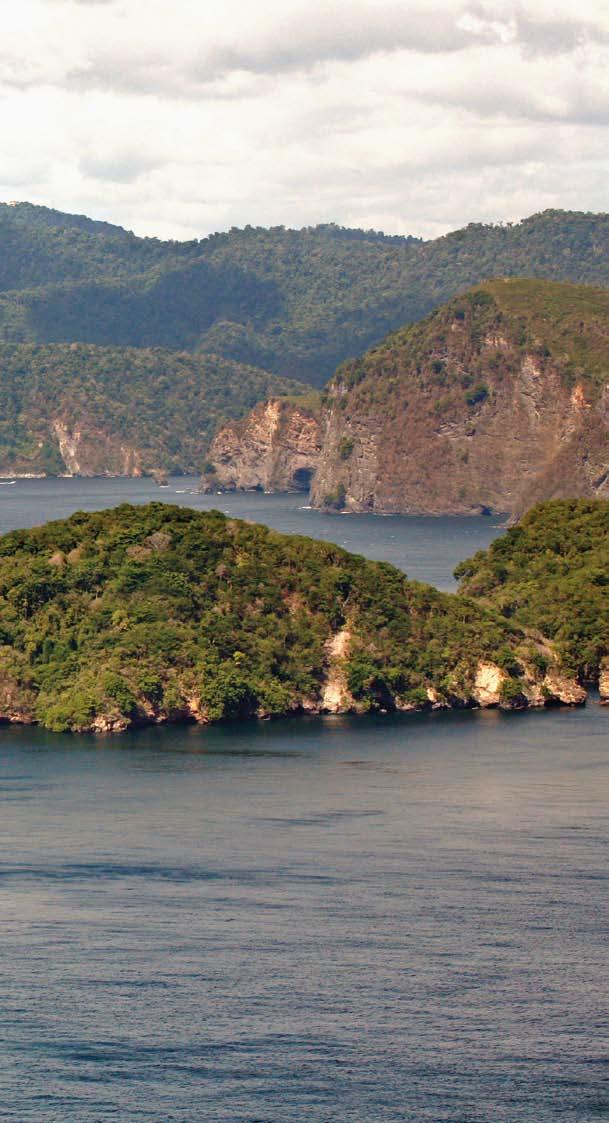
Island — Trinidad’s own Ellis Island of sorts. At the beginning of the Second World War, the island’s role as a holding bay was resurrected. All persons holding German or Austrian passports were kept on Nelson Island “at His Majesty’s Pleasure,” while a detention centre was constructed in Port of Spain. Labour leader Tubal uriah “Buzz” Butler, then considered a threat to state security, was also confined to Nelson Island for the duration of the war. The island was used again for similar purposes in 1970, when Black Power activists were detained there for several months. Twenty years on, after Trinidad and Tobago’s 1990 attempted coup d’état, the buildings were renovated in preparation to resume their habitual duty — but, as it turned out, the insurgents were never held on the island. But not far on the horizon, the Five Islands look out towards nearby Carrerra Island, its sleepy appearance an excellent camouflage for its role as an active prison.
Centuries ago, the narrow, deep, churning sea passages connecting the Atlantic Ocean and the Gulf of Paria, between Trinidad and Venezuela, were named the Bocas del Dragon — the Dragon’s Mouths. Geologically, they are drowned valleys, and the small islands scattered among them are ancient hilltops. The Bocas Islands, heading west from Trinidad, are Gasparee (also called Gaspar Grande), Centipede Island (named for its most respected wildlife), Monos (Spanish for the howler monkeys who still inhabit its upper heights), Huevos (“The Eggs”), and Chacachacare, home of an abandoned leprosarium. The Fourth Boca separates Chacachacare from Patos, belonging to Venezuela, and then the Paria Peninsula of the South American mainland.
Closer to Trinidad, the Diego Islands, Carrera and Cronstadt, are considered a separate group, and even further along are the six Five Islands — the apparent miscounting may be thanks to the man-made causeway that links Craig and Caledonia.
Of these “western isles,” Gasparee is the most accessible for casual visitors, thanks to the Gasparee Caves, popular with tourists and school groups. The Chaguaramas Development Authority, responsible for administering the whole of Trinidad’s north-western peninsula, arranges regular tours.
My grandfather built two houses on Gasparee before I was born. He built them with the help of his boatman, Ashton, who lived a short distance away with his wife and some livestock. The houses sat on the bluff above the bay. Behind my grandfather’s little cottage was a barrier of scrubby trees that blocked our view of the Roman Catholic chapel. Every Saturday afternoon, we would make our way through the wild path of trees to go to church.
My mother was an only child, and my grandfather built a larger cottage for himself and my grandmother and a smaller one on the edge of the water for my mother and father, on land that was his only by way of a long lease. The houses were built of wooden planks with simple wire windows, painted in the green and white that characterised many oilfield-camp homes — because my grandparents were from San Fernando, and had only recently moved to Port of Spain.
Some weekends I went down alone with my grandparents while my parents stayed in town. I had pride of place as the first grandchild, and even though I was very young, I have vivid
memories of this particular time of my life. I remember the English woman who lived on the side of the bay and cooked eels for her dogs. Our own Labrador we had to contain in my grandparents’ bedroom when the priests went to swim, because the valiant creature would plunge into the water behind them and tow them vigorously back to shore, blessed elbow held firmly in his mouth, convinced he was saving them from the awful fate of drowning. The priests would send a delegate before they headed down to the bay to politely ask that we contain Buster for the duration of their swim. We travelled with the dogs, the Siamese cat, my baby sister, sheets, clothes, towels, food, ice, and all ensuing excitement that an entourage such as this generates on a small powerboat.
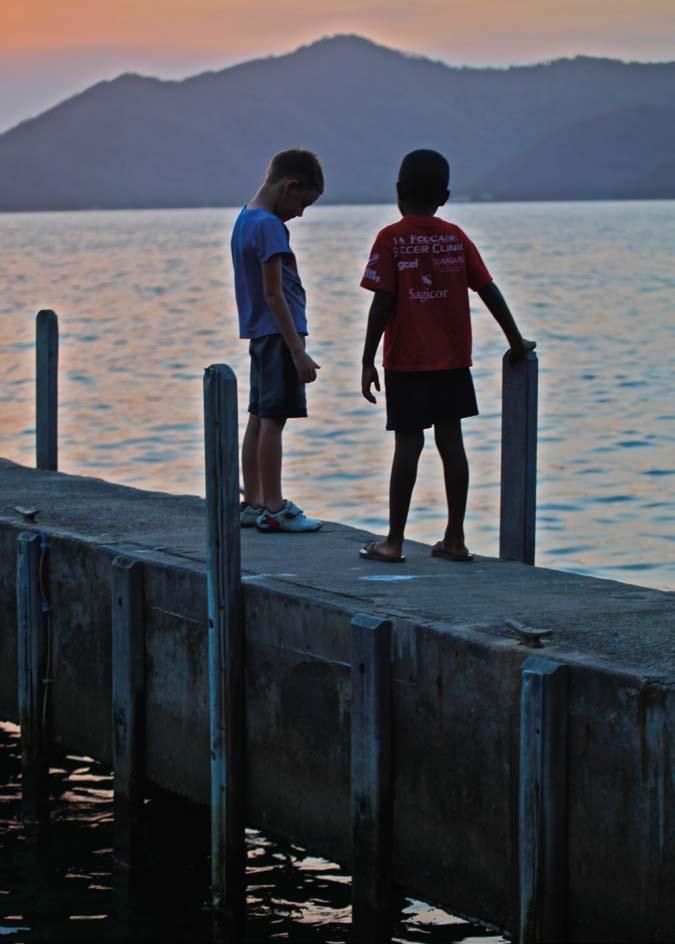
I was only five when my grandfather died, and my grandmother gave up the lease and the houses soon after. Ashton and my mother were the only ones who could drive my grandfather’s boat, and it became too hard and too painful to revisit. Not that this stopped us from visiting others’ homes — going “down the islands” has been a constant in my life up to today. I visited for a weekend last March, and the boatman who helped us tie up the boat told us the dolphins had been in the bay just days before, frolicking between the mooring and the jetty. It is their season in March. “Plenty red sardine in the water now,” he said. “You bound to see them.”
All around us in Turtle Bay the water was deep and green, the chill blowing off the water. The foreigners ask if we know we have paradise here. Yes, we answer, we know we do. n
Caribbean Airlines operates regular flights to Piarco International Airport in Trinidad from destinations across the Caribbean, North America, and the UK
going “down the islands” means much more than a vacation destination. it also refers to a way of life with a long history of whaling, cotton farming, and fishingSTEPHEN BROADBRIDGE Sunset on a Gasparee jetty, with a view of Monos

Barbados’s oldest town wears its history lightly, with a handful of historic structures sprinkled among modern shops and houses, and hotels and holiday apartments along the beach. Glimpses of the blue Caribbean Sea are never far away. When evening falls, First Street and Second Street are Holetown’s nightlife zone, lined with trendy restaurants and bars.
The oldest settlement in Barbados — dating back to 1627 — Holetown sits halfway up the island’s posh west coast, and combines a rich history with a prime beachside vantage, and some of Barbados’s best eating and shopping

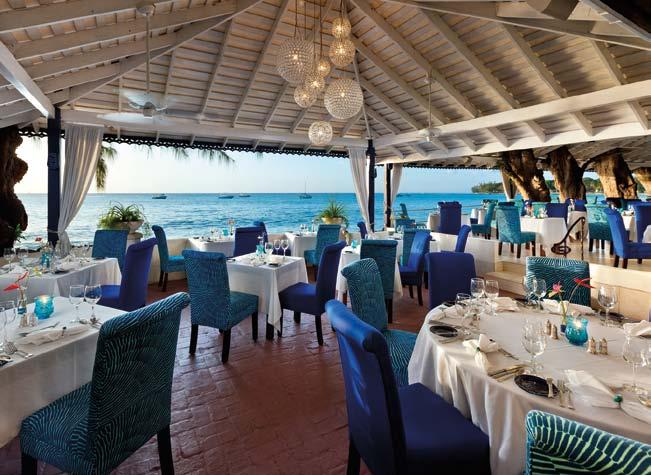
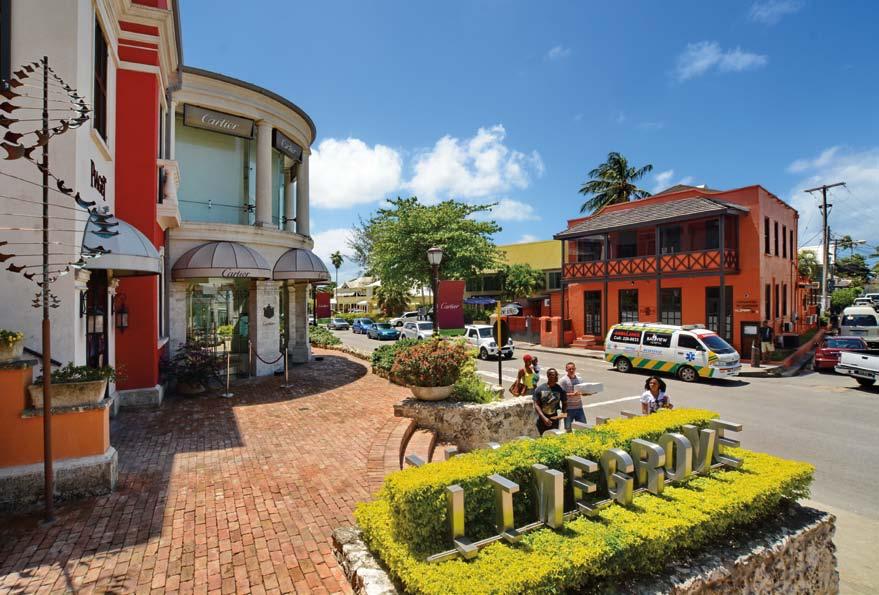
The shops at Chattel Village are similar to ones you’ll find across Barbados, with all manner of crafty souvenirs, colourful t-shirts, and locally produced ceramics and prints. What sets this shopping centre apart is its design: a series of pastel-painted cottages, in traditional Bajan chattel-house style, surrounded by lush gardens.
The nearby Limegrove Lifestyle Centre has a decidedly luxurious air, and if you’re suffering from Louis Vuitton or Ralph Lauren or Michael Kors withdrawal, you’ll find your fix right here.
First Street and Second Street are home to some of Barbados’s most popular upscale restaurants, but you’ll also find options to suit shallower pockets, and culinary styles ranging from Euro-Creole (The Mews) to classic Indian (Sitar) to sushi (Nishi). Patisserie Flindt is renowned across Barbados for its pastries and cakes. Establishments like Cocomos and Sea Cat offer fresh seafood in a laid-back atmosphere. South of the centre of town, The Tides is one of the highest-rated restaurants on the island — and the best tables in the house have amazing sea views.
The original St James Parish Church was built in 1628, of wood, and replaced by a stone structure fifty years later. Having weathered centuries of hurricanes and sea-blast, the church was enlarged in 1874, and meticulously restored in the 1980s. Still an active parish church, the building is a link to the island’s earliest settlers.
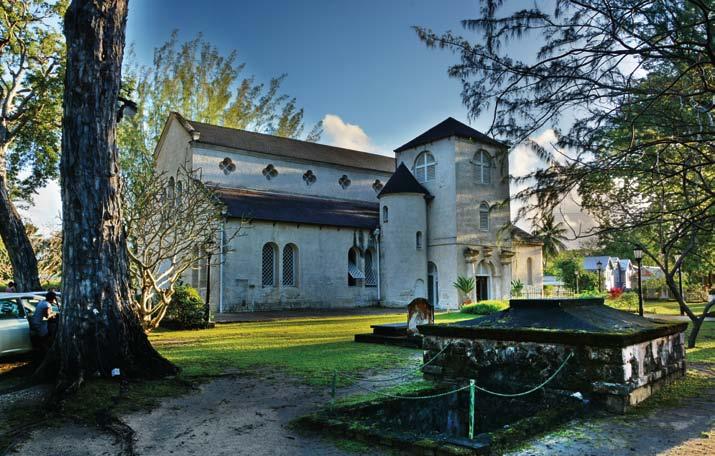
During most of the St James Church’s lifespan, sugar was the major industry in Barbados. The Sir Frank Hutson Sugar Machinery Museum, located inland and east of Holetown, houses an ample collection of tools, machines, and other artifacts of the sugarcane fields and sugar factories, some dating back to the eighteenth century. A jar of molasses from the museum shop makes an appropriate memento.
Originally called Jamestown, after King James I of England, the Holetown settlement was eventually renamed after The Hole, a stream which created a small but sheltered landing place for boats where it met the sea. Traces of the town’s original moniker survive in the names of St James Parish and St James Church.

The Holetown Monument is an obelisk-shaped reminder of the first English landing in Barbados, in 1625 — even though the monument itself erroneously lists the event as happening twenty years earlier. The annual Holetown Festival, a weeklong programme of cultural events in February, commemorates the founding of the town. Look out for the costumed street parade, complete with tuk band, and the nighttime police tattoo.
Ready to explore the ridiculously turquoise-tinted waters of the west coast? The Folkstone Park and Marine Reserve just outside Holetown includes an “inshore” reef suitable for beginning snorkelers, while experienced divers can head out to the wreck of the Stavronikita, sunk to create an artificial reef half a mile offshore in 120 feet of clear water. You can also rent kayaks, paddle boards, or go out in a glass-bottomed boat, if you prefer to stay dry while admiring the park’s marine life.
And total landlubbers can still enjoy sea views and sea breezes on the West Coast Boardwalk, which hugs the shoreline along Holetown — and is exactly the right spot for enjoying magnificent sunsets.
13.18º N 59.63ºW
Sea level
Holetown
BARBADos
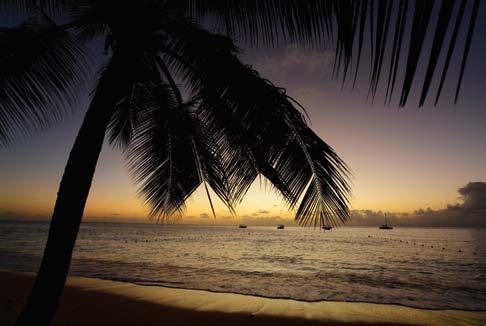
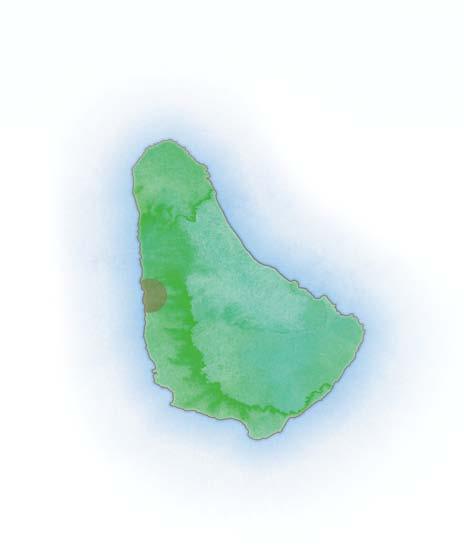
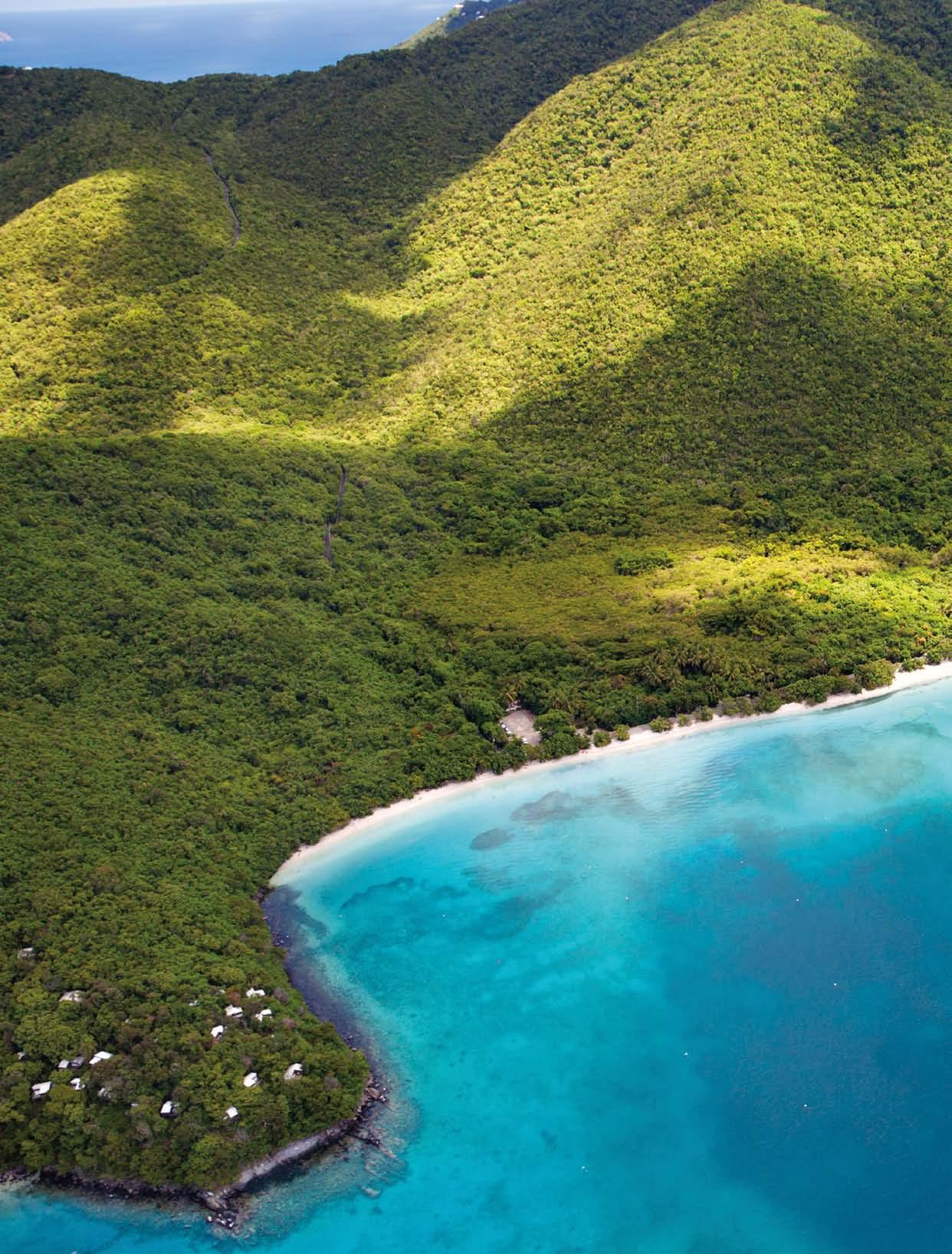
smallest of the three main us Virgin islands, st John is a magnet for wealthy tourists — sometimes called “the Beverly hills of the Caribbean.” But long before the posh resorts were built, st John was famous for its fragrant bay rum, and the scented bay trees of Bordeaux Mountain. David knight, Jr, remembers growing up on these lushly forested — and sometimes magical — slopes

When I was very young — too young to remember — I experienced a rite of passage common to Virgin Islands children: I was pinched by my first soldier crab. I am told that its brawny purple claw clamped down on my finger while I was playing in the garden around my mother’s house in St John.
I’m sure this pinching was deserved. Despite their name, soldier crabs are intractable pacifists. No other creature is tormented by island youth as relentlessly and as unfairly: gathered for fishing bait, forcibly recruited for “crab races,” and sometimes simply kicked around out of the pure dumb cruelty that can live in children.

For years after my first soldier crab encounter, I was cautious of their small tribes that lived beneath rotting logs or in the dark alcoves between rocks around my family property. The seedpods of the pitch-apple tree, common around the gardens, also became suspect, due to their crab-like appearance. Pitch-apples, which are about the size of an adult soldier crab, unfold into stars once they fall to the ground, the points of which I imagined to be spiny legs. I was convinced through much of my childhood that these seedpods were really soldier crabs in a disguised form, waiting to come alive.
I mention this because the subtropical forest of Bordeaux Mountain, the summit of St John, on which I was raised, is the sort of environment that can encourage these mysterious connections in a young imagination. My afternoons spent playing around Bordeaux’s deep-rutted dirt road were filled with not just the potential shape-shifting of seedpod-crabs, but also magic of a more immediate sort.
There were weeds called “sensitive plants” (known elsewhere as “sleepy plants”) which folded their leaves at the slightest touch. “Old Man Stinkin’ Toe” seedpods, which could be cracked open to reveal a sweet-tasting yellow powder that nevertheless smelled like dirty laundry, littered the ground. up the road from my mother’s house, near an old water catchment that had not been
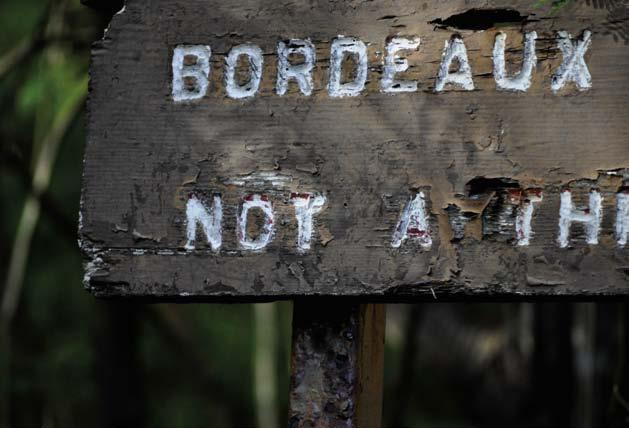
used for decades, fragments of Taino-made pottery frequently rose to the surface and mixed with the ground scatter of rusted car parts, confusing my idea of history. My family’s closest neighbour, Mr Richardson from Anguilla, was a semi-nomadic gardener who, until he simply disappeared one day, wandered the mountain naming its various knolls and hidden pockets — “Spice Hill,” “Richie’s Garden of Eden” — as if he were the first man.
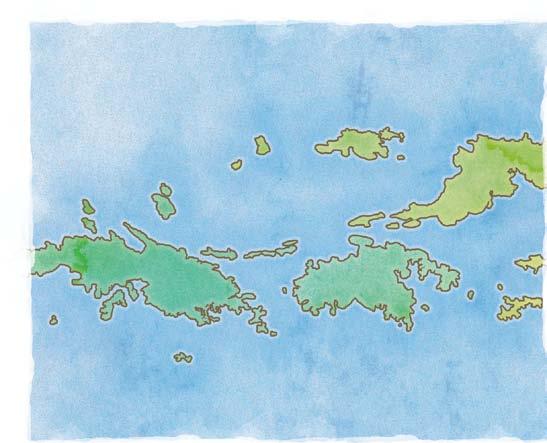
And always amid all of this there was the heavy smell of bay leaves, which for me was most responsible for Bordeaux’s magic, and the scent that, to this day, I most associate with the idea of “home.”
The bay trees that thrive in the rich soil of Bordeaux’s high ridges and perfume its slopes once provided St John with its primary industry: bay rum. It has always seemed fitting to me that the leading export of my mountain neighbourhood was at one time its scent, a bottling of its essence.

From the late nineteenth century to around the Second World War, bay rum was a popular aftershave balm and cologne in the united States, South America, and Europe. The quiet rural island of St John, and particularly Bordeaux Mountain, where a particularly sweet-smelling variety of bay tree inexplicably flourishes, were known during this time for the quality of their bay rum. After the collapse of the sugar industry and before the advent of tourism as an economic model a century later, bay leaves, which had long been used locally for medicinal purposes, were the only reliable export from the smallest of the three main uS Virgin Islands (formerly the Danish West Indies). The tight-knit familial community that lived on Bordeaux Mountain among those sweet-smelling leaves was employed in their harvest.
Despite St John’s image in today’s uS media as a place of leisure, no economic enterprise that has thrived on the tiny fifty-square-kilometre island has ever provided an easy living for its local population, who have long been known in the Virgin Islands for the virtues of independence and selfreliance. During the reign of the bay leaf, pickers earned eight cents per bag of leaves, which typically weighed between sixty and seventy-five pounds. Harvests only took place three times a year, and many times it was children, who could climb the
the Peak of Bordeaux Mountain is less a place of solitude than it was in my youth, not to mention the times of earlier generations. But Bordeaux still might, in many ways, strike visitors as a peculiar place
tallest of the mature trees, who did the picking. Today the old Creole word for the bay tree, “caneel” (or wild cinnamon), is shared by the beach where American tycoon and philanthropist Laurance Rockefeller established the island’s first resort, which has wedded the name in the minds of many to ideas of luxury and relaxation. But the caneel tree, for many St Johnians of the last century, meant industry.
By the time I was born in the 1980s, the days of bay leaf harvesting on Bordeaux Mountain were long over. I recall little being said about it. The mechanisms of social change on St John, as elsewhere in the Caribbean, often leave us with a certain kind of amnesia. In a photograph taken by my grandfather George in 1936, published originally in the Virgin Islands Daily News, men in pith helmets, looking very much like spectres of the past, stand near the E.W. Marsh bay rum distillery in Coral Bay on the last day of its operation. As a visitor to the island at the time, my grandfather was impressed with the process of bay rum distillation. In a remembrance compiled in Ruth Low’s book St John Backtime, he wrote playfully of the industry’s troubles during the American period of Prohibition, which had ended just three years prior.
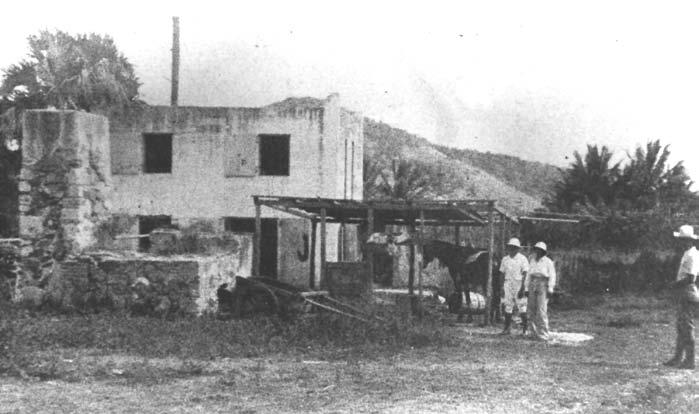
“Prohibition even left its mark on this industry,” he wrote. “It seems that grain alcohol is the principal solvent in bay rum, but the bay oil was too easily removed by distillation. A permit then became necessary to purchase bay rum. To my mind it should have stimulated sales — having a hairwash and the necessary ingredients for a cocktail in one product.”
Like my grandfather, and also my father, I still use bay rum as an aftershave, although the brand I buy is made from leaves harvested in the bush of Dominica rather than my own neighbourhood. The Peak of Bordeaux Mountain is less a place of solitude than it was in my youth, not to mention the times of earlier generations; its inexact dirt road turned concrete years ago as the neighborhood grew with St John’s population boom. But Bordeaux still may, in many ways, strike visitors as a peculiar place.
“The Gold Hole,” a deep wound in the top of the mountain where an American mining company once tested for precious metals, still inspires stories of pirates. An eccentric citizen has recently taken to parking his collection of funeral hearses near an intersection, raising the ire of neighbours. Black “gungalo” millipedes, who can dye human skin purple, still curl themselves into spirals on the mottled bark of the bay trees. Some of Mr Richardson’s place names still survive in common usage on the mountain, although few people remember his lush elevated gardens.
Bordeaux’s current residents are not dependent on the bay trees for subsistence, although families who live near the top of the mountain still fill their dresser drawers and closets with dried bay leaves to combat the smell of mildew, that scourge of damp environments. Visiting hikers on the mountain can still freely pick the shiny, leathery leaves to take with them, or simply stop to rest and take in their pleasant aroma. Bay trees still provide Bordeaux Mountain with another sensory stamp in addition to its overwhelmingingly green ridges and cool winter breezes.
As for me, I am no longer suspicious of soldier crabs, but I am still guilty of tormenting them. When I visit my mother on Bordeaux, I gather them for bait and walk the few miles down the old Lameshur Road out to St John’s rocky southern shore. There the sea yields up a small royal court: Spanish hogfish in their regal purple and gold, the beautiful queen triggerfish or “Ole Wife,” whose coarse scaleless skin can be used as sandpaper, and that slow-moving jester the trunkfish.
On a good day, I carry my fish back up the mountain breathing in the thick ambrosial smell of bay leaves that once crossed oceans in small bottles and drifted from the bathroom cabinets of the world’s busier places. To me, it is simply the smell of the earth, of aging roots, of star-shaped seedpods on red clay that might yet come alive if I don’t keep them under close watch. n
Caribbean Airlines operates regular flights to Sint Maarten’s Princess Juliana International Airport, with connections to the US Virgin Islands
today the old Creole word for the bay tree, “caneel,” is shared by the beach where American tycoon lauranceThe author’s grandfather, visiting a St John bay rum distillery in 1936

private pilot’s license, was pursuing an undergraduate degree in mechanical engineering at Howard university when coverage of the Challenger space shuttle tragedy drew her to the field of space exploration. She put her degree emphasis on aerospace. Later, she led teams that designed and tested equipment for NASA’s man-in-space programmes. “I have been front and centre of the most ground-breaking, pioneering work in human space flight,” she says.
In July 1969, when three-yearold Trinidadian Camille Wardrop watched astronaut Neil Armstrong take mankind’s first lumbering steps on the Moon, the idea that she would eventually contribute to the ongoing effort to explore space would have seemed as unlikely as the Moon landing did two decades before it happened.
But a little more than twenty years after that momentous space mission, Wardrop found herself stepping through the doors of NASA’s John F. Kennedy Space Centre in Florida as a spacecraft engineer. Fourteen years after that, she came close to actually going into space, when she was shortlisted in NASA’s astronaut selection programme. And today, as assistant programme scientist with the International Space Station, she’s one of the public faces and voices of NASA, communicating information about the station — which human beings have been inhabiting since 2000 — to government officials, schools, and television audiences.
She’s come a long way since that day in 1969. “I didn’t have a clue what was going on,” she says with a laugh during a recent phone interview, talking about watching Armstrong all those years ago. Becoming a space scientist was so far away from possibility that she can’t even say she was discouraged from aspiring to it. “Nobody knew what that was. I didn’t know what that was,” says Wardrop, whose married name is Wardrop Alleyne.
Luckily, she was a naturally curious child, with an affinity for math and science, and a personality that relished taking the unbeaten path. Probably even more important, she had open-minded and supportive parents who pushed her to explore. “I was very good at building things, fixing things,” Wardrop Alleyne recalls. “My mom really encouraged that. When something broke around the house, she wasn’t calling dad to fix it — she was calling me, and I would take things apart and put them back together and get them working.”
Wardrop Alleyne, who developed an interest in airplanes and has a
She also speaks with pride about appearing on NASA TV talking about the International Space Station, which carries a multinational crew who conduct a variety of scientific experiments in an environment with very little gravity. “I think I was the first woman of colour to get that opportunity — that was incredible,” she says.
But lately Wardrop Alleyne has taken on another challenge, possibly even bigger than propelling human beings into space. She wants to guide young people — particularly girls — from poorer countries into science, technology, engineering, and math, areas of research and study which are collectively called STEM. Women are still drastically underrepresented in these fields. The ultimate goal of the Brightest Stars Foundation, which Wardrop Alleyne founded in 2007, is to set up science academies for girls in Africa, the Caribbean, and Latin America. For now, Wardrop Alleyne is travelling the world with her message.
She was in Trinidad in 2011 to give a keynote address at the tenth annual Caribbean Youth Science Forum, and she arranged for twelve Form Six students from different countries in the region to speak briefly with astronauts aboard the International Space Station, through an amateur radio transmission. The
Around the world, the fields of science and technology are still often dominated by men — and the Caribbean is no exception. But trinidadian Camille Wardrop Alleyne — a senior scientist at nAsA — is working to change that. erline Andrews finds out about her efforts to get more young people, especially girls, into these cutting-edge technical fieldsPhotograph courtesy Camille Wardrop Alleyne
teenage girls and boys posed a range of questions, from the possibility of life on other planets to daily activities aboard the space station. In her speech, Wardrop Alleyne told students she doesn’t think a Caribbean Space Agency is farfetched. “What I know for sure is that you are the generation that can make that vision a reality,” she said then.
Trinidad and Tobago’s National Institute of Higher Education, Research, Science, and Technology (NIHERST), which organised the science forum, has made Wardrop Alleyne one of its “Caribbean Icons in Science, Technology, and Innovation.” Joycelyn Lee Young, NIHERST’s registrar, explains why a figure like Wardrop Alleyne was important for the region. “She could
inspire persons from humble families to excel,” says Lee Young. “She’s a good role model, and she emphasises that our education system is a good platform on which to build.”
More recently, the Association of Female Executives of Trinidad and Tobago invited Wardrop Alleyne back to the country to give the keynote address at their Women of Influence Award ceremony in March 2015. The event commemorated International Women’s Day. Women of all ages, including secondary school students, were in the audience. “ In the highly technical fields of science and engineering, where women are in the minority, she has achieved against all odds, being one of a few women of colour and the only
woman of Caribbean descent in a senior management position at NASA,” said AFETT president Nassema Ali.
Wardrop Alleyne went to an all-girls secondary school herself, and believes it was beneficial. “Science and engineering are traditionally subjects that boys gravitated to, or boys were encouraged to study,” she says. “It was felt that girls do not have the aptitude to do those kinds of subjects. But when you’re in an all-girls school, [rather than] a coeducational environment, you have no choice.
“You can do physics, you can do computer science, because those courses are offered, and there’s nobody there telling you you can’t,” she explains.
So Wardrop Alleyne never made it into space, but she’s rocketed past boundaries of a different kind, and is helping others to do the same. “For me, that’s my mission,” she says. “Inspiring and empowering young women, especially to know that there’s no limit to what you can achieve if you put your mind to it, work hard on it, and believe in yourself.” n

Camille Wardrop Alleyne was a naturally curious child, with an affinity for math and science, and a personality that relished taking the unbeaten path. Probably even more important, she had open-minded and supportive parents who pushed her to explore
fifty years ago, Martin luther King, Jr, arrived in Jamaica on a speaking tour, where he entranced audiences with his powerful rhetoric. But, as James Ferguson writes, newly independent Jamaica made almost as strong an impression on the great Civil Rights hero
When Martin Luther King, Jr, arrived at Jamaica’s Palisadoes Airport fifty years ago, on 20 June, 1965, he was at the peak of his fame. Born in 1929 in Atlanta, the charismatic Baptist preacher had become the face — and the voice — of the African-American Civil Rights Movement. Active in the 1955 Montgomery bus boycott and antisegregation protests in other southern states, he had achieved something akin to superstar status among African-Americans and liberal supporters with the 1963 March on Washington, where he delivered the immortal speech “I Have a Dream”.
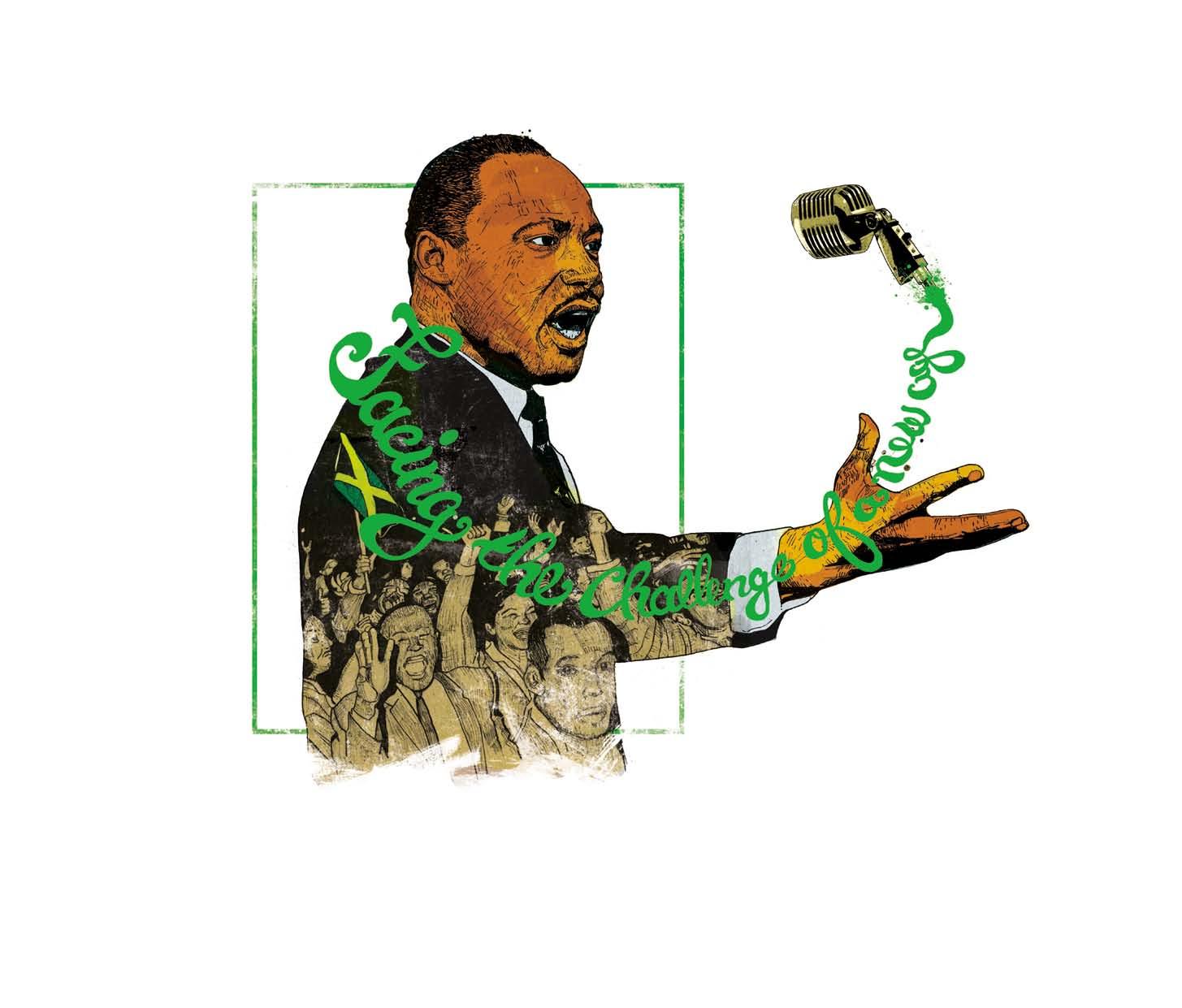
As a superb orator, his speeches and sermons mingling radical new ideas with the traditions of Southern Baptist preaching, his reputation spread outside the united States, and into the political ferment of the 1960s Caribbean, where independence and an end to racial oppression were high on the agenda. The award of the Nobel Peace Prize to King in October 1964 and the dramatic Selma-to-Montgomery marches — demonstrations in favour of equal voting rights — seemed to symbolise a new era across the English-speaking Americas.
King’s arrival in Jamaica understandably sparked off enormous excitement. It was not an “official” visit — acting Prime Minister Hugh Shearer was away in London for a Commonwealth summit — but was in fact
arranged by the university of the West Indies, which had asked King to deliver the annual valedictory sermon for graduating students.
So it was that several hundred graduates — plus an unspecified number of unofficial admirers — crammed into u WI’s Assembly Hall to hear the sermon. Remembering the event in the Jamaica Gleaner, Professor Patrick Bryan remarked, “It was an incredible experience to hear so strong and commanding a speaker, it was as if you were entranced when listening to him . . . He used no notes and talked without a hitch.” The sermon was entitled “Facing the Challenge of a New Age”, and one passage — when King urged his audience to excel in whatever field was theirs — is rightly famous:
If it falls to our luck to be street-sweepers, sweep the streets like Raphael painted pictures, like Michelangelo carved marble, like Shakespeare wrote poetry, and like Beethoven composed music. Sweep the streets so well that all the hosts of heaven and earth would have to pause and say, “Here lived a great street sweeper.”
The next day King addressed a huge audience at Jamaica’s National Stadium, where he was awarded the keys to the City of Kingston. A photo taken that day shows the main stand at the stadium packed with young Jamaicans. King’s tone was warm and personal. He said he had never felt more at home anywhere in the world: “In Jamaica I feel like a human being.” This theme of identity and belonging was reiterated when King laid a wreath at the tomb of Jamaican National Hero Marcus Garvey, who had, he said, given AfricanAmericans a “sense of personhood, a sense of manhood, a sense of somebodiness.”
The official part of the visit over, King and his wife Coretta were free to tour the island and to relax. What is striking, as King recalled in a speech of 4 July, is the profound impact Jamaica — and Jamaicans — had upon him. He may have captivated his audiences with his powerful oratory, but he was also captivated by what he saw as a multiracial, non-hierarchical nation of many disparate groups:
The other day Mrs King and I spent about ten days down in Jamaica . . . I always love to go to that great island which I consider the most beautiful island in all the world. The government prevailed upon us to be their guests and spend some time and try to get a little rest while there on the speaking tour. And so for those days we travelled all over Jamaica. And over and over again I was impressed
by one thing. Here you have people from many national backgrounds: Chinese, Indians, so-called Negroes, and you can just go down the line, Europeans, and people from many, many nations. Do you know they all live there and they have a motto in Jamaica, “Out of many people, one people.” And they say, “Here in Jamaica we are not Chinese, we are not Japanese, we are not Indians, we are not Negroes, we are not Englishmen, we are not Canadians. But we are all one big family of Jamaicans.” One day, here in America, I hope that we will see this and we will become one big family of Americans.
King’s compelling vision may have downplayed some of the more obvious inequalities in 1960s Jamaica, but here — in contrast to the southern states of the uS — was a place where racism was not institutionalised, where independence promised social progress and a healing of historic wounds. King’s association with Jamaica did not end there. In January and February 1967, he, Coretta, and two more friends rented an isolated house near Ocho Rios, on the island’s scenic north coast. With the spectre of the Vietnam War increasingly hanging over him, King needed to escape to think and to write a book fittingly entitled Where Do We Go From Here: Chaos or Community? The absence of the couple’s four children and the seclusion of the property (there was no phone) seemingly had the desired effect, as the book, which called for economic redistribution and social reform, was finished to meet the publisher’s deadline. An edition of Ebony ran pictures of the Kings’ “tropic interlude,” complete with swimming pool and beach walks, but reported that the usually fastidious and smartly attired King “worked most of the time dressed in pyjamas, bathrobe and slippers . . . and often skipped a shave.”
It was to be the last such idyll. On 4 April, 1968, King was shot dead by James Earl Ray in Memphis, an act which abruptly silenced the pre-eminent spokesman of the American Civil Rights Movement. Coretta Scott King was to return to Jamaica later that year to accept the first Marcus Garvey Prize for Human Rights, presented on 10 December at the National Stadium by Prime Minister Shearer. According to the Baltimore Afro-American, Mrs King, “a resplendent figure, elegantly attired in a white ensemble accented by silver and gold beads and rhinestones,” told the seven-thousand-strong audience that her late husband’s “spirit is with us tonight. He had great affection for you as a people and was greatly inspired by your motto, ‘Out of Many, One People.’” n
Martin luther King may have captivated his Jamaican audiences with his powerful oratory, but he was also captivated by what he saw as a multiracial, nonhierarchical nation
Across
6 Ride to the stars? [12]
8 What lies below (the Earth’s crust) [6]
9 How many rivers in this Jamaican town? [8]
10 Spacewalker [7]
11 Not the cat in the hat, but Shakespeare’s cat in the . . . [5]
12 “Yikes!” [5]
14 Groups of musicians [5]
18 Daily sustenance [5]
20 Dividing fairly [9]
23 Ethiopian emperor [8]
24 Made a bullet-like sound [6]
25 Island beyond Trinidad’s Third Boca [12]
Down
1 Beaten-up [8]
2 Belittles [7]
3 Jarred and jangled [7]
4 After a mosquito encounter [5]
5 Flamed out [6]
6 Once a US retail giant [5]
7 Caught in a swampy rut [6]
13 Jamaica’s national hero [6]
15 Ears, to an ant [8]
there are eight differences between these two pictures. how many can you spot?
16 Haste [7]
17 Picturesque capital of St John [7]
19 Passion’s opposite [6]
21 Nephew’s sister [5]
22 Undergrad course for future head-shrinkers [5]
The angles of the cricket balls are different; players’ noses are different; one hat has extra stitching; there is extra stitching on one player’s right-hand glove; the cricket bat on the left has one extra stripe; one player’s trouser leg has an extra pattern and colour; the padding on the left leg is different; the colour of the hat has changed.
acting Bajan
Belafonte bun
Chaguaramas
diary
dub engineer flower
Folkstone
Garvey gas
Giraudel gravity hole
Hollywood hot sauce island
Jamestown MLK
NASA peninsula
reggae revival
multiracial run sand
Scotland Bay settlement
skyline St John star swim
tourists
Venice yard
c g b l s e c u a s t o h j s
s r u a n c t l a v i v e r e
e a d i j s o n g a r v e y t
n v m c e a t t o n s s r r t
o i i a s n n s l f i a w a l
t t s r r a i e i a a t n i e s y l i l a l l h r n l c d m
k r a t s o u o y w u d e a e
l e n l h k l g o k r o b b n
o g d u l l f t a e s i t a t f g y m y l s m n h o j t s y y a i w o e v e n i c e o g a a e o w m a l u s n i n e p s r o e a e n g i n e e r u a a d r j g i r a u d e l o g b n
Hard 9x9 sudoku puzzle
Easy 6x6 mini sudoku puzzle
by www.sudoku-puzzle.netfill the empty square with numbers from 1 to 9 so that each row, each column, and each 3x3 box contains all of the numbers from 1 to 9. for the mini sudoku use numbers from 1 to 6.
If the puzzle you want to do has already been filled in, just ask your flight attendant for a new copy of the magazine!
r j g i r a u d e l o g b n
o e a e n g i n e e r u a a
e o w m a l u s n i n e p s
t t s r r a i e i a a t n i e s y l i l a l l h r n l c d m k r a t s o u o y w u d e a e l e n l h k l g o k r o b b n o g d u l l f t a e s i t a t f g y m y l s m n h o j t s y y a i w o e v e n i c e o g a
c g b l s e c u a s t o h j s s r u a n c t l a v i v e r e e a d i j s o n g a r v e y t n v m c e a t t o n s s r r t o i i a s n n s l f i a w a l
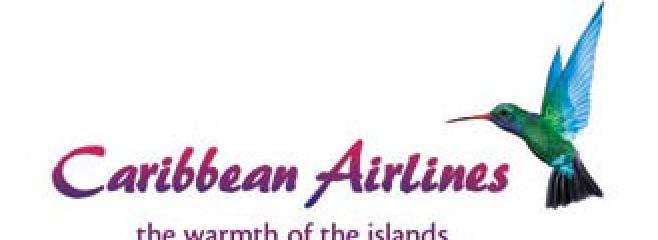
Incorporation date
27 September 2006
Website www.caribbean-airlines.com



Airline code BW

Fleet
15 Boeing 737-800
2 Boeing 767-300ER
5 ATR 72-600
On-time performance
88% (2015 year-to-date: 30 March)




Markets
Antigua (ANU)
Barbados (BGI)
Caracas, Venezuela (CCS)
Operational Launch
01 January 2007
Corporate headquarters
Iere House, Golden Grove Road, Piarco, Trinidad, West Indies + 868 669 3000
Reservations
+ 800 744 2225 (toll-free) + 868 625 7200 (Trinidad & Tobago)
Operational hub
Piarco International Airport, Trinidad, West Indies
Norman Manley International Airport, Jamaica (Air Jamaica brand)
New York, New York, USA (JFK)
Orlando, Florida, USA (MCO)
Paramaribo, Suriname (PBM)
Castries, St Lucia (SLU) St George’s, Grenada (GND)
Fort Lauderdale, Florida, USA (FLL) St Maarten (SXM)
Gatwick, London (LGW)
Georgetown, Guyana (GEO)
Kingston, Jamaica (KIN)
Miami, Florida, USA (MIA)
Montego Bay, Jamaica (MBJ)
Cargo & Parcel Service
Tobago (TAB)
Toronto, Canada (YYZ)
Trinidad (POS)
Nassau, Bahamas (NAS)
We have raised the standard of delivery with our complete Air and Ground Transportation Network. We offer you dedicated Freighter Services, frequent line flights and punctual interconnecting truck schedules. Our twice weekly freighter service on Tuesdays and Fridays, offer connections to North America and Caribbean Gateways, while our JetPak Service, is an Express Small Package Service that offers speedy and reliable Door to Door delivery of your urgent small shipments.
Loyalty programmes
Caribbean Miles, Club Caribbean and 7th Heaven Rewards
Trinidad Head Office
Airport: Piarco International
Reservations & information: + 868 625 7200 (local)
Ticket offices: Nicholas Towers, Independence Square, Port of Spain; Golden Grove Road, Piarco; Carlton Centre, San Fernando
Baggage: + 868 669 3000 Ext 7513/4

Antigua
Airport: VC Bird International

Reservations & information: + 800 744 2225 (toll free)
Ticketing: VC Bird International Airport
Hours: Mon – Fri 8 am – 4 pm
Baggage: + 268-480-5705 Tues, Thurs, Fri, Sun, or + 268 462 0528 Mon, Wed, Sat.
Hours: Mon – Fri 4 am – 10 pm
Barbados
Airport: Grantley Adams International
Reservations & information:
+ 800 744 2225 (toll free)
Ticket office: Sunjet House, Independence Square, Fairchild Street, Bridgetown
Baggage: + 246 428 1650 and 426 428 1651
Grenada
Airport: Maurice Bishop International
Reservations & Information:
1 800 744 2225 (toll free)
Ticketing: Maurice Bishop International Main
Terminal
Baggage: + 473 439 0681
Jamaica (Kingston)
Airport: Norman Manley International
Reservations & information: + 800 523 5585 (International)
1 888 359 2475 (Local)


Ticket office: Trafalgar Road, Kingston 5
Baggage: + 876 924 8500
Jamaica (Montego Bay)
Airport: Sangster International
Reservations & information: + 800 744 2225 (toll free)
Ticketing at check-in counter:
8.30 am – 6 pm daily
Baggage: + 876 363 6433
Nassau
Airport: Lynden Pindling International
Terminal: Concourse 2
Reservations & information: + 1 242 377 3300 (local)
Airport Ticket Office: Terminal A-East Departure
Hours: Flight days – Sat, Mon, Thurs 10 am – 4 pm
Non-flight days – Tues, Wed, Fri 10 am – 4 pm
Flight Information: + 1 242 377 3300 (local)




Baggage: + 1 242 377 7035 Ext 255
9 am – 5 pm daily
St Maarten
Airport: Princess Juliana International
Reservations & information:
+ 1721 546 7660/7661 (local)
Ticket office: PJIA Departure Concourse
Baggage: + 1721 546 7660/3
Hours: Mon – Fri 9 am – 5 pm / Sat
9 am – 6 pm
St Lucia
Airport: George F L Charles
Reservations & information: 1 800 744 2225
Ticket office: George F.L. Charles Airport
Ticket office hours: 10 am – 4 pm
Baggage contact number: 1 758 452 2789 or 1 758 451 7269
Tobago
Airport: ANR Robinson International
Reservations & information:
+ 868 660 7200 (local)
Ticket office: ANR Robinson International
Airport
Baggage: + 639 0595 / 631 8023
Flight informatio n: + 868 669 3000
Fort Lauderdale

Airport: Hollywood Fort Lauderdale
International Reservations & information:
+ 800 920 4225 (toll free)
Ticketing: Terminal 4 – departures level (during flight check-in ONLY – 7 am to 6 pm)
Baggage: + 954 359 4487
Miami
Airport: Miami International
Reservations & information: + 800 920 4225 (toll free)
Ticketing: South Terminal J – departures level (during flight check-in ONLY – 11.30 am to 3.00 pm);
Baggage: + 305 869 3795
Orlando
Airport: Orlando International
Reservations & information:
+ 800 920 4225 (toll free)
Ticketing: Terminal A – departures level (during flight check-in ONLY – Mon/Fri 10:30 am – 1.30 pm Tue/Thur 12.30 pm – 3.30 pm)
Baggage: + 407 825 3482
New York
Airport: John F Kennedy International Reservations & information:
+ 800 920 4225 (toll free)
Ticketing: Concourse B, Terminal 4, JFK International – open 24 hours (situated at departures, 4th floor)
Baggage: + 718 360 8930
Toronto
Airport: Lester B Pearson International Reservations & information:



+ 800 920 4225 (toll free)
Ticket office: Terminal 3
Ticketing available daily at check-in counters 422 and 423. Available 3 hours prior to departure times
Baggage: + 905 672 9991
Caracas
Airport: Simón Bolívar International
Reservations & information: + 58 212 3552880
Ticketing: Simón Bolívar International Level 2 – East Sector
Hours: 7am – 11pm
City Ticket Office: Sabana Grande Boulevard, Building “Galerias Bolivar”, 1st Floor, office 11-A, Caracas, Distrito Capital + 58 212 762 4389 / 762 0231
Guyana
Ticket office: 91-92 Avenue of the Republic, Georgetown
Baggage: + 011 592 261 2202
Suriname
Airport: Johan Adolf Pengel International Reservations & information:


+ 597 52 0034/0035 (local) 1 868 625 6200 (Trinidad)
Baggage: + 597 325 437
London Airport: London Gatwick Airport
Reservations & information: + 44 870 774 7336
Ticketing: Skybreak Desk Zone D in North Terminal
Hours: 4 am – 9 pm daily
Baggage: + 44 (0)772 542 2892

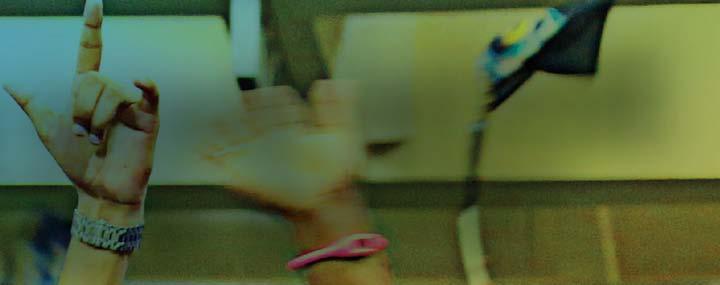








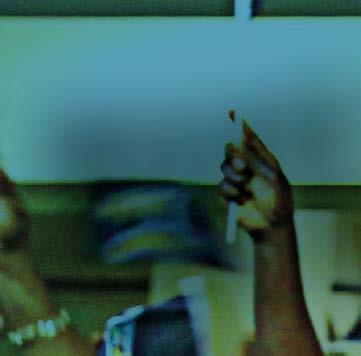




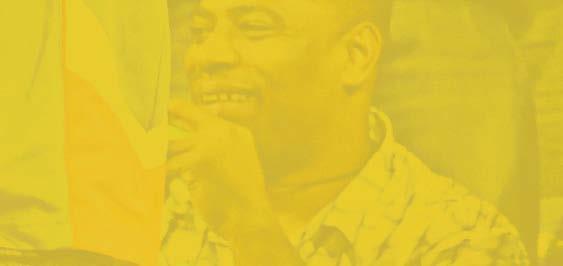
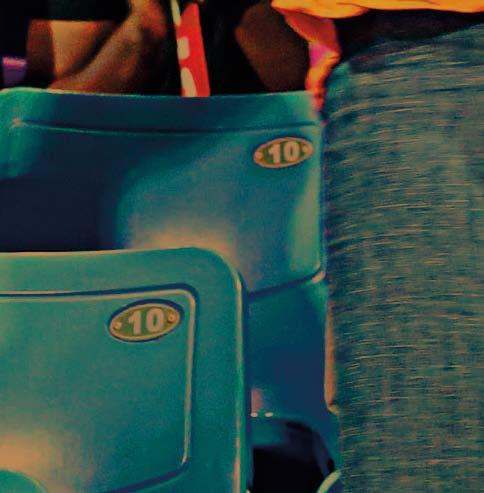
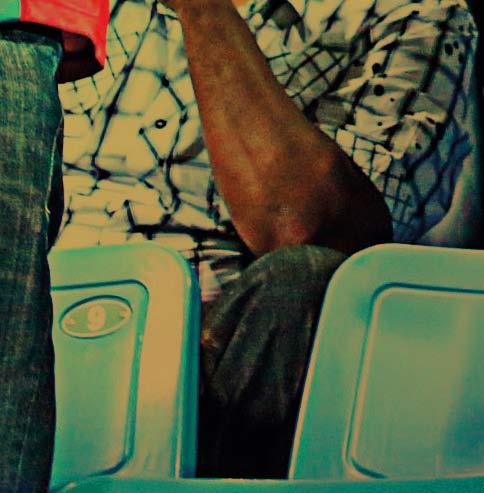




Caribbean Airlines has introduced a second movie on flights of four hours and over, thus providing continuous entertainment to you, our valued customer.
When orphan Annie is taken in by hard-nosed New York mayoral candidate Mr Stacks, he thinks he is doing her a favour. But it might be the other way around!
Jamie Foxx, Quvenzhané Wallis, Rose Byrne • Director: Will Gluck • drama, musical • PG • 118 minutes
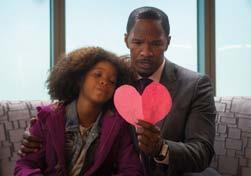

After witnessing a mysterious train crash, a group of friends start to notice a series of unusual disappearances and inexplicable events in their small Ohio town.
Kyle Chandler, Amanda Michalka, Elle Fanning • Director: J.J. Abrams • thriller, sci-fi • PG-13 • 112 minutes
night at the museum: secret of the tomb
Larry spans the globe, uniting favourite and new characters while embarking on an epic quest to save the magic before it is gone forever.
Ben Stiller, Robin Williams, Owen Wilson •Director: Shawn Levy • comedy, fantasy • PG • 96 minutes


James Bond’s loyalty to M is tested when her past comes back to haunt her. As MI6 comes under attack, 007 must track down and destroy the threat.
Daniel Craig, Judi Dench, Javier Bardem • Director: Sam Mendes • action • PG-13 • 120 minutes
cinderella disney’s beloved animated masterpiece re-imagined in a dazzling spectacle for a whole new generation.
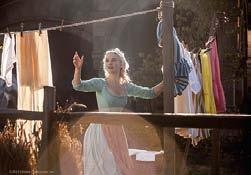
Cate Blanchett, Lily James, Helena Bonham Carter • Director: Kenneth Branagh • family, fantasy • PG • 105 minutes

When Pat meets Tiffany — a mysterious girl who offers to help him reconnect with his wife — an unexpected bond begins to form between them.
Bradley Cooper, Jennifer Lawrence, Robert De Niro • Director: David O. Russell • comedy, romance • R • 122 minutes
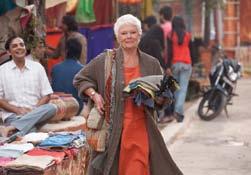
Sonny has his eye on a promising property, now that his first venture, The Best Exotic Marigold hotel for the Elderly and Beautiful, has only a single remaining vacancy.
Judi Dench, Maggie Smith, Bill Nighy • Director: John Madden • comedy, drama • PG • 124 minutes
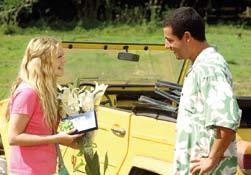
Marine biologist henry Roth finds the perfect woman, Lucy Whitmore, and falls head over heels for her. But when he sees her the following day, she hasn’t a clue who he is.
Adam Sandler, Drew Barrymore • Director: Peter Segal • comedy • PG-13 • 97 minutes
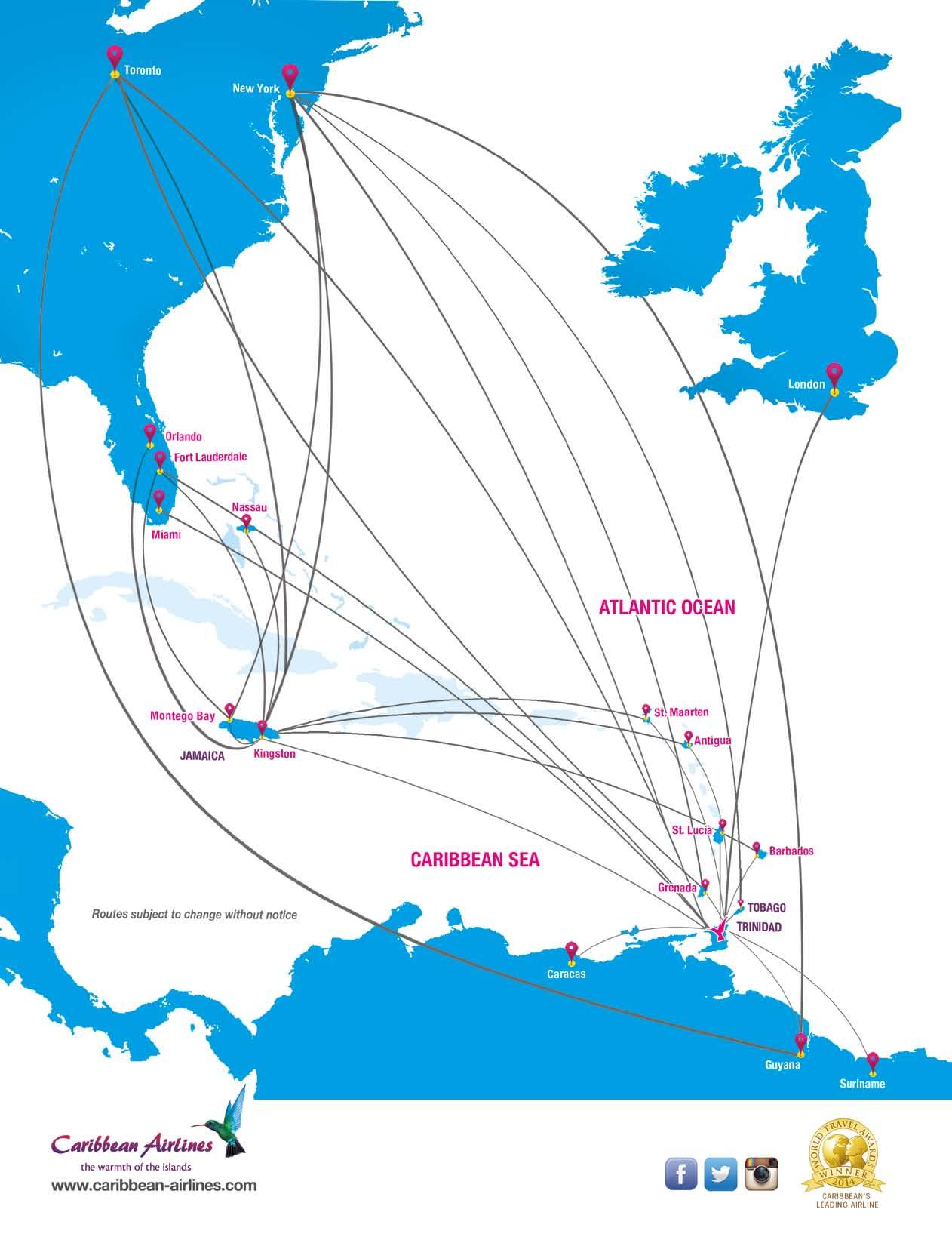
Near the northern tip of Eleuthera in the Bahamas, Glass Window Bridge is a narrow isthmus separating the deep blue Atlantic Ocean from the sheltered waters of the Great Bahama Bank. The road traversing this dramatic stretch of rock has been washed away by hurricanes and repaired several times — and can be as treacherous in stormy weather as it is magical when the seas are calm.
